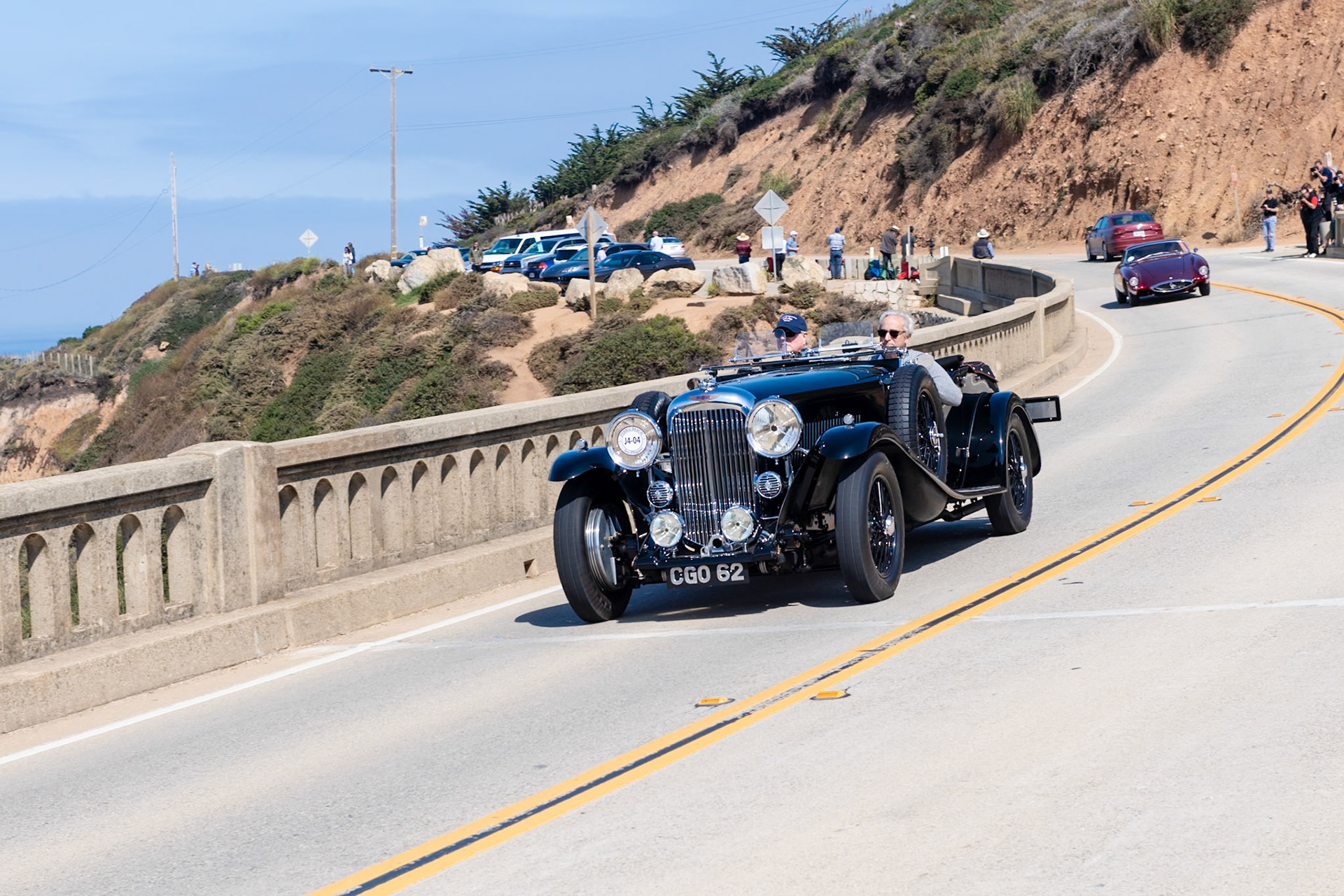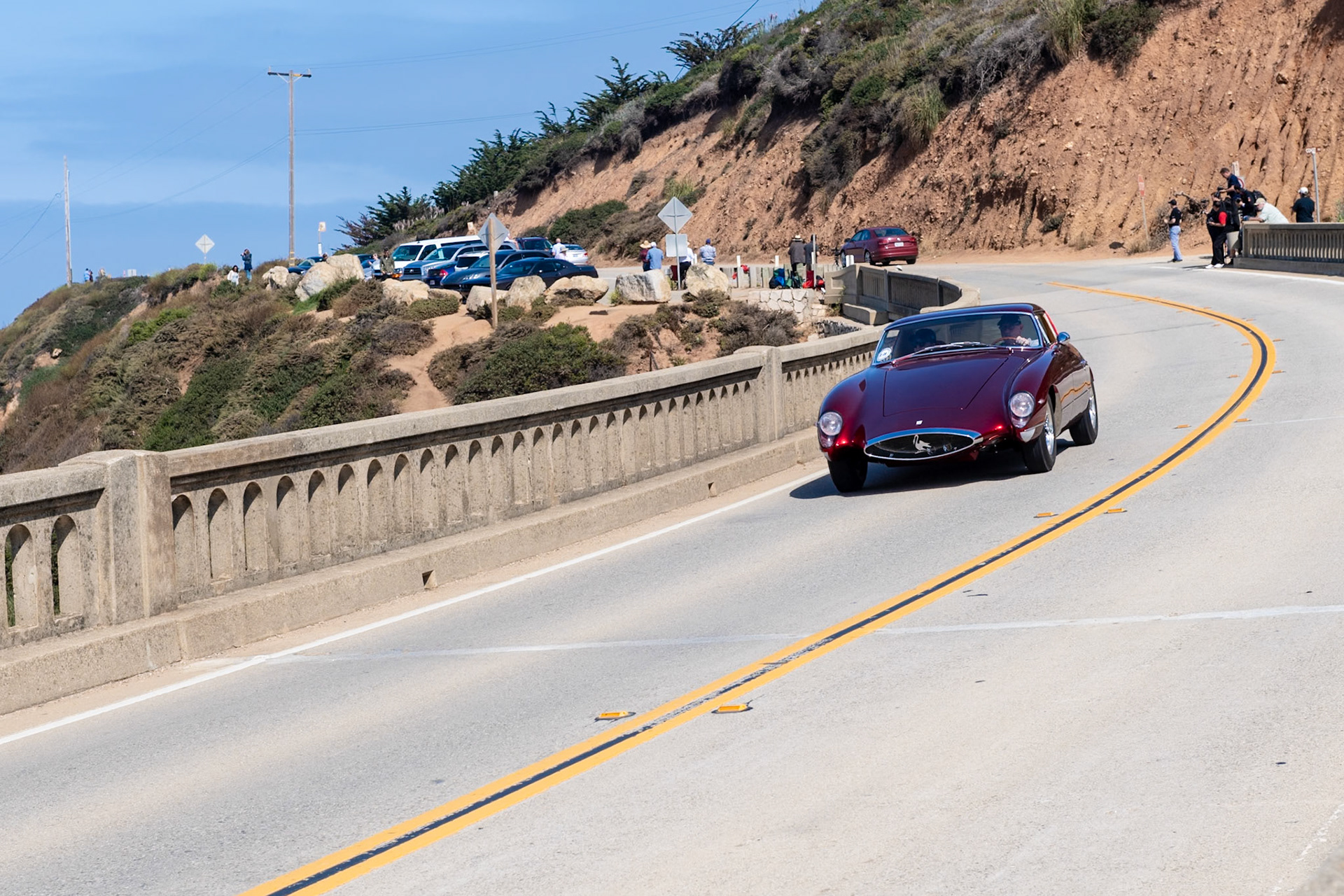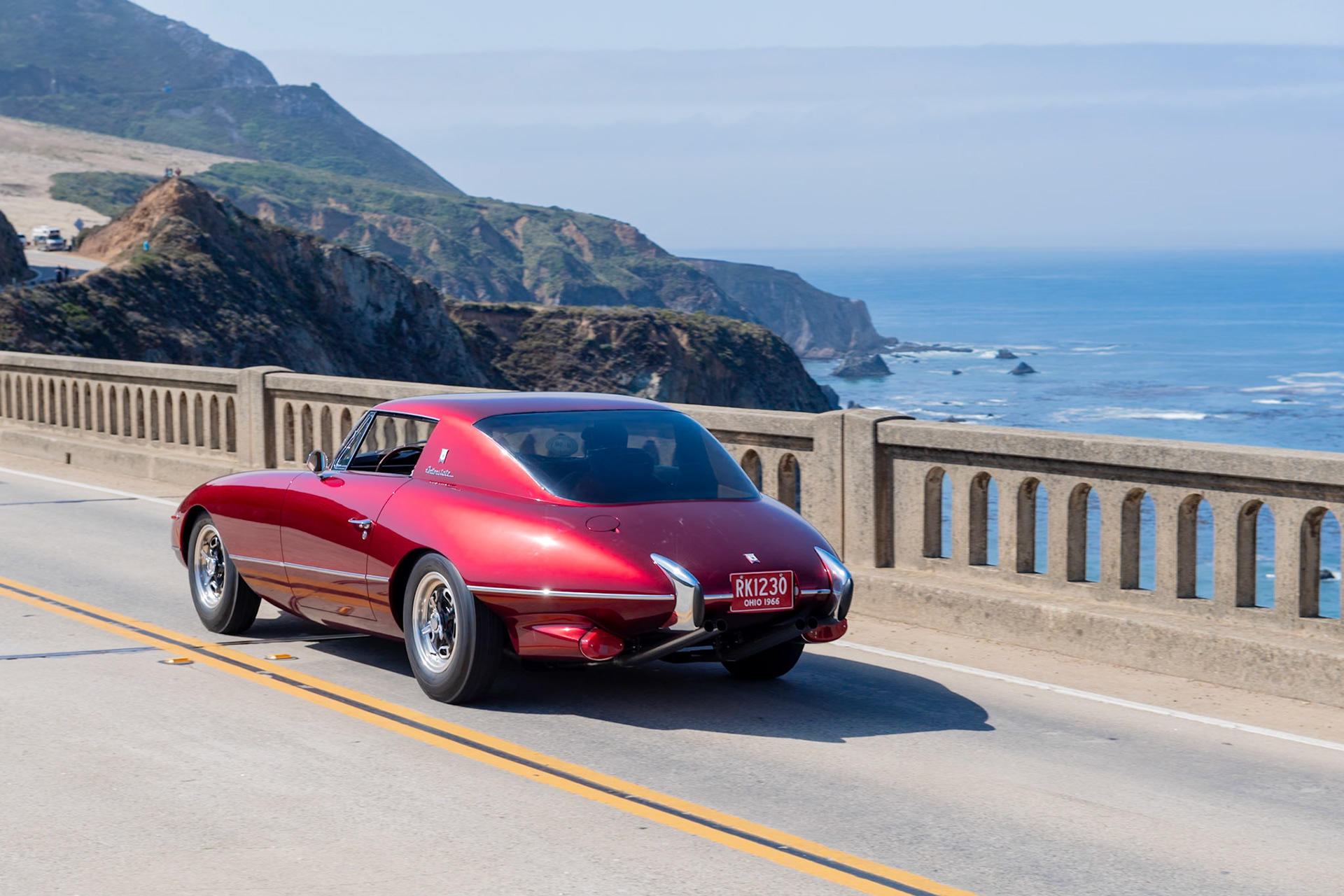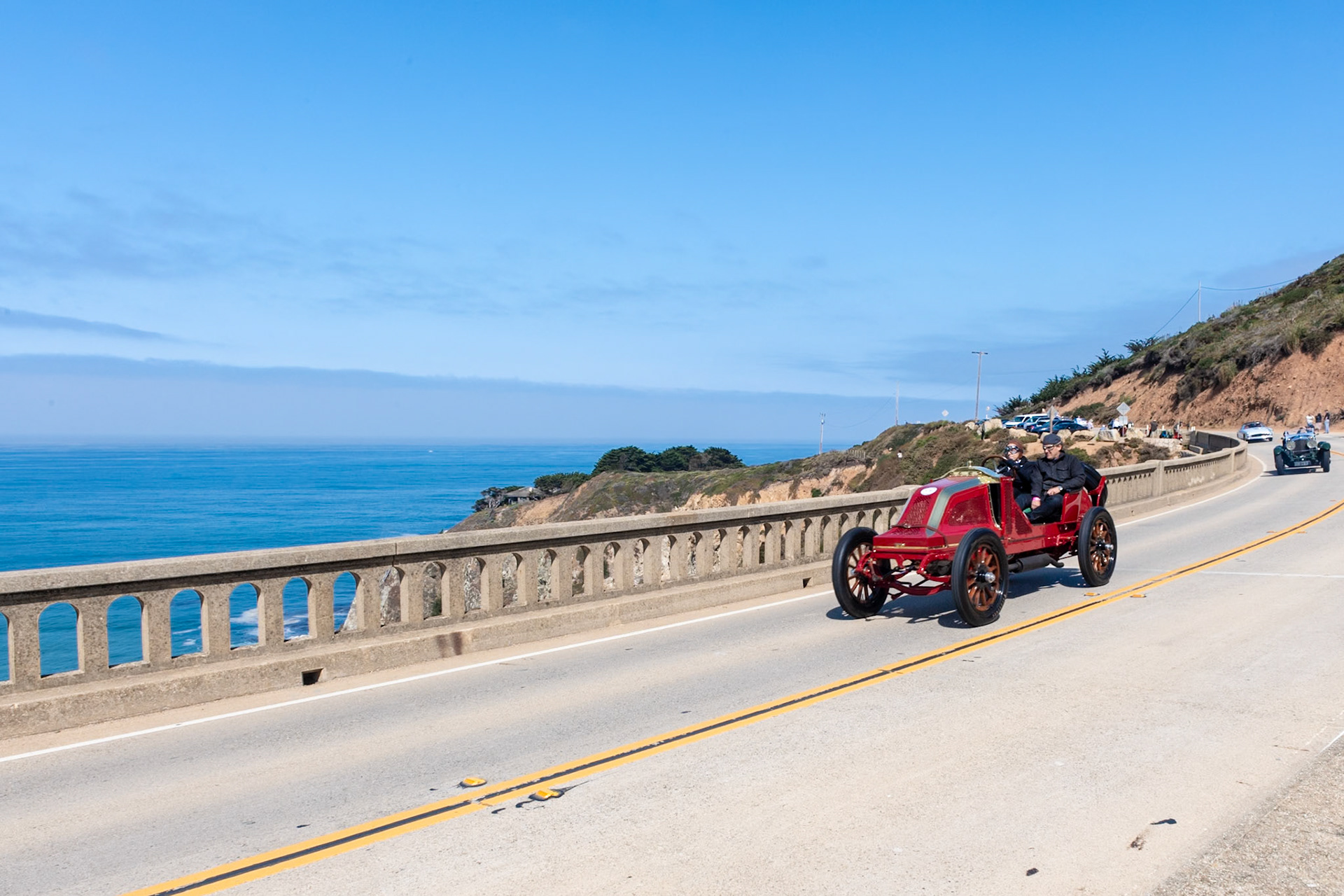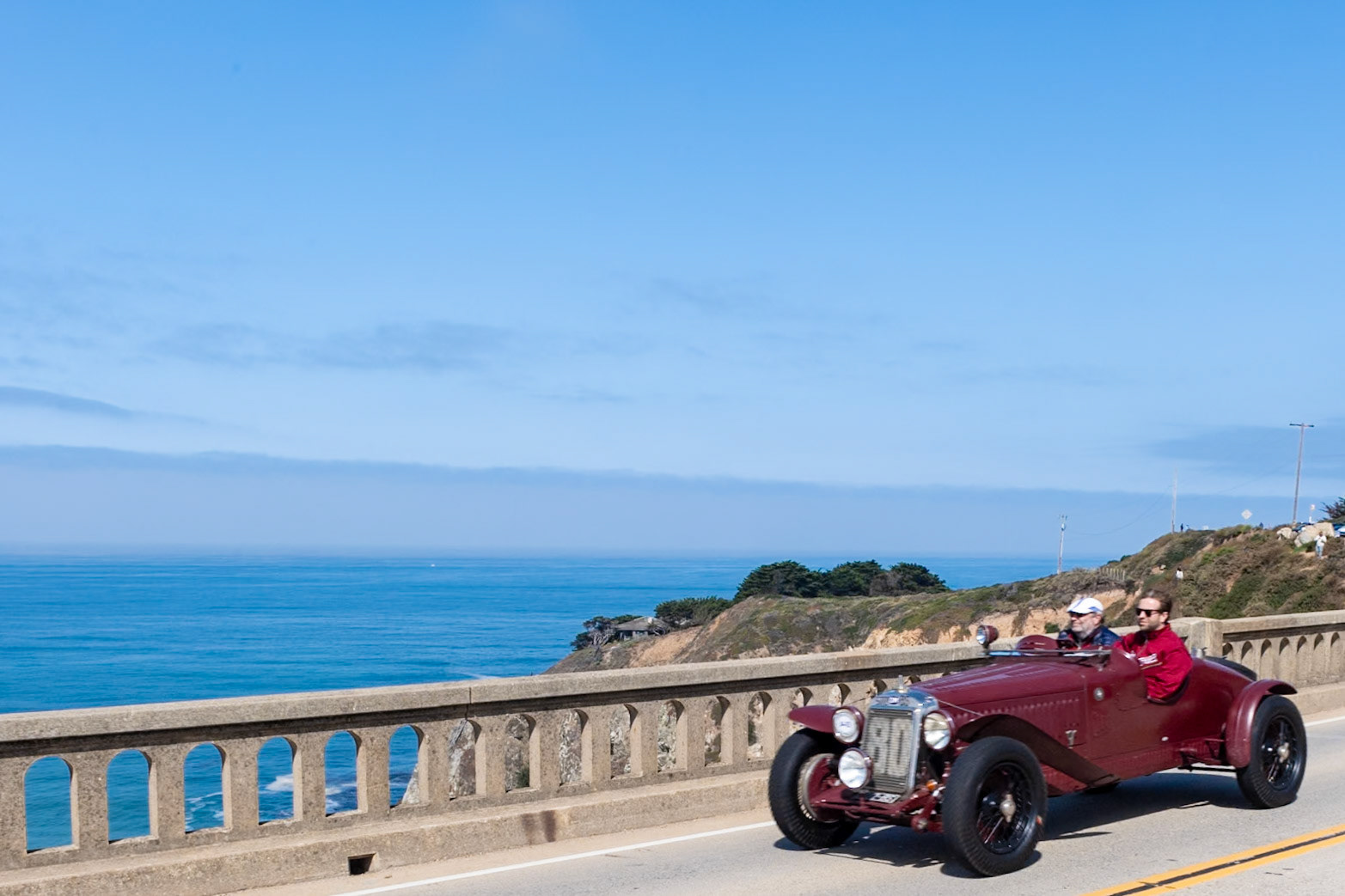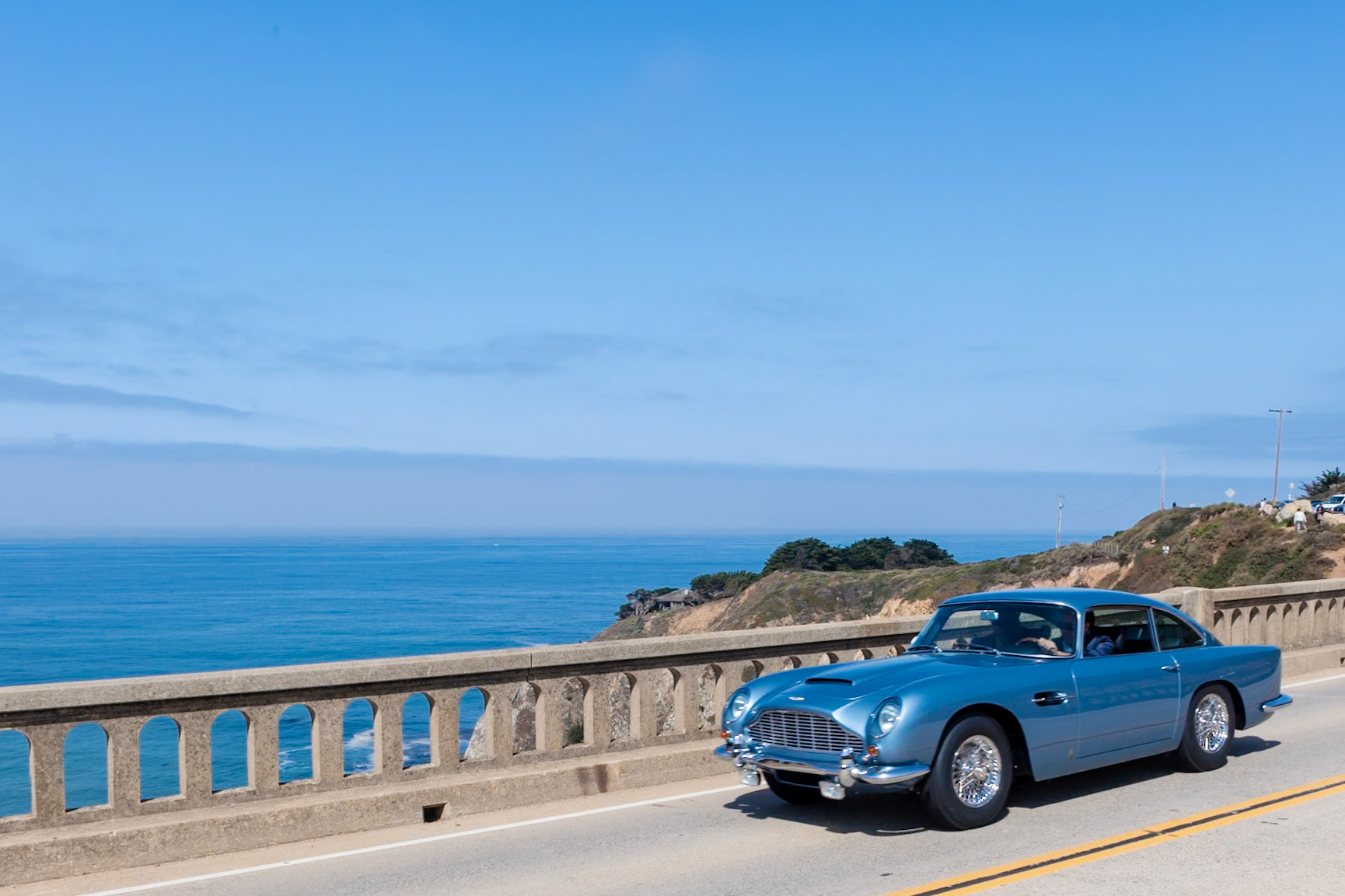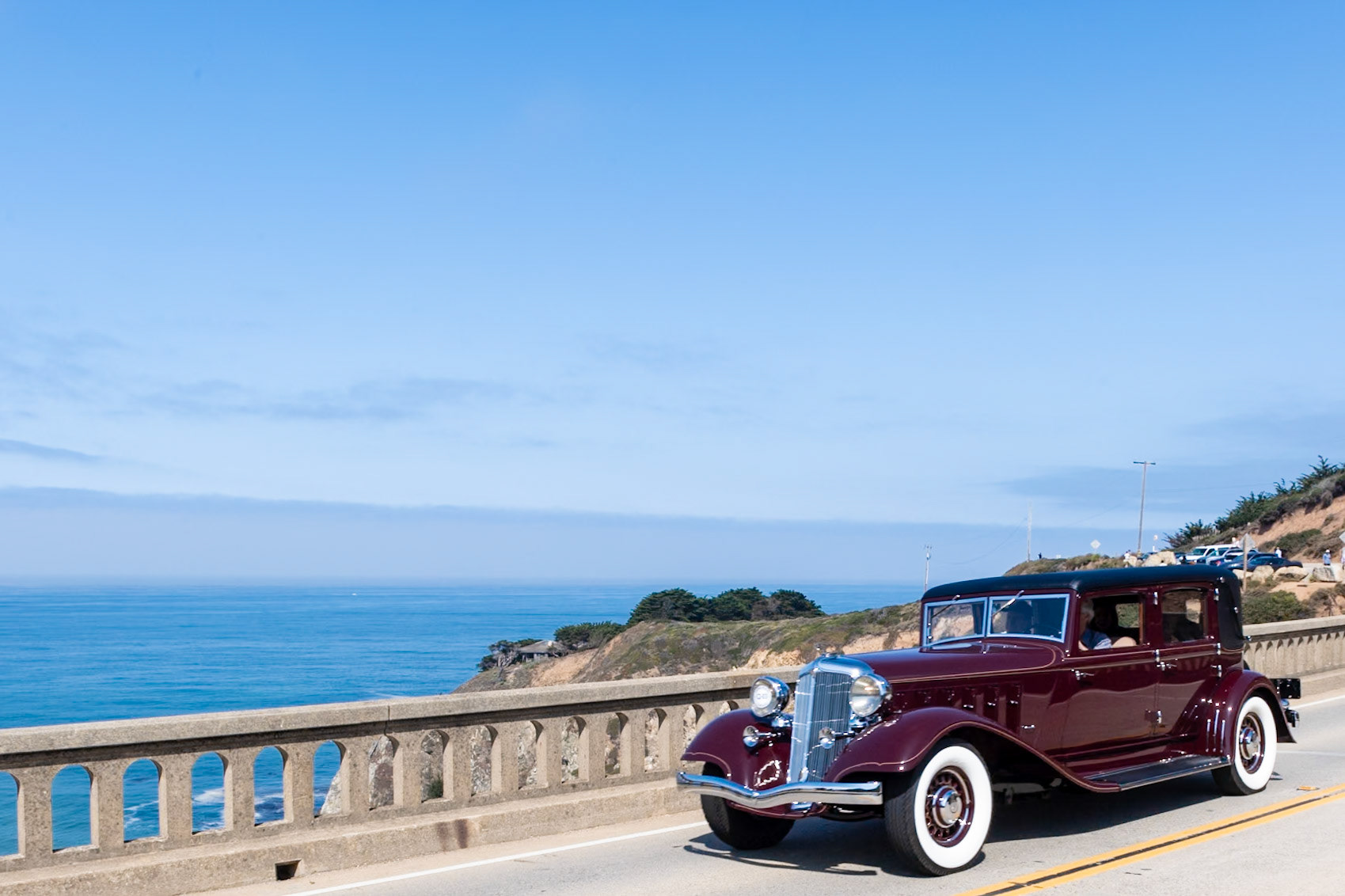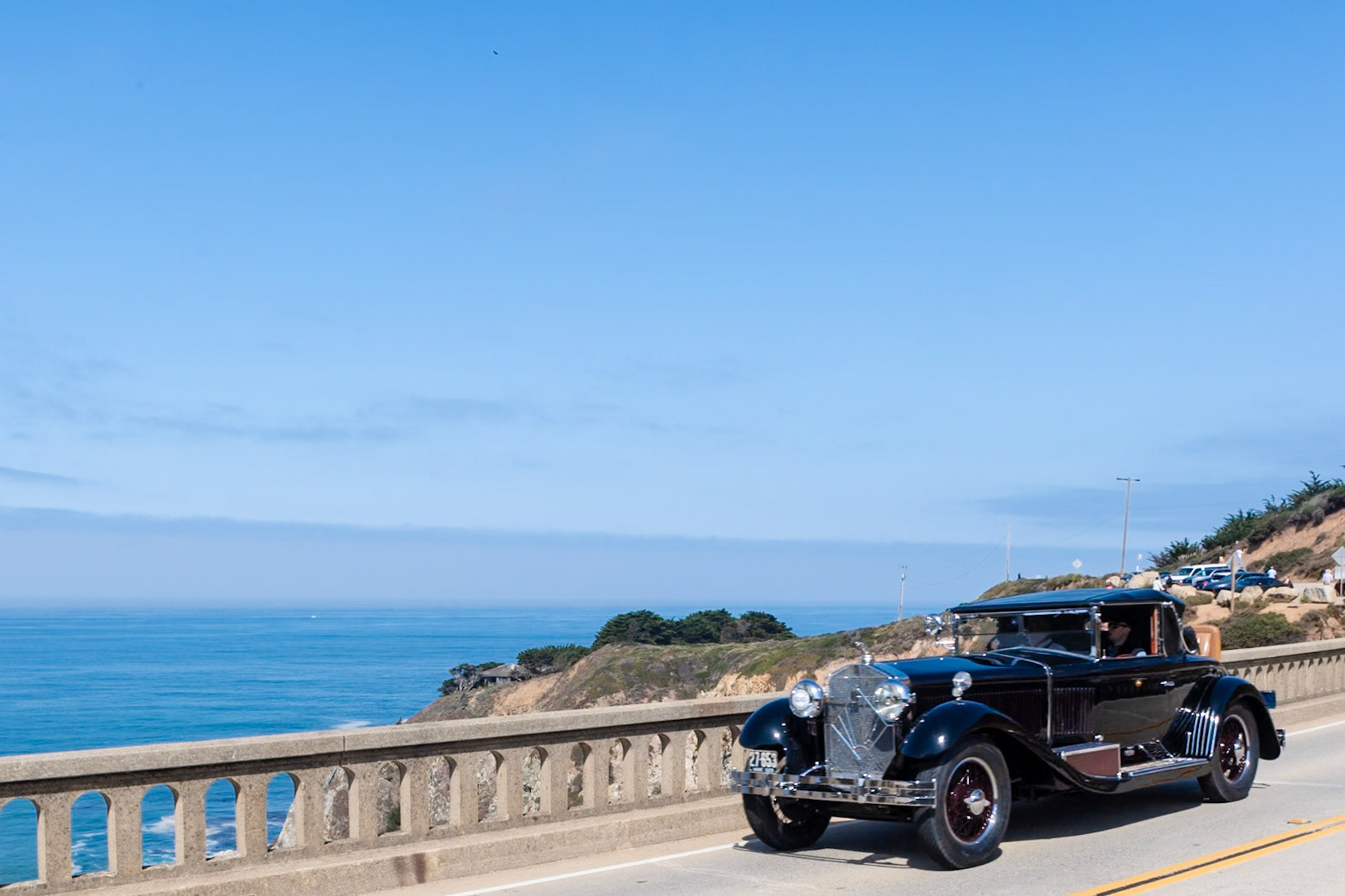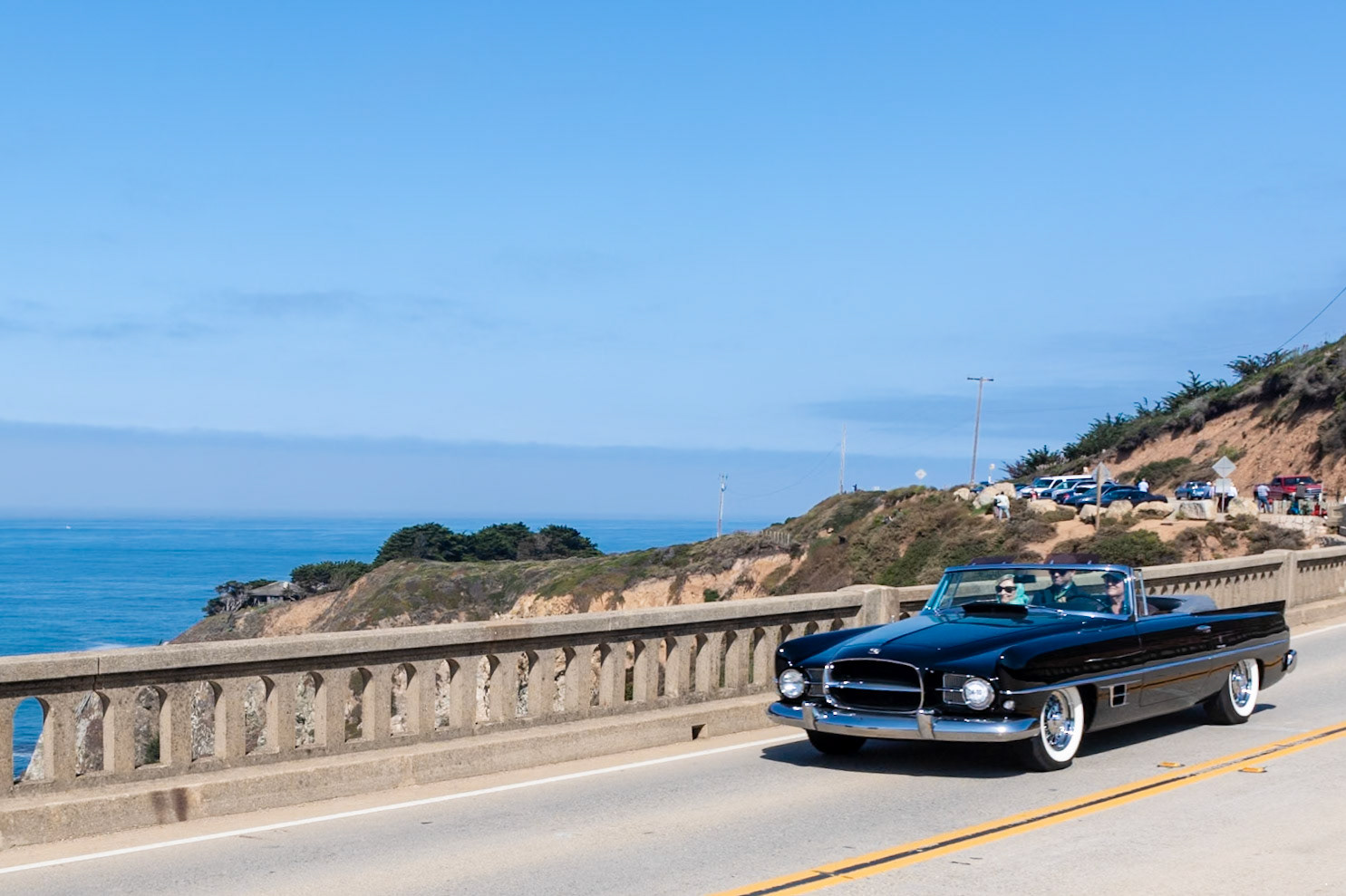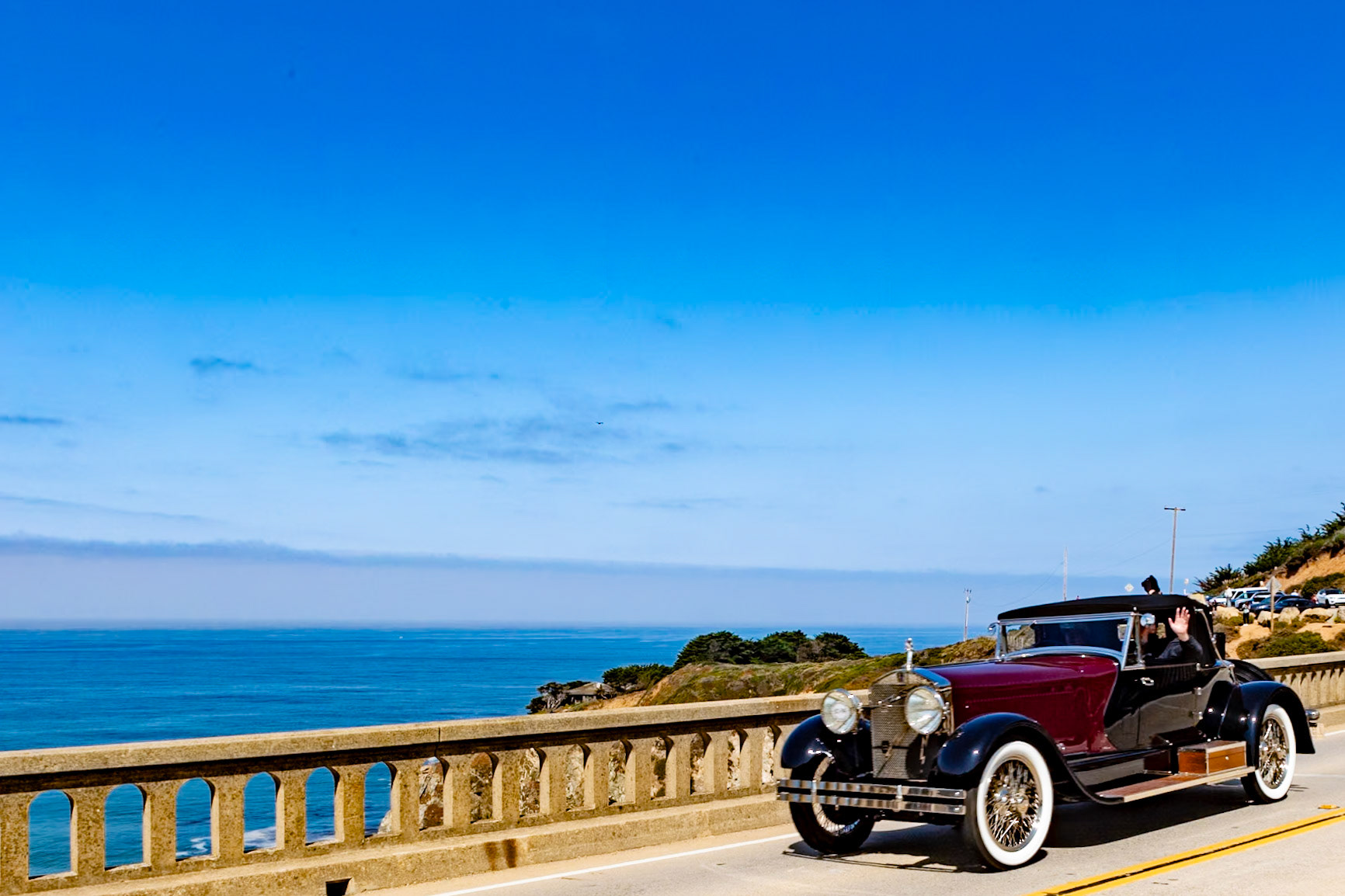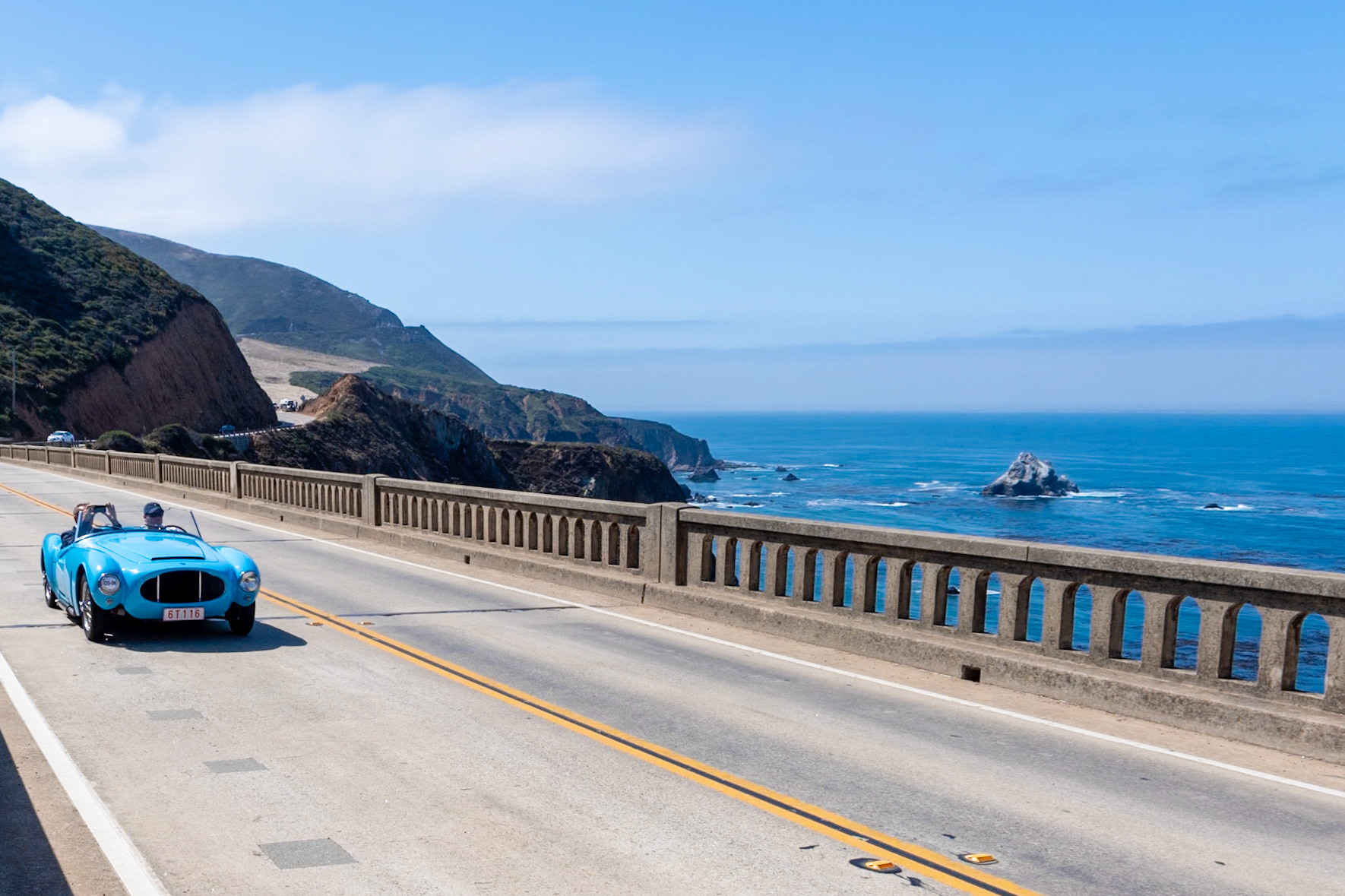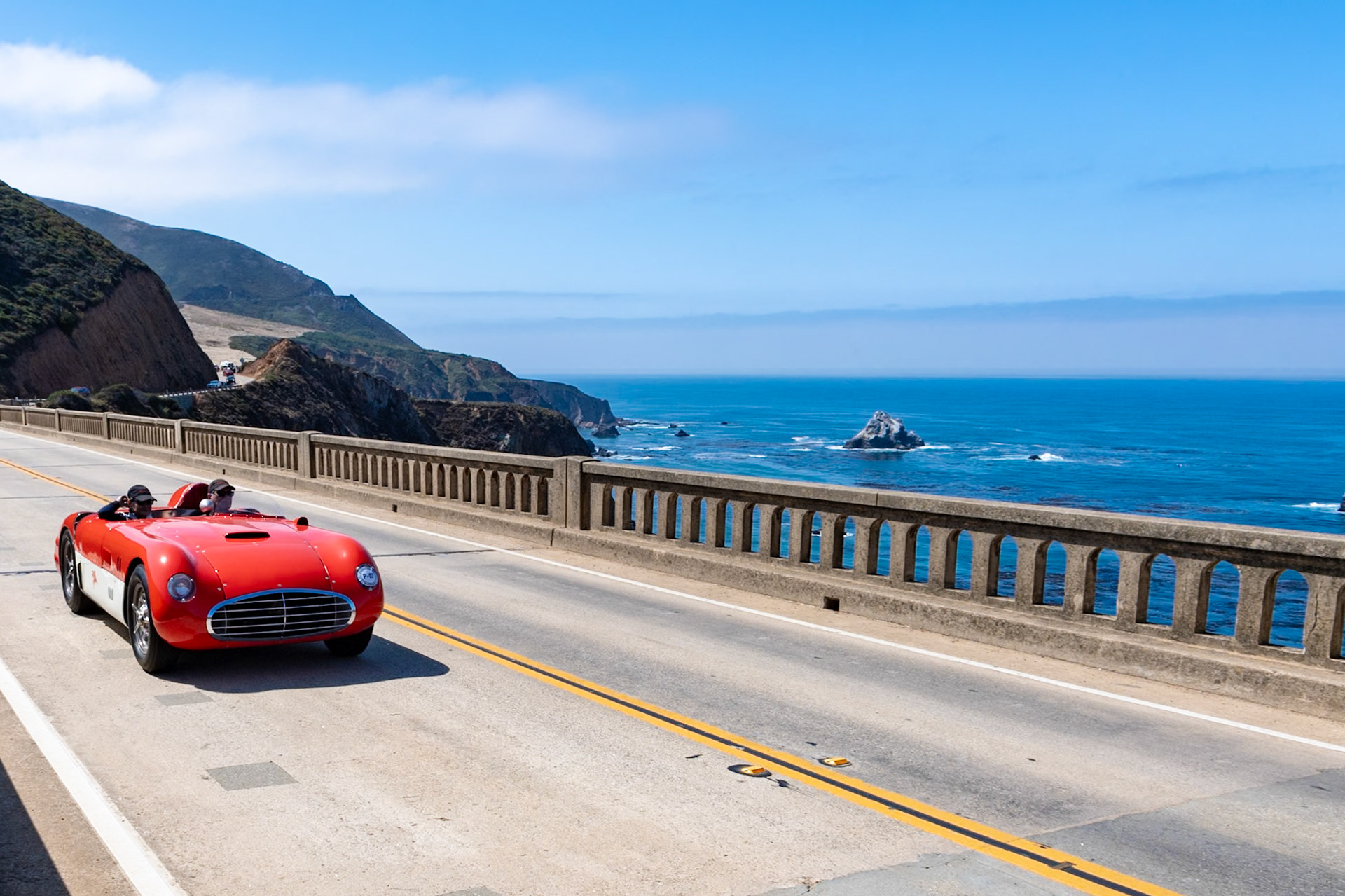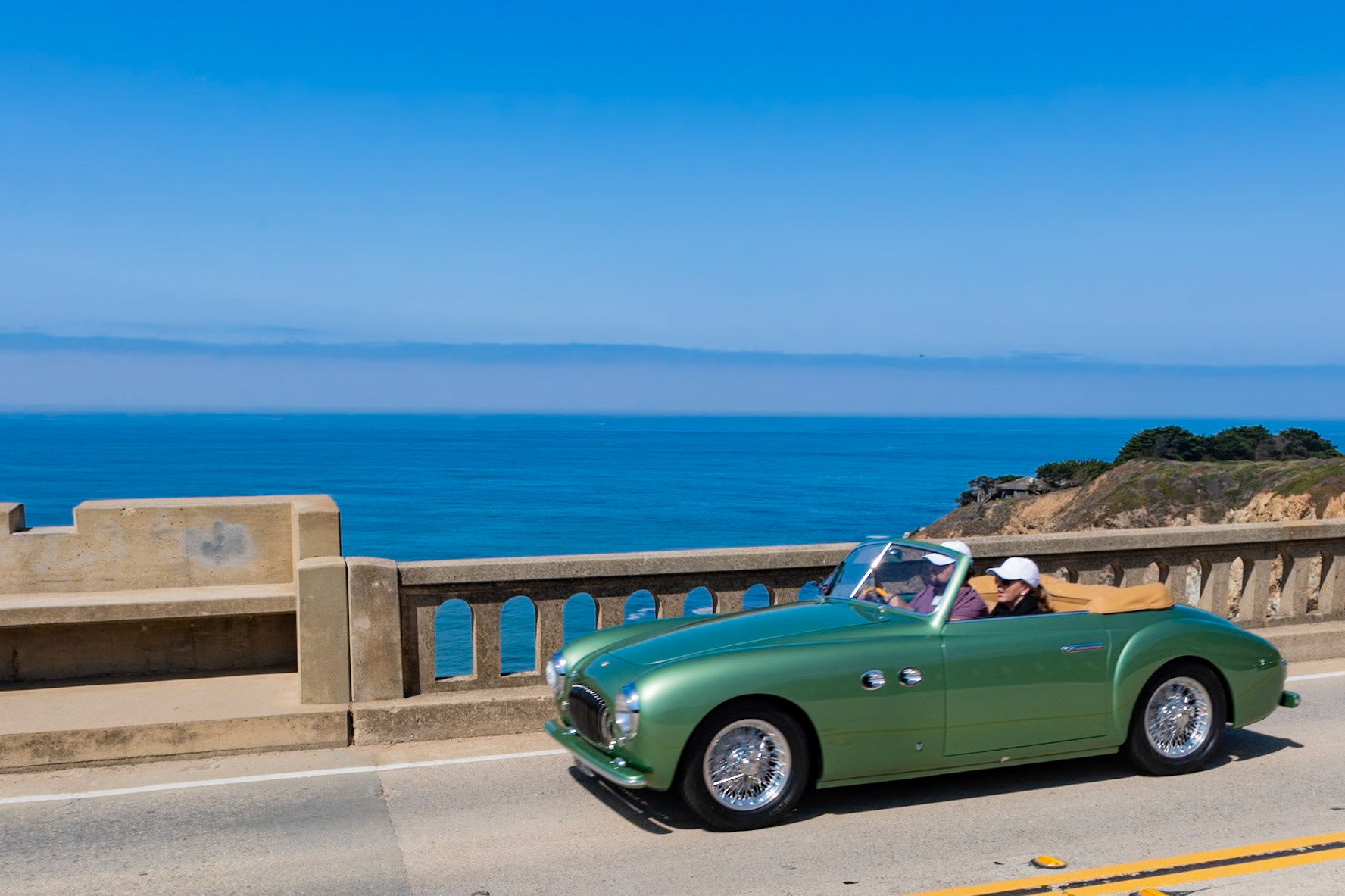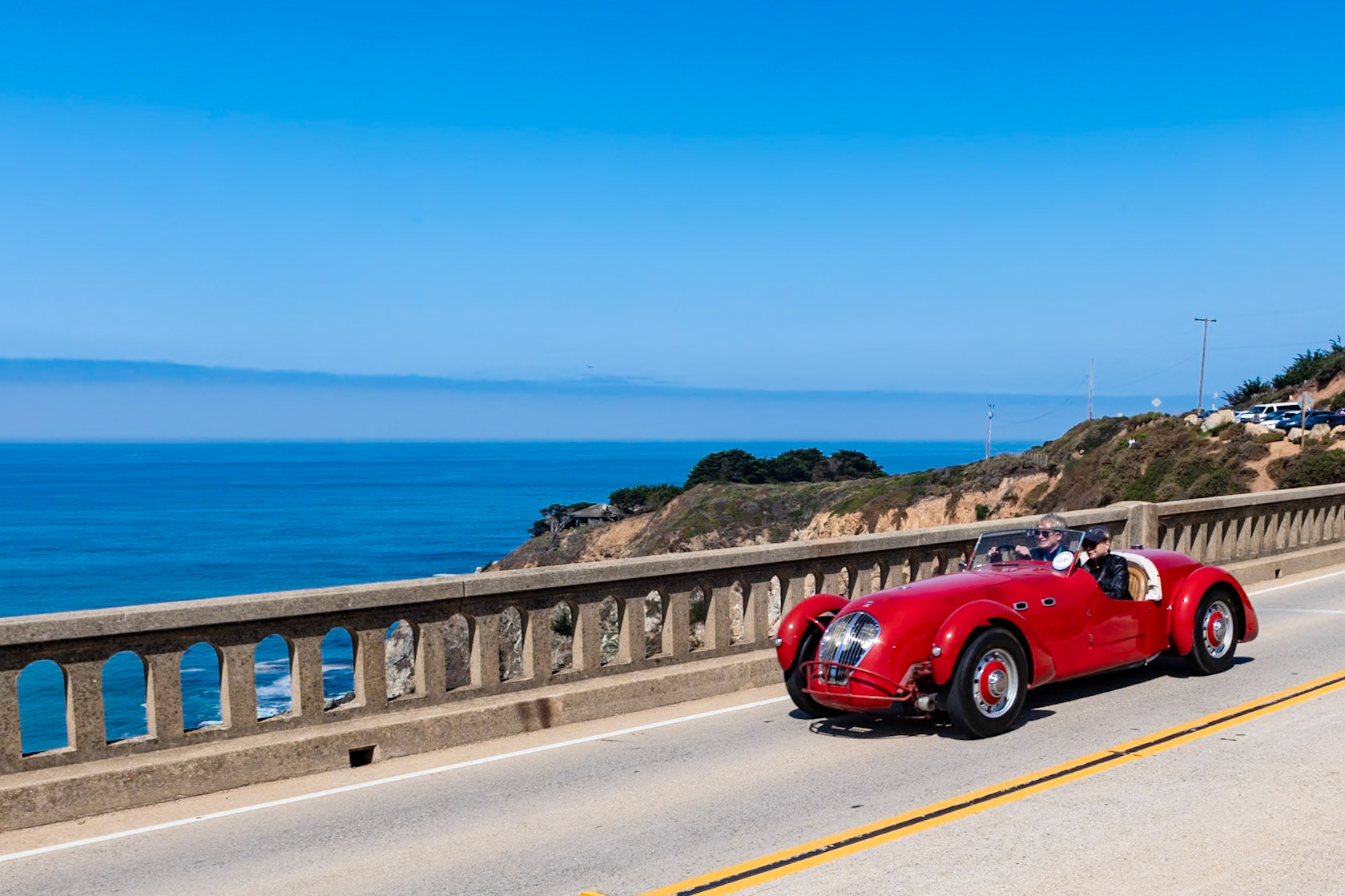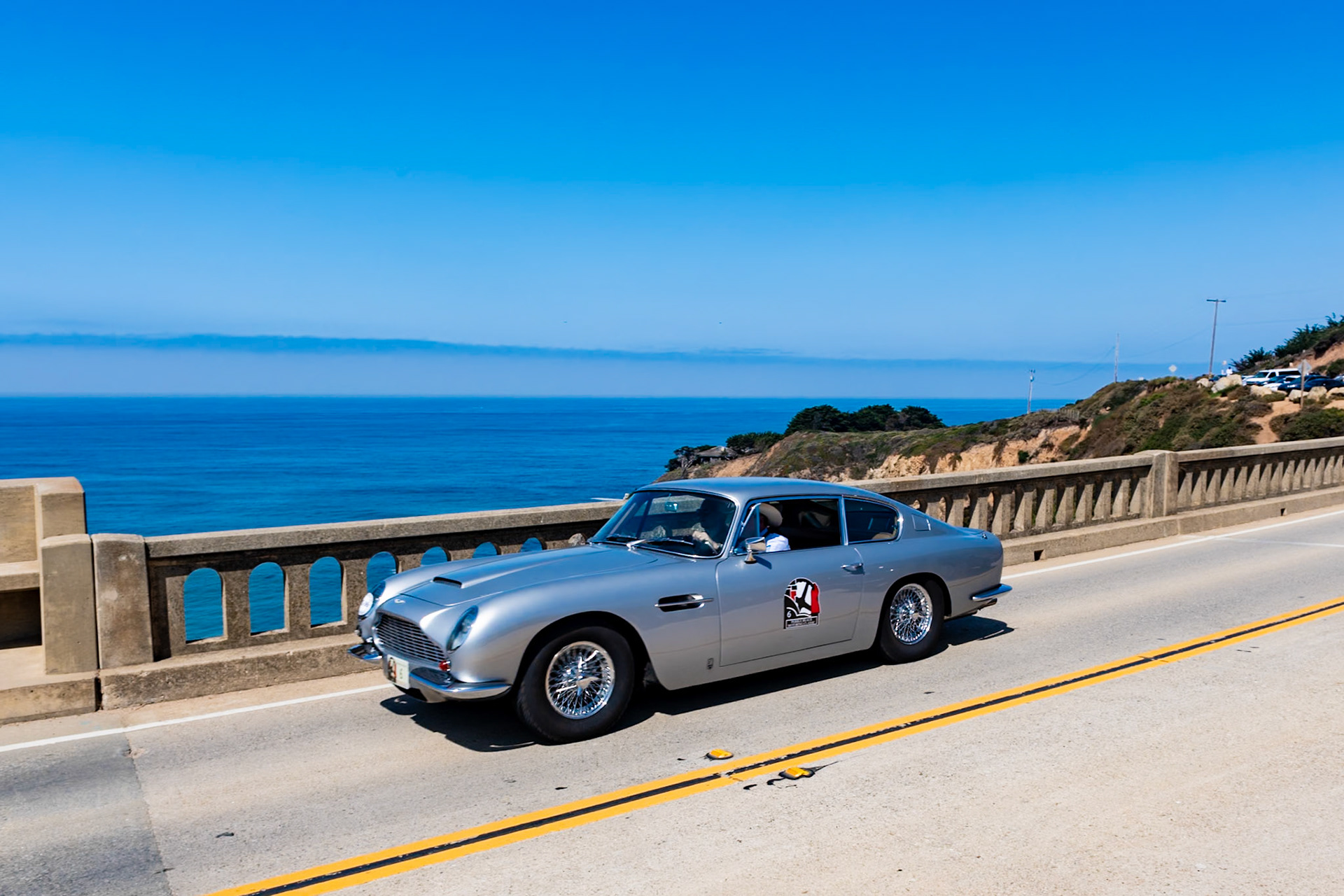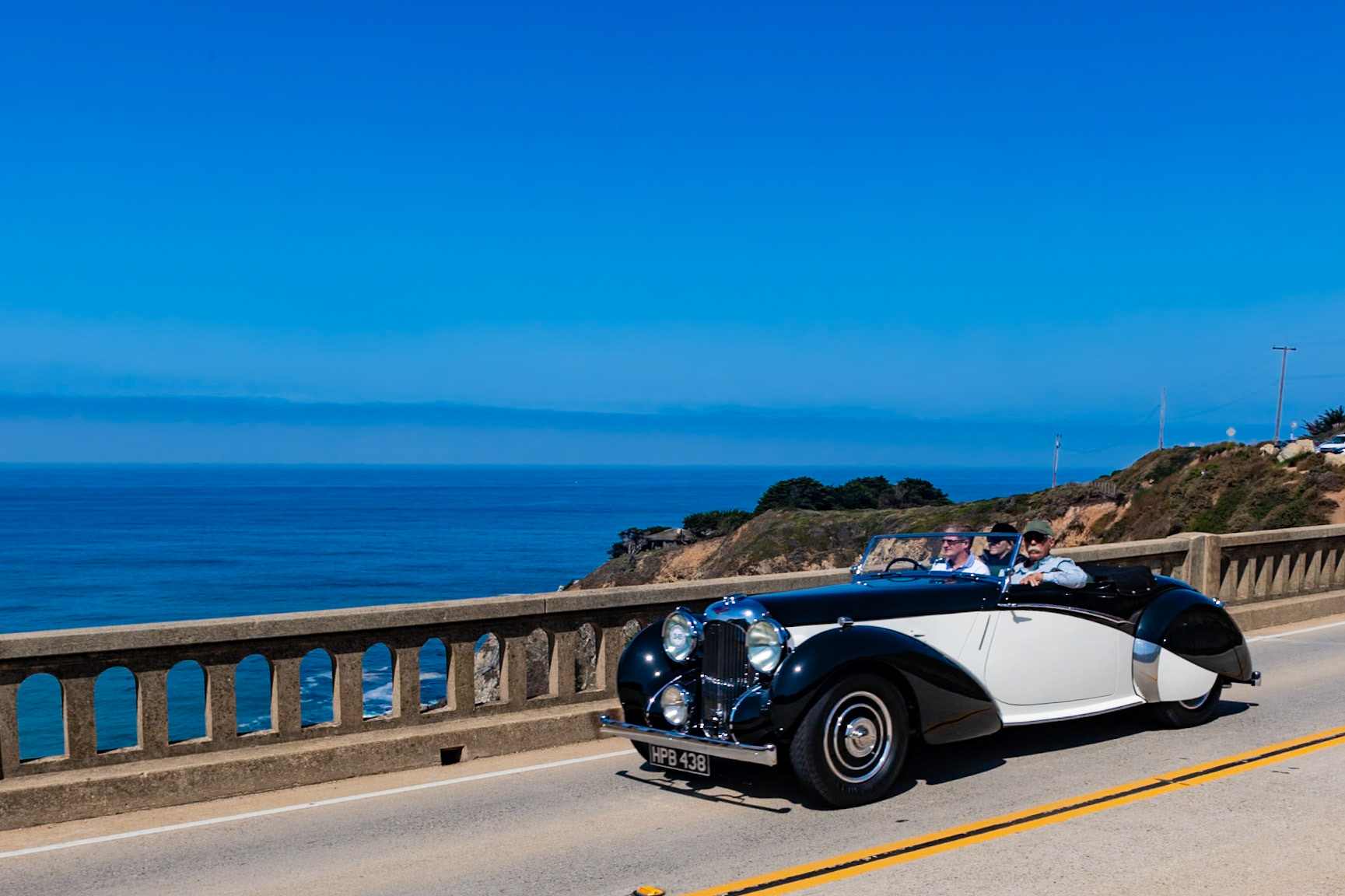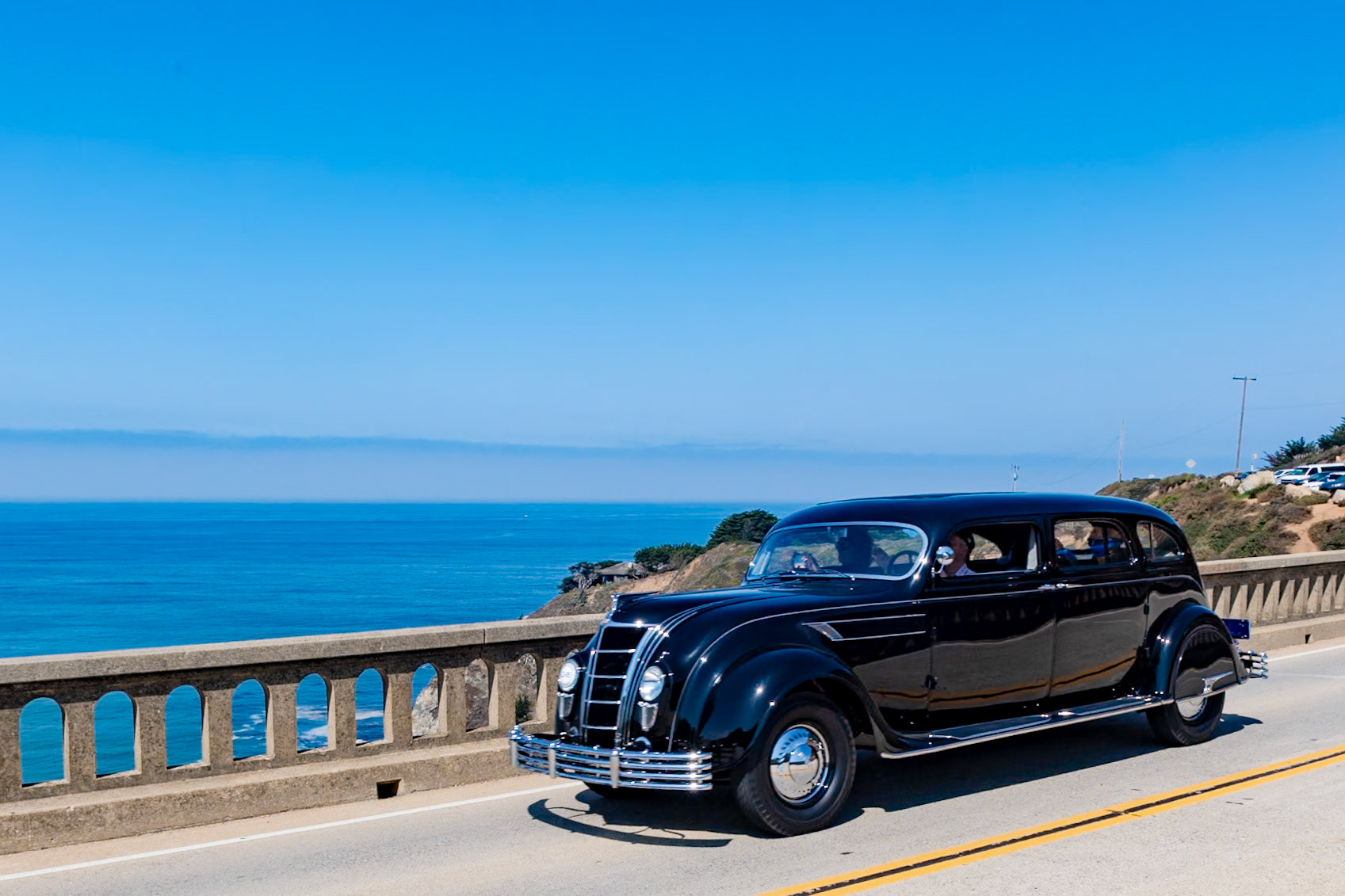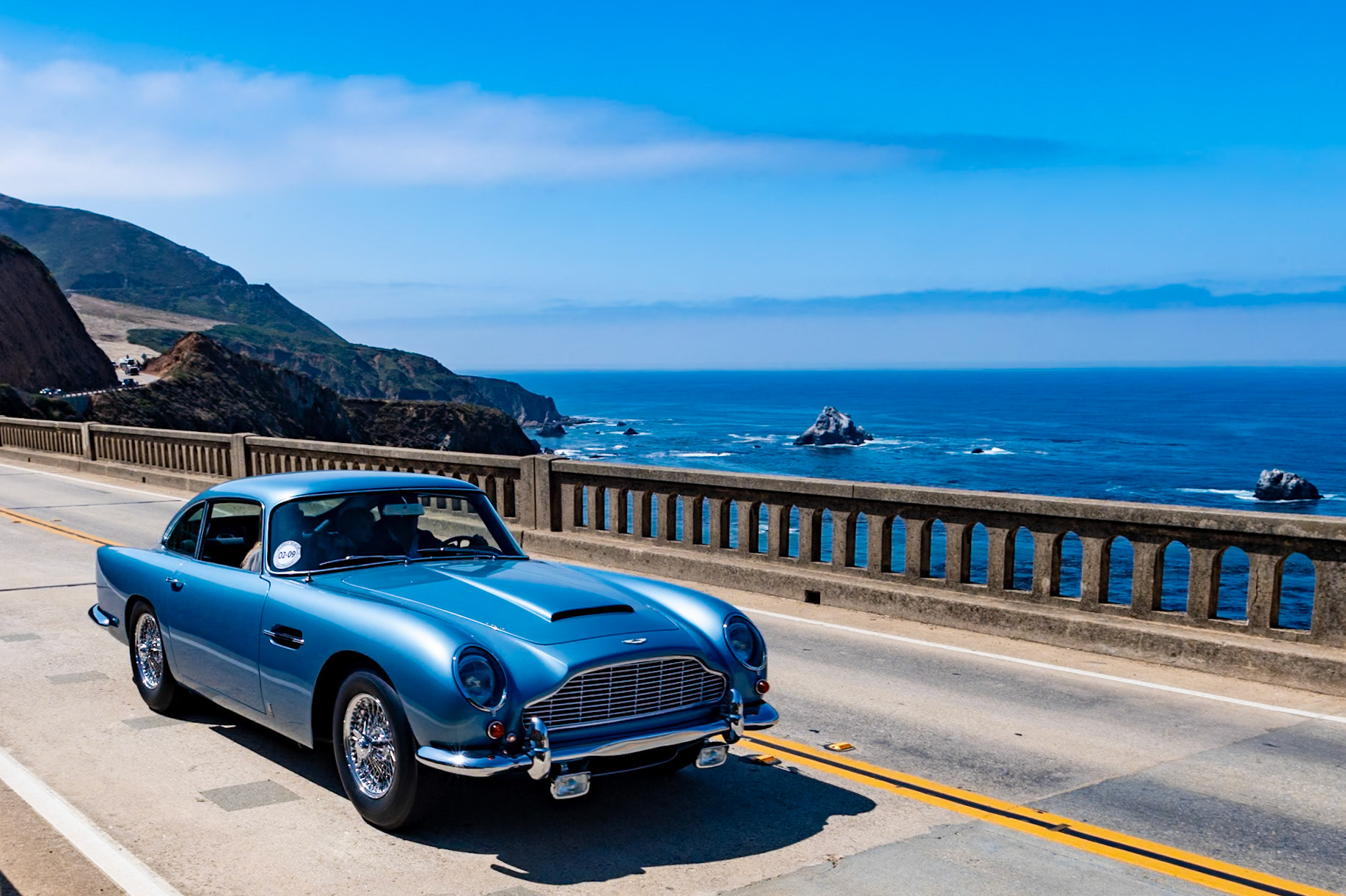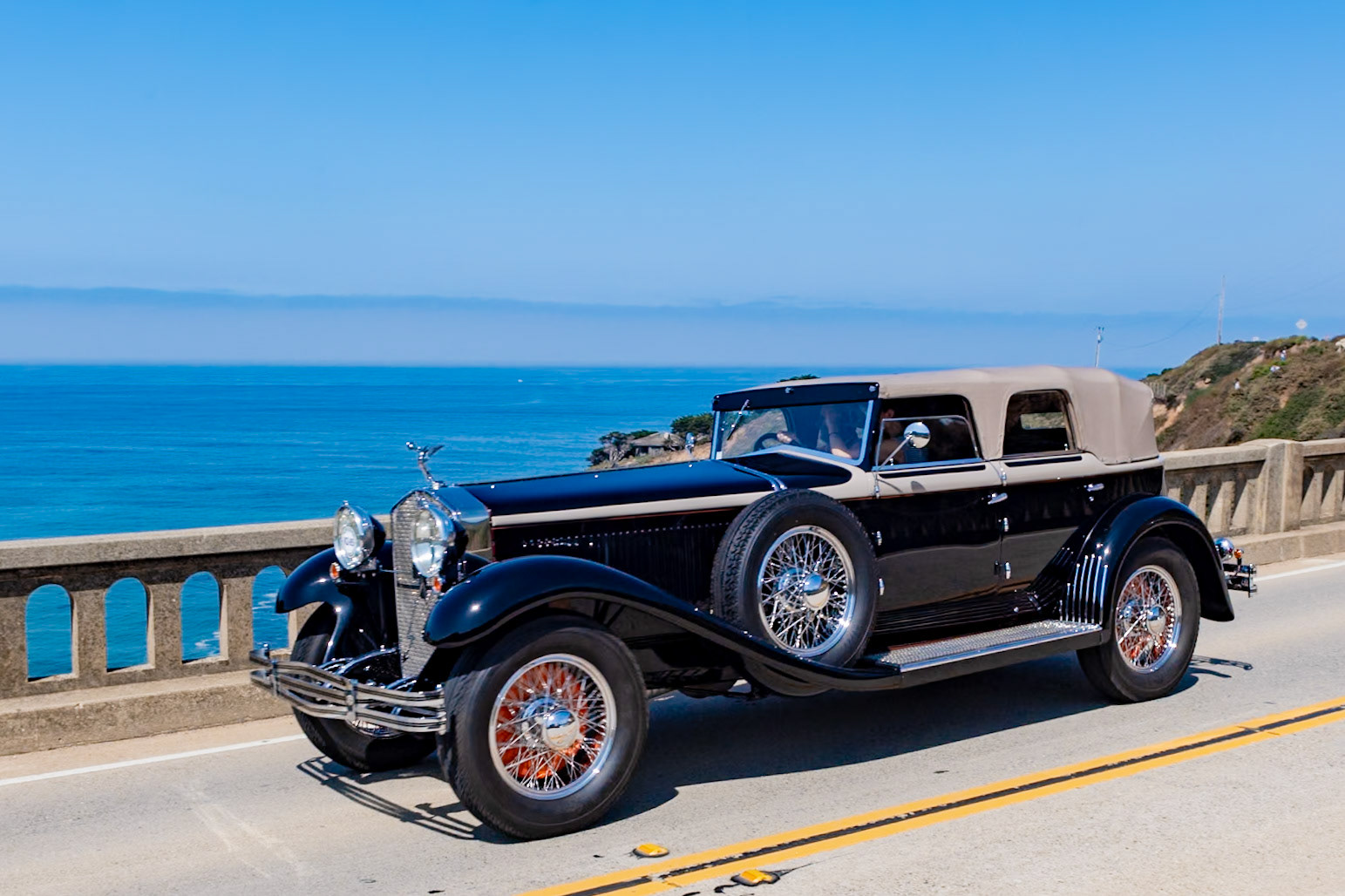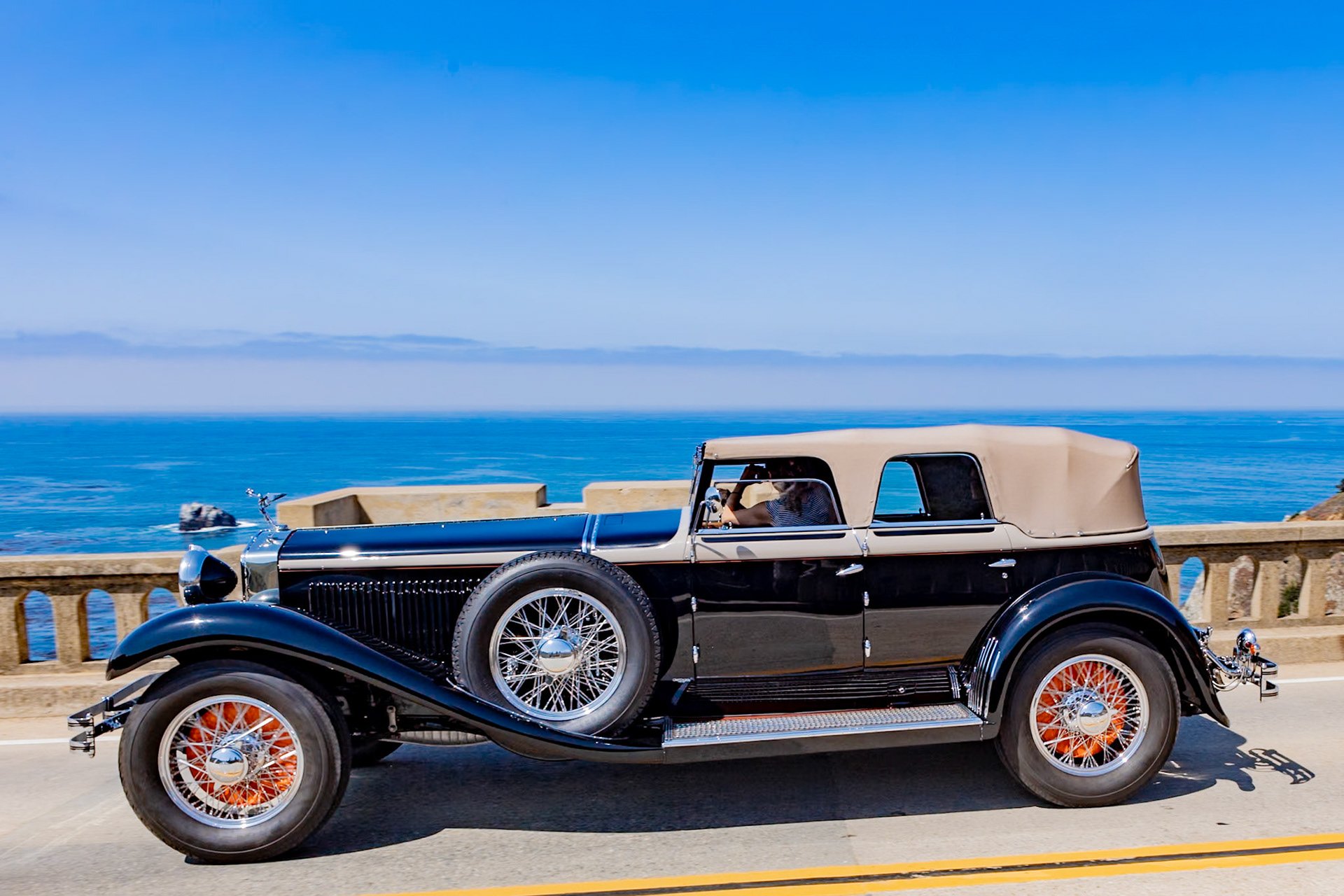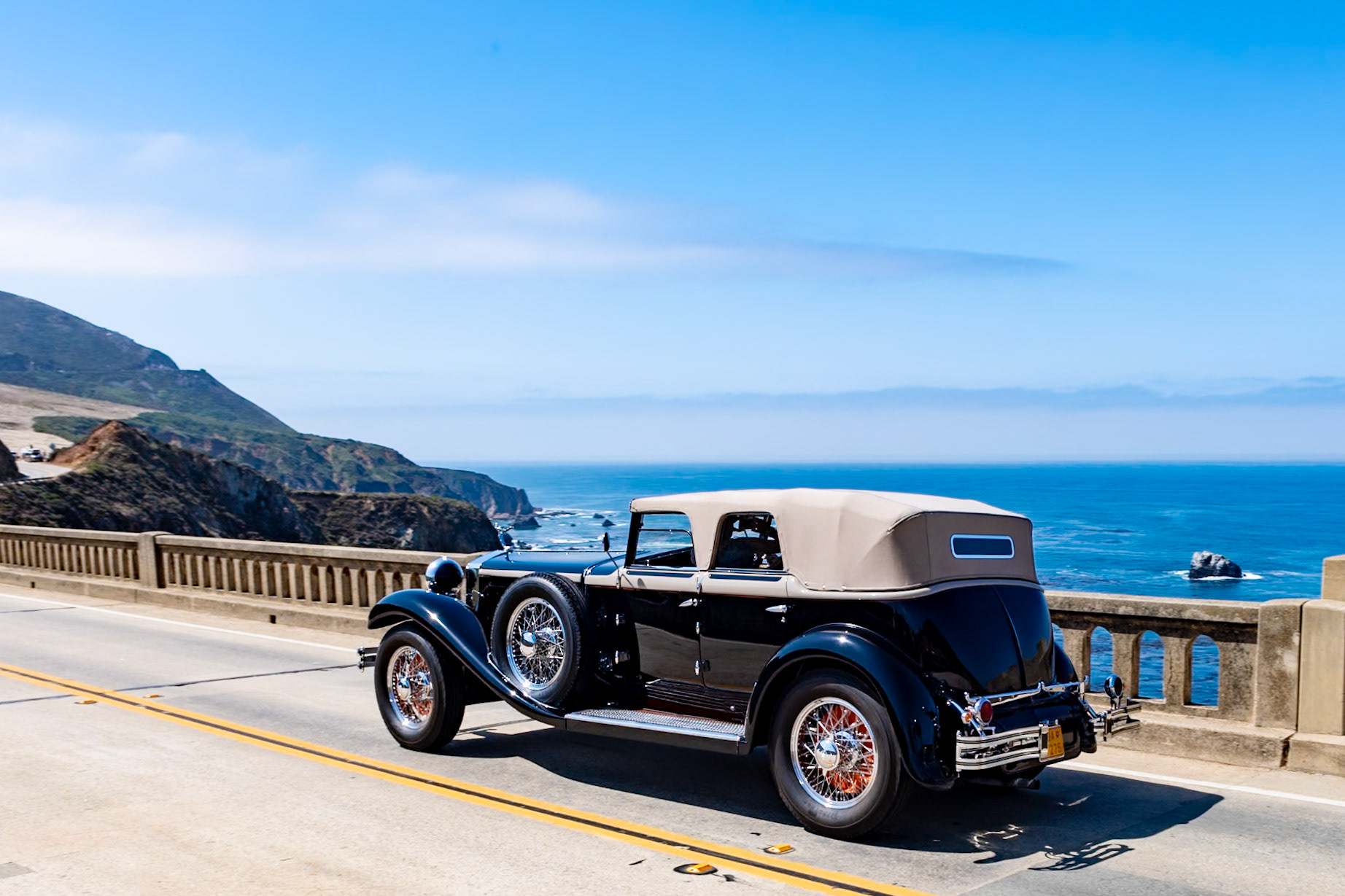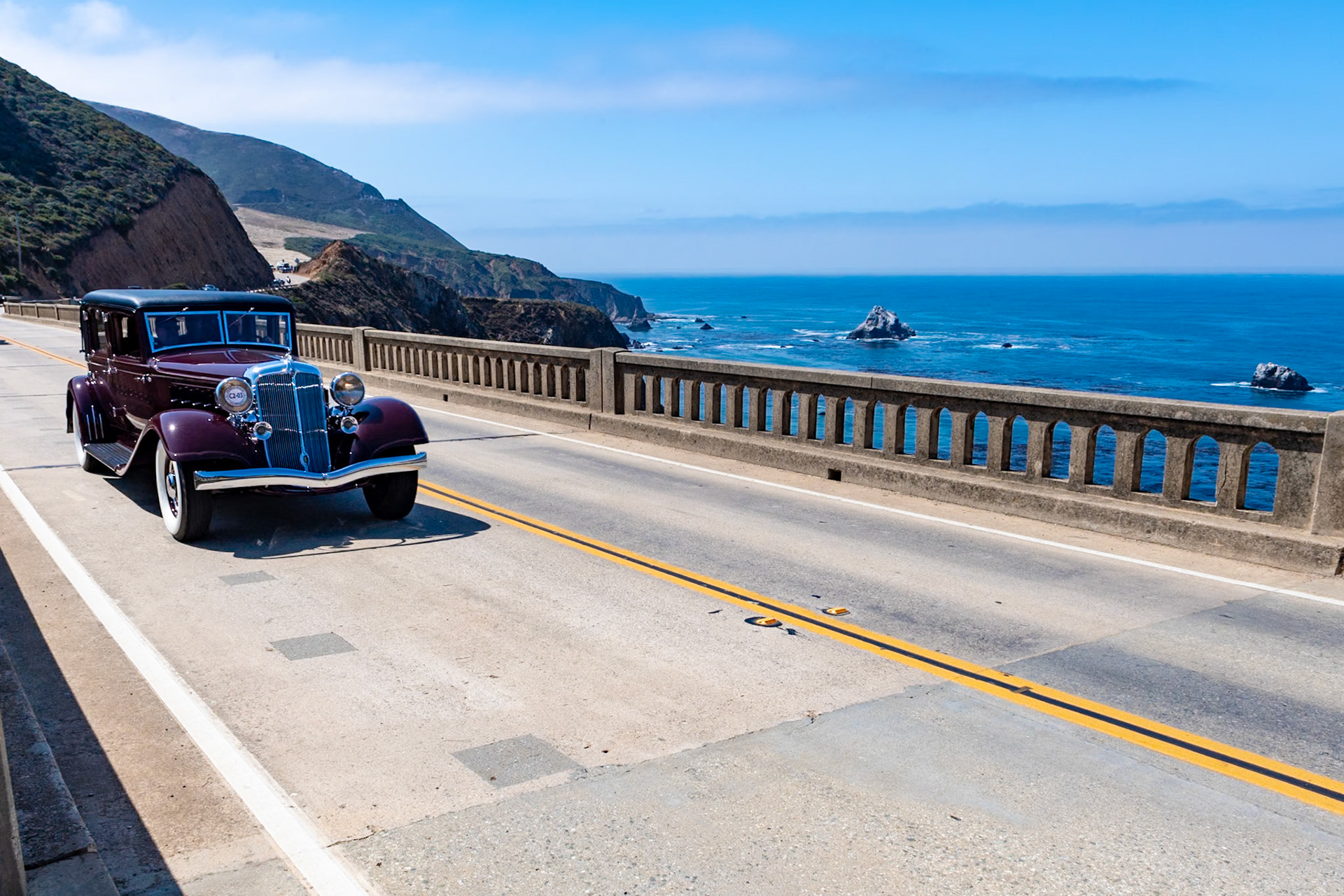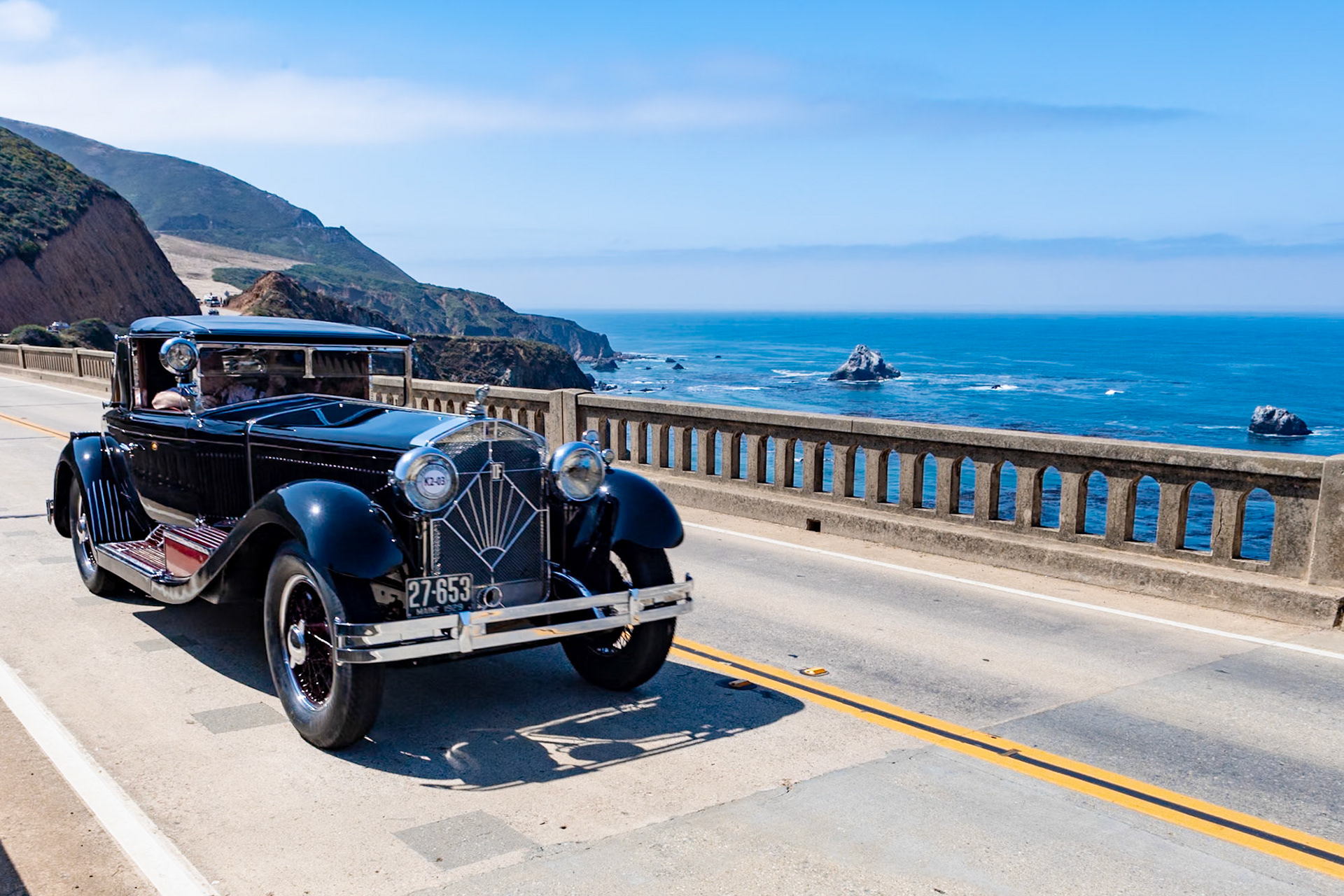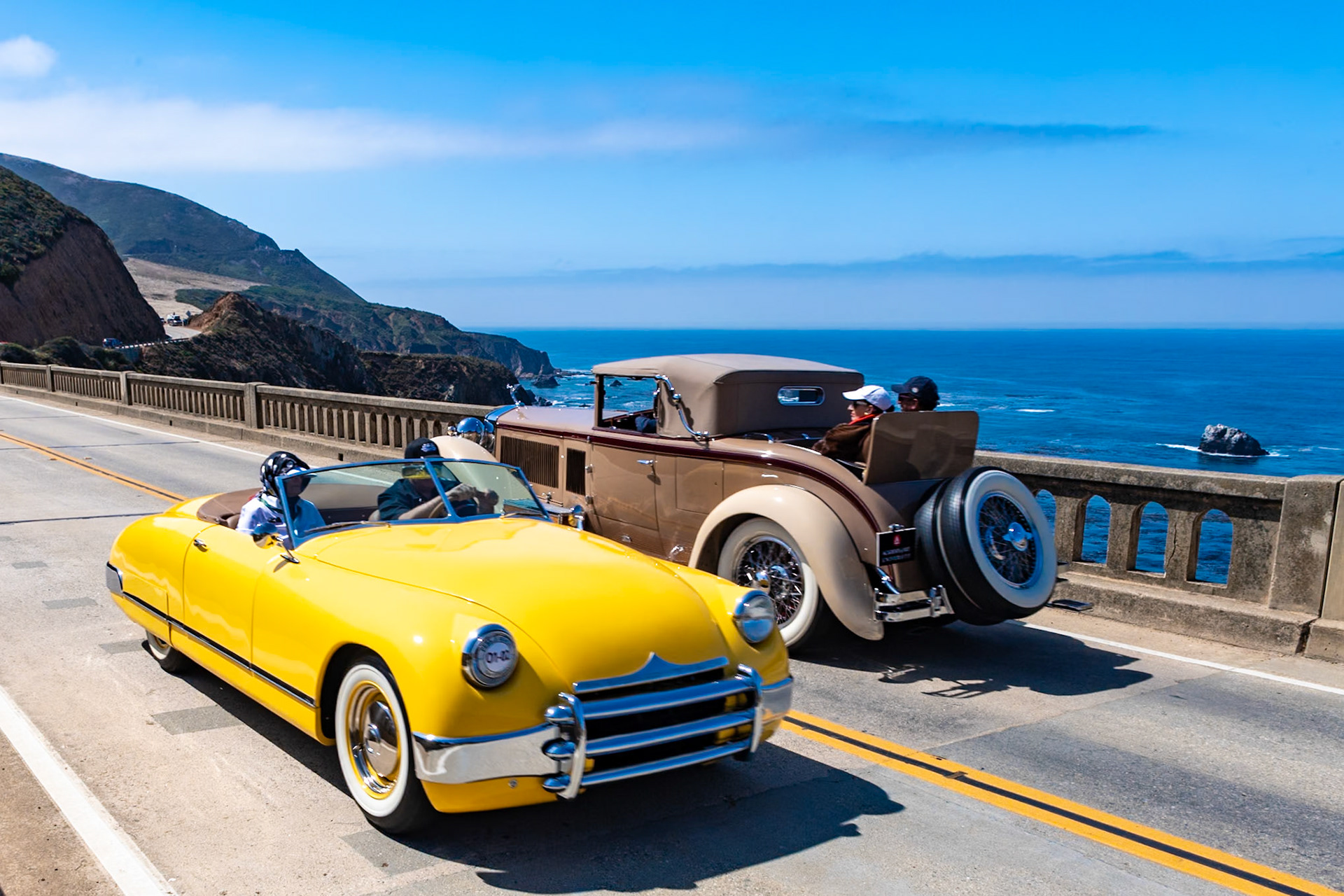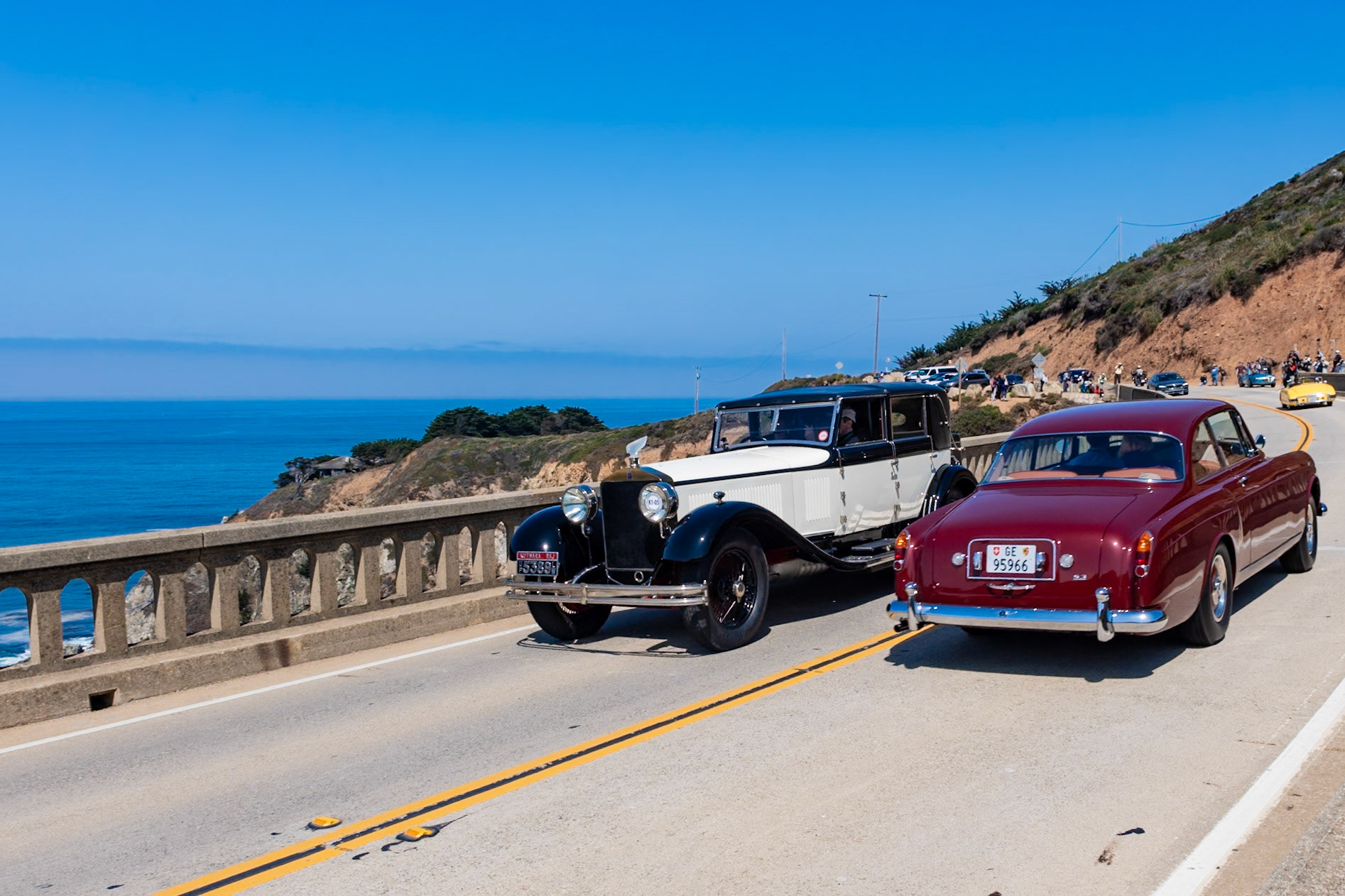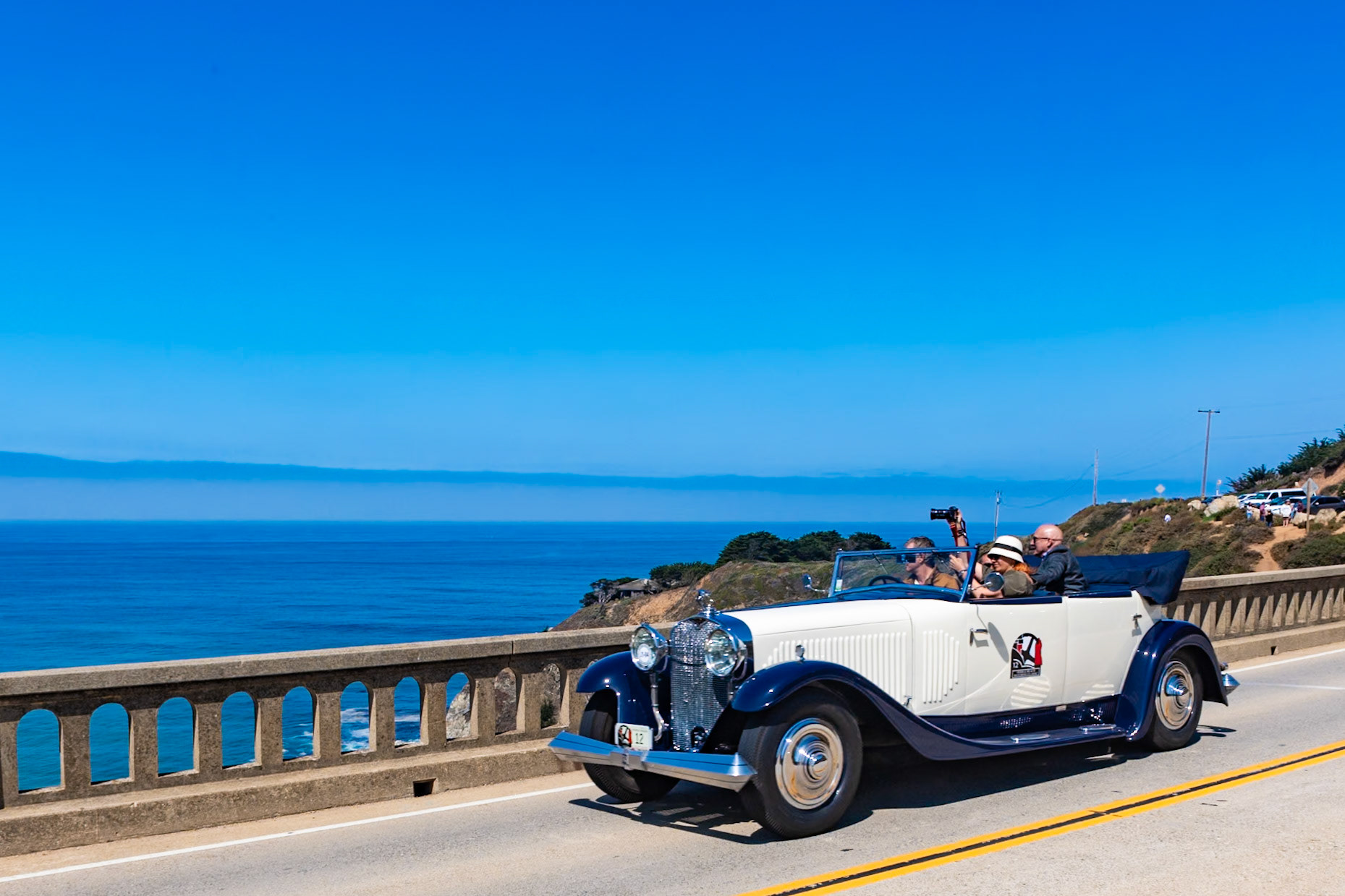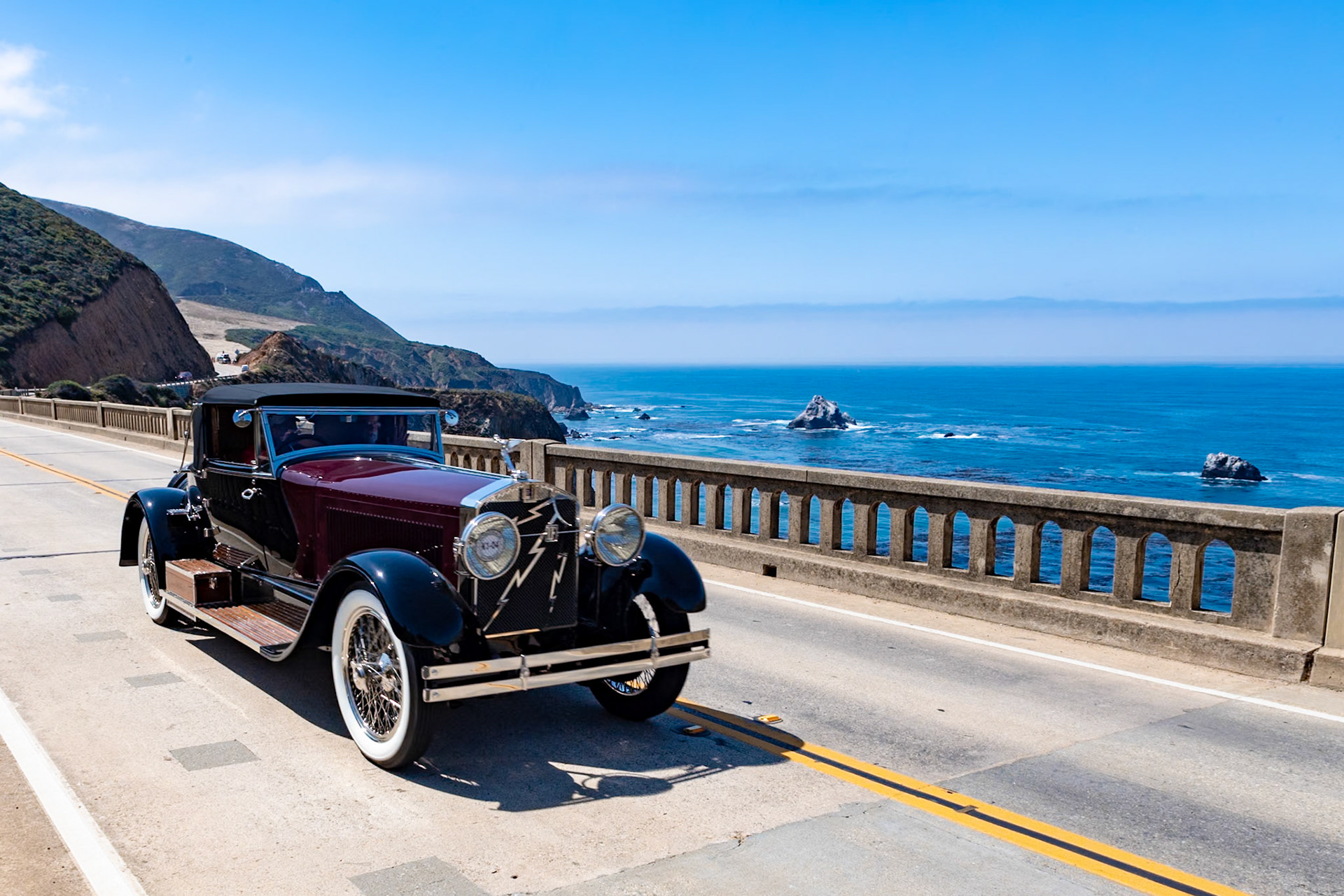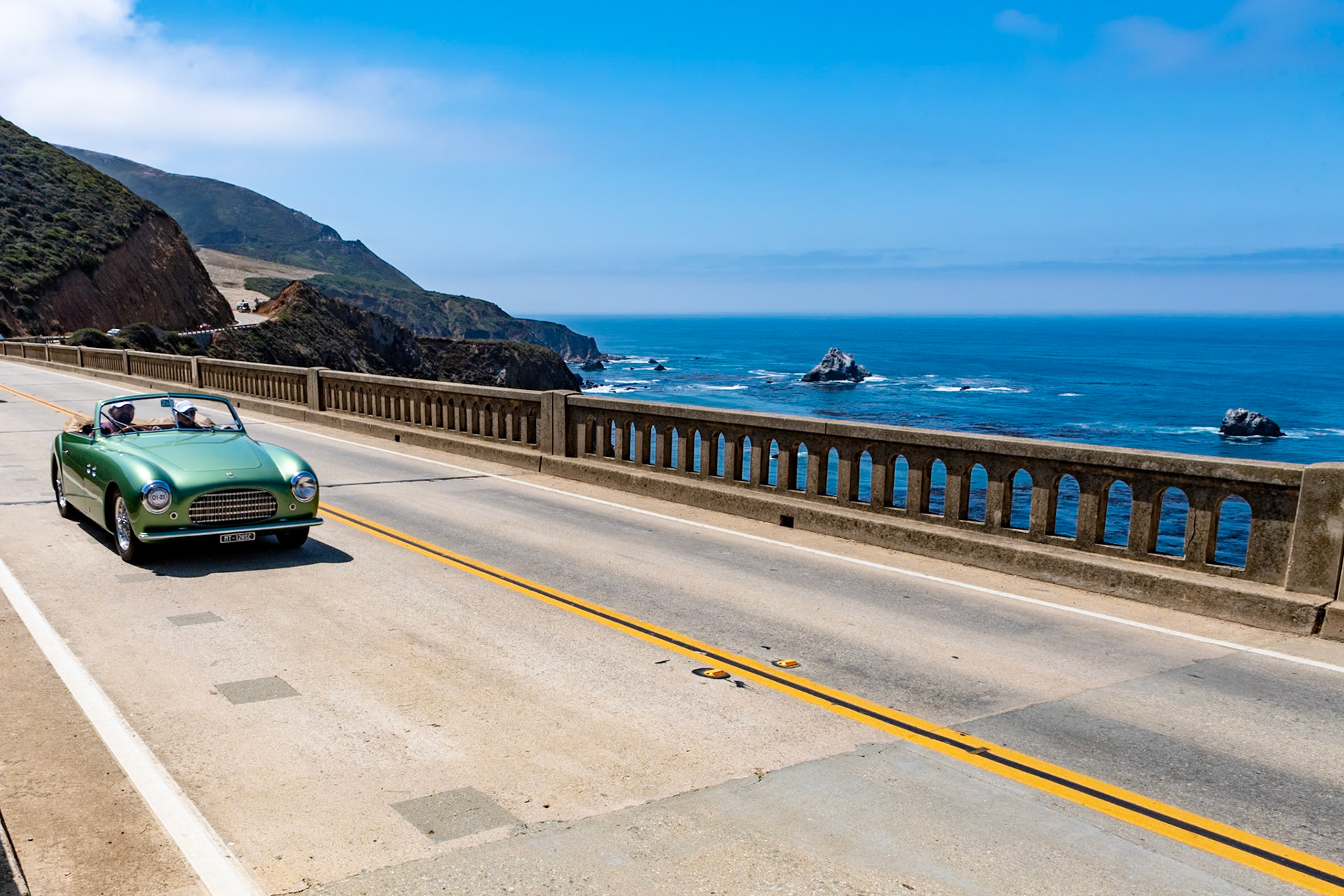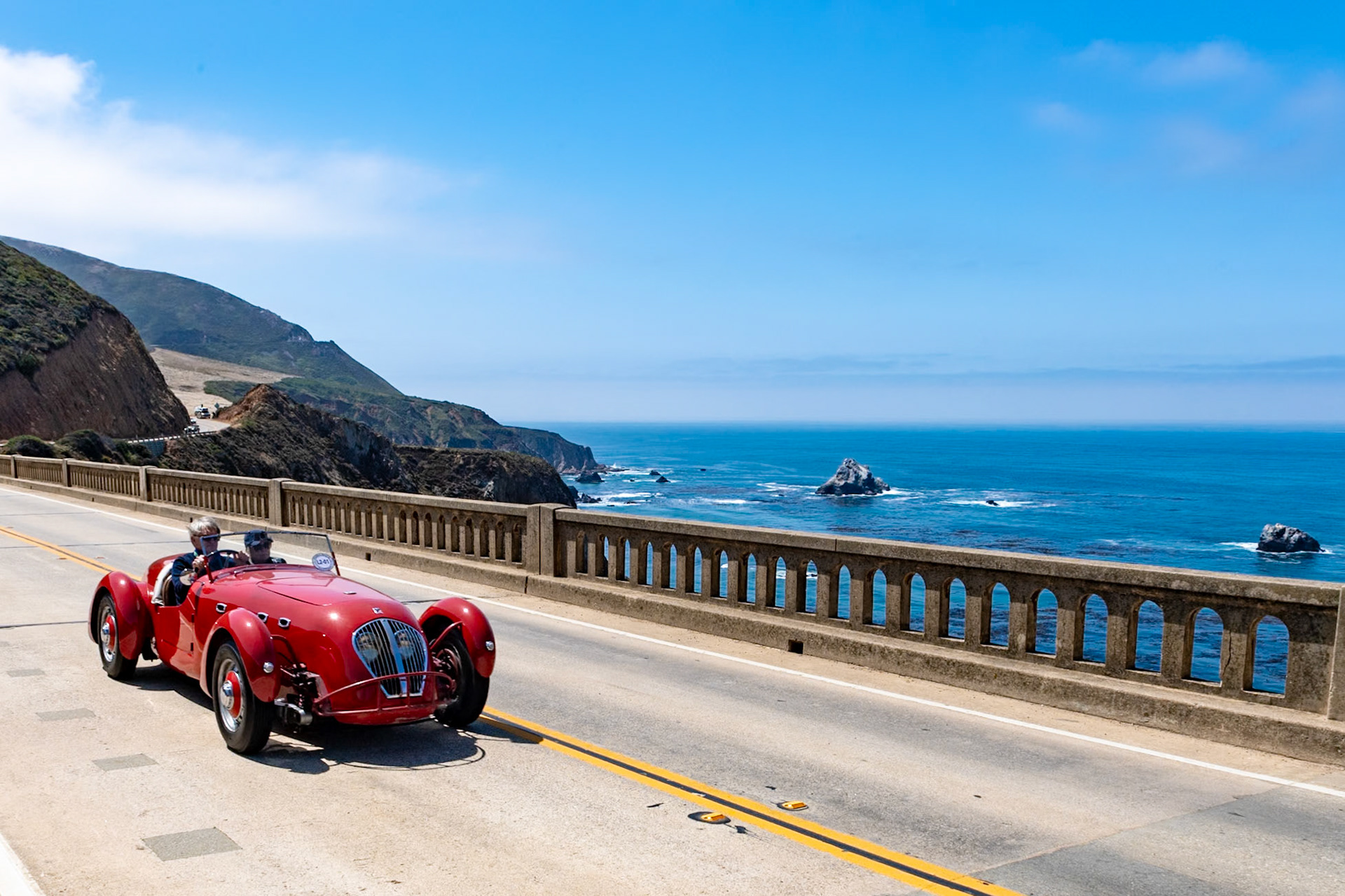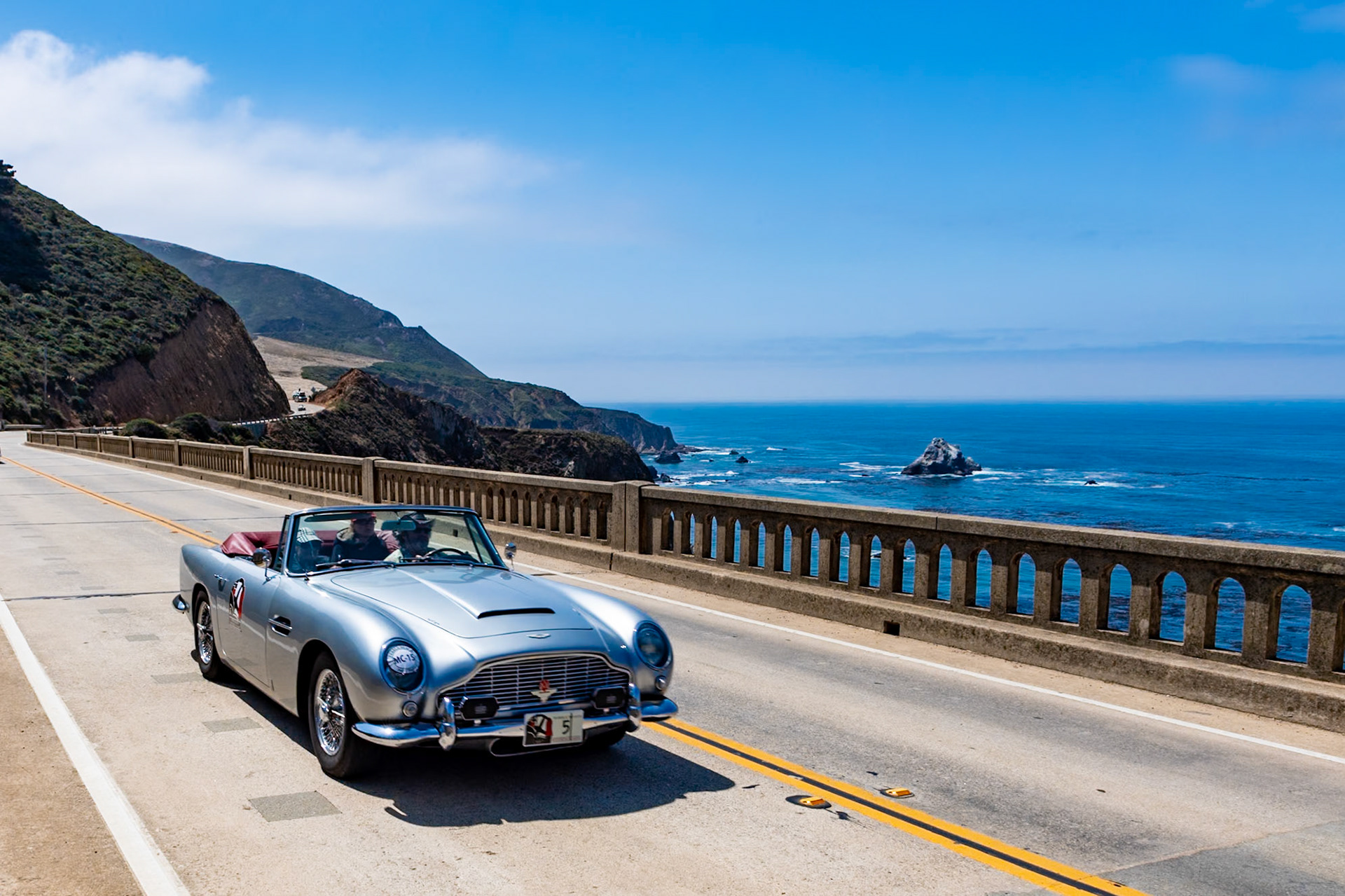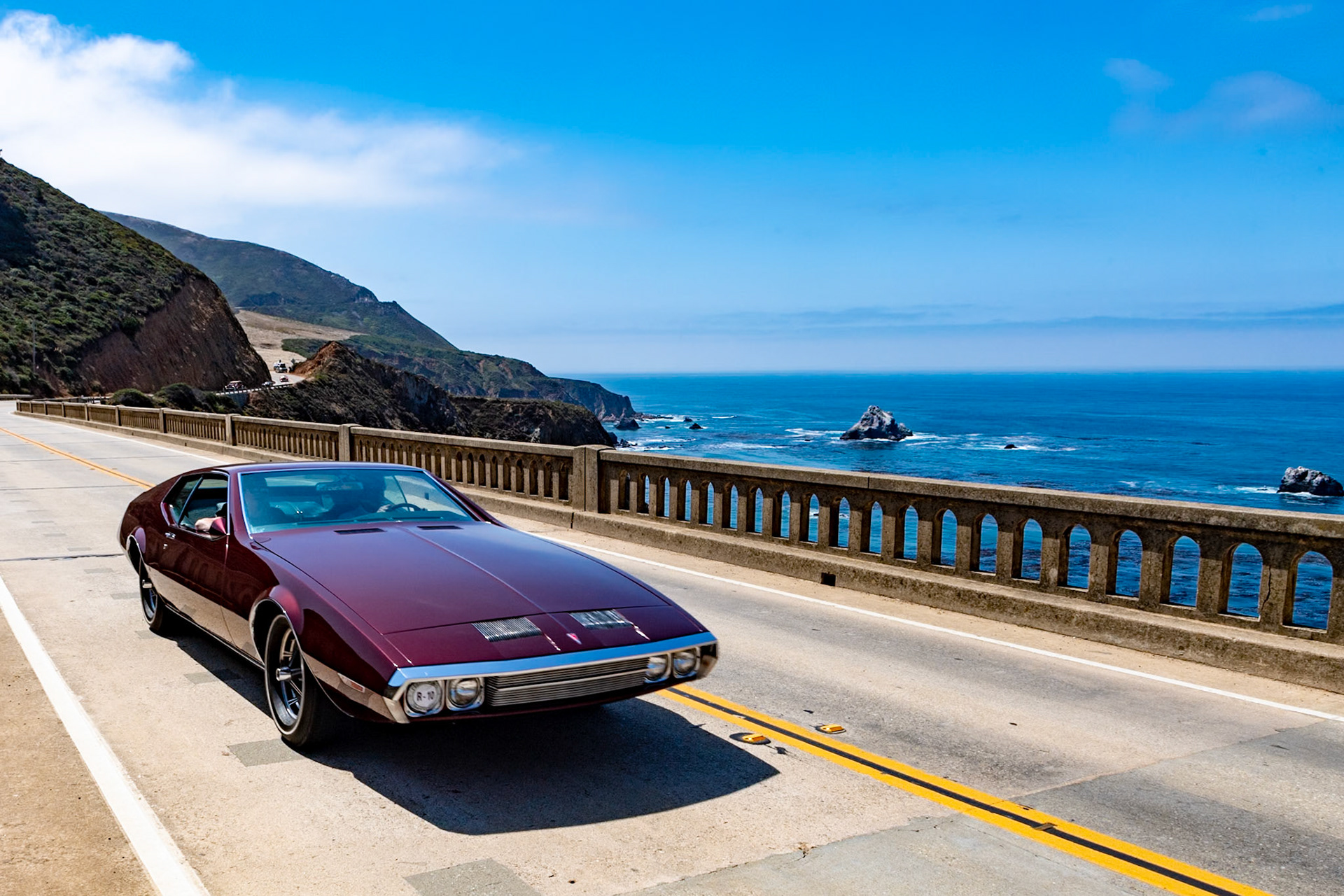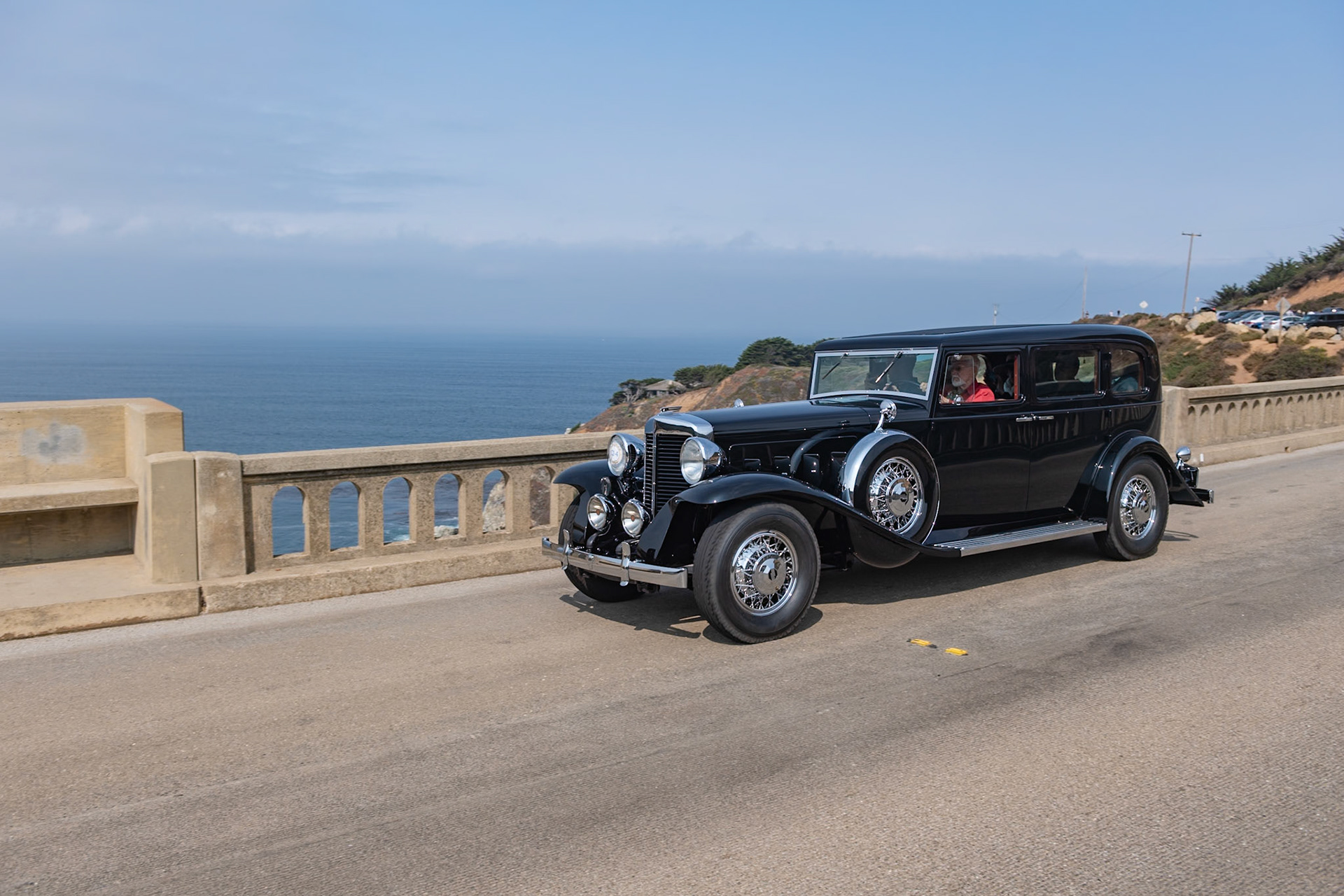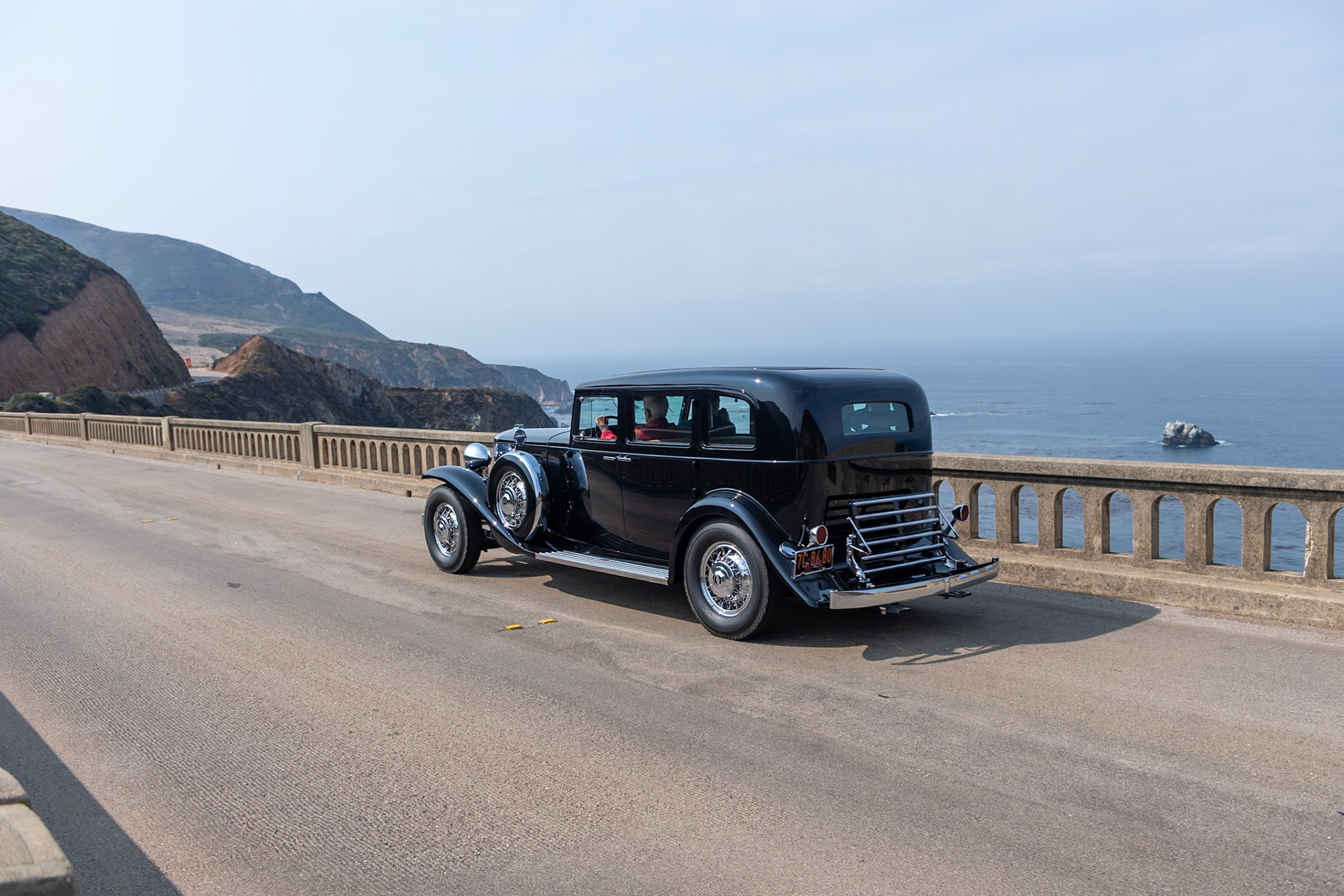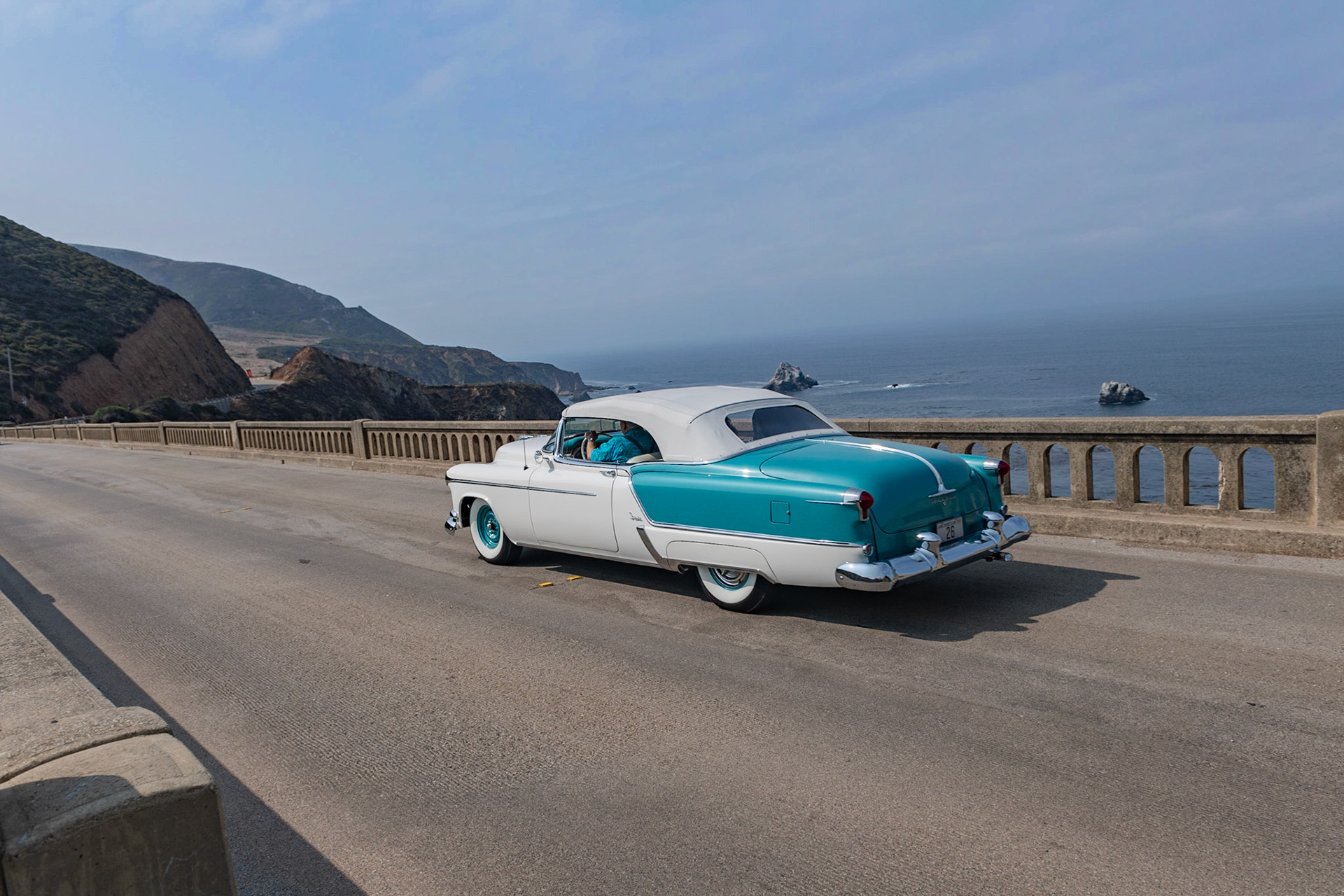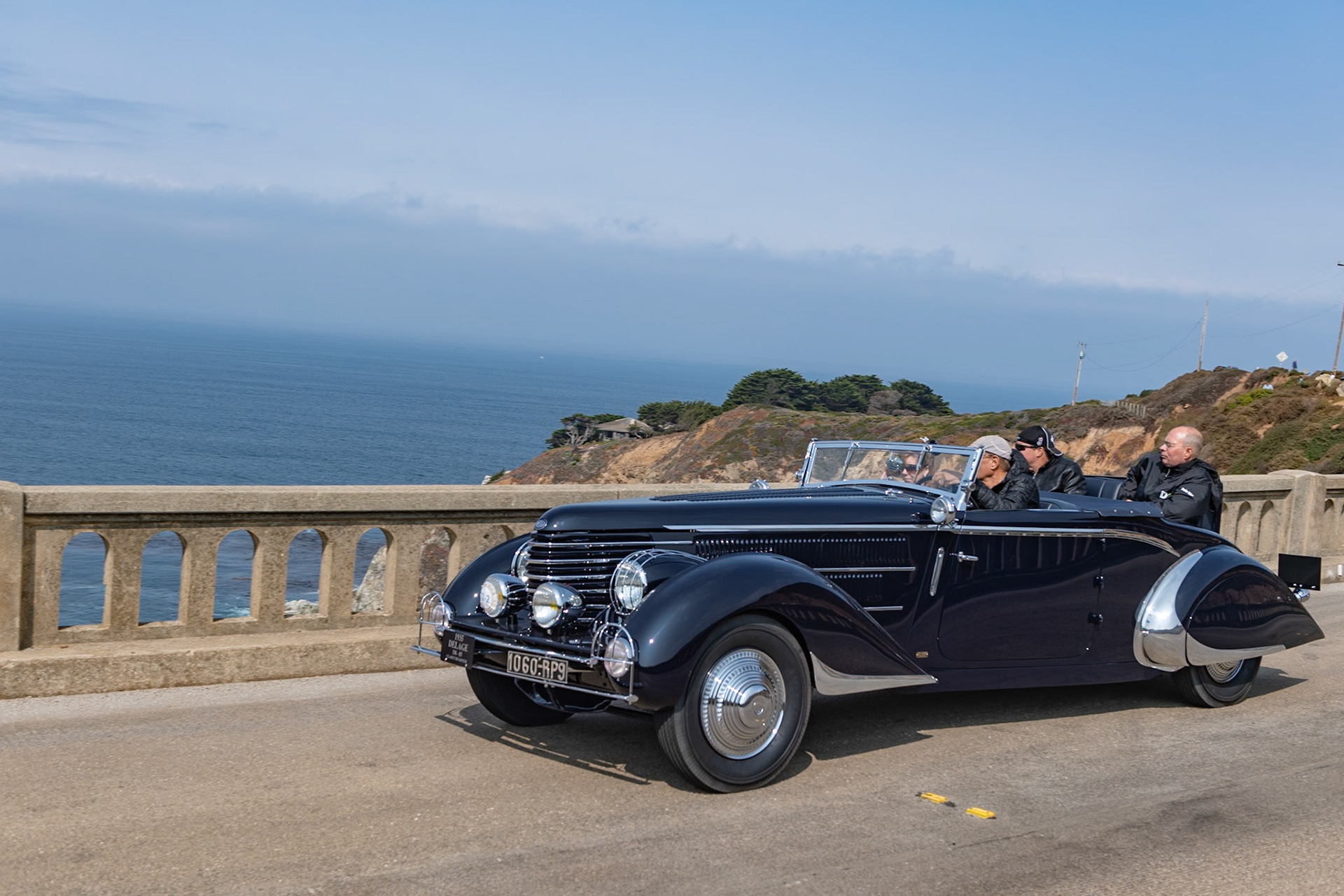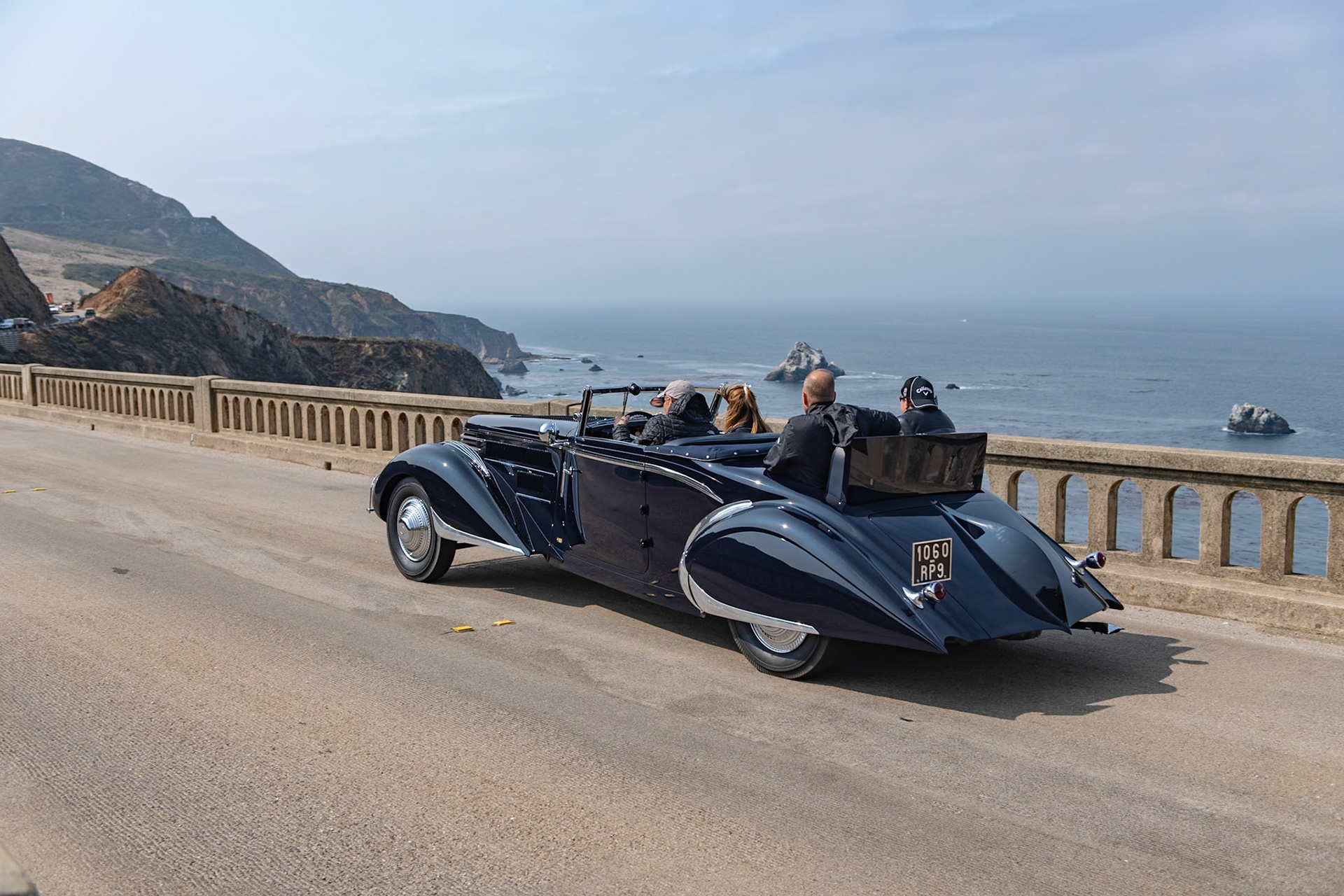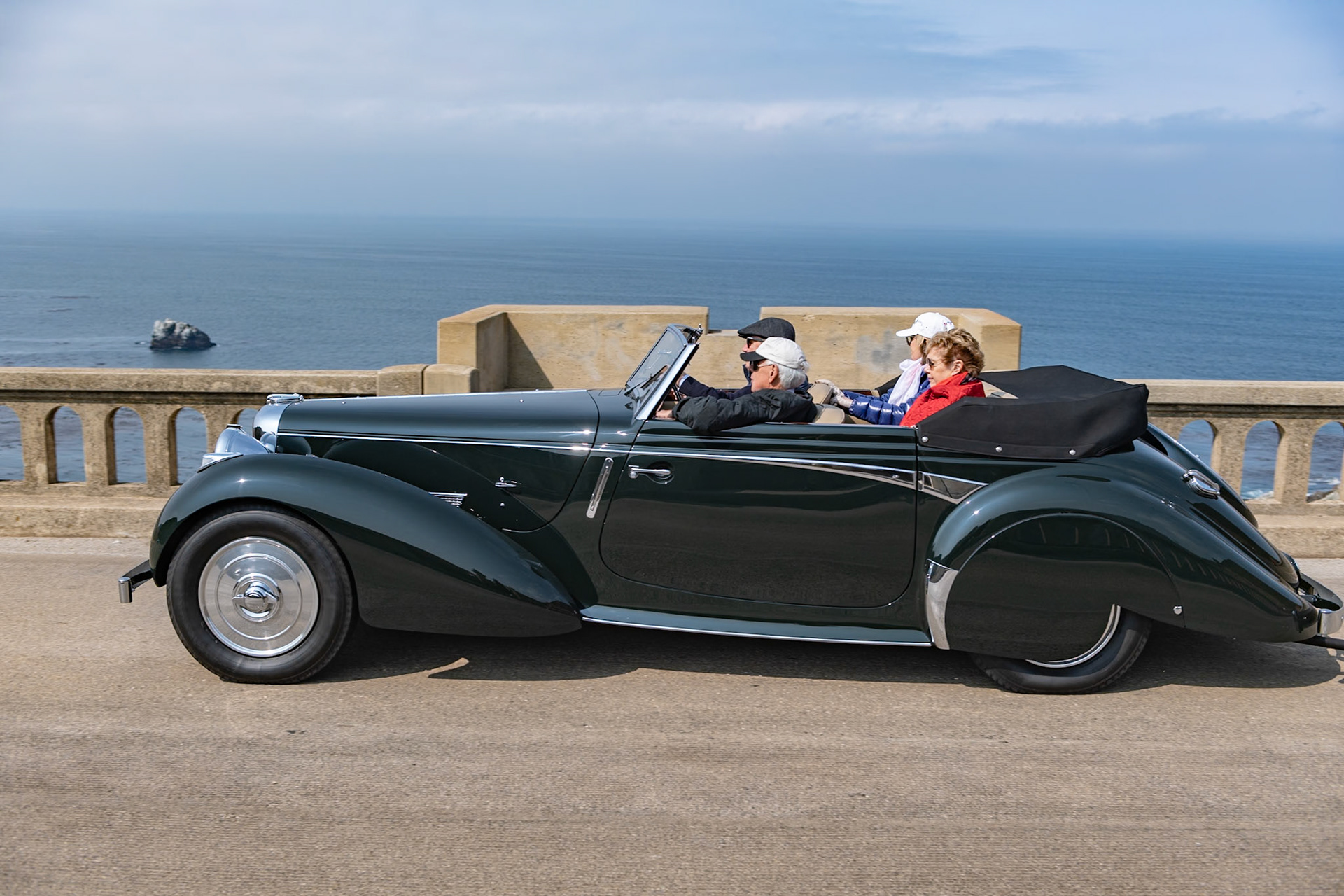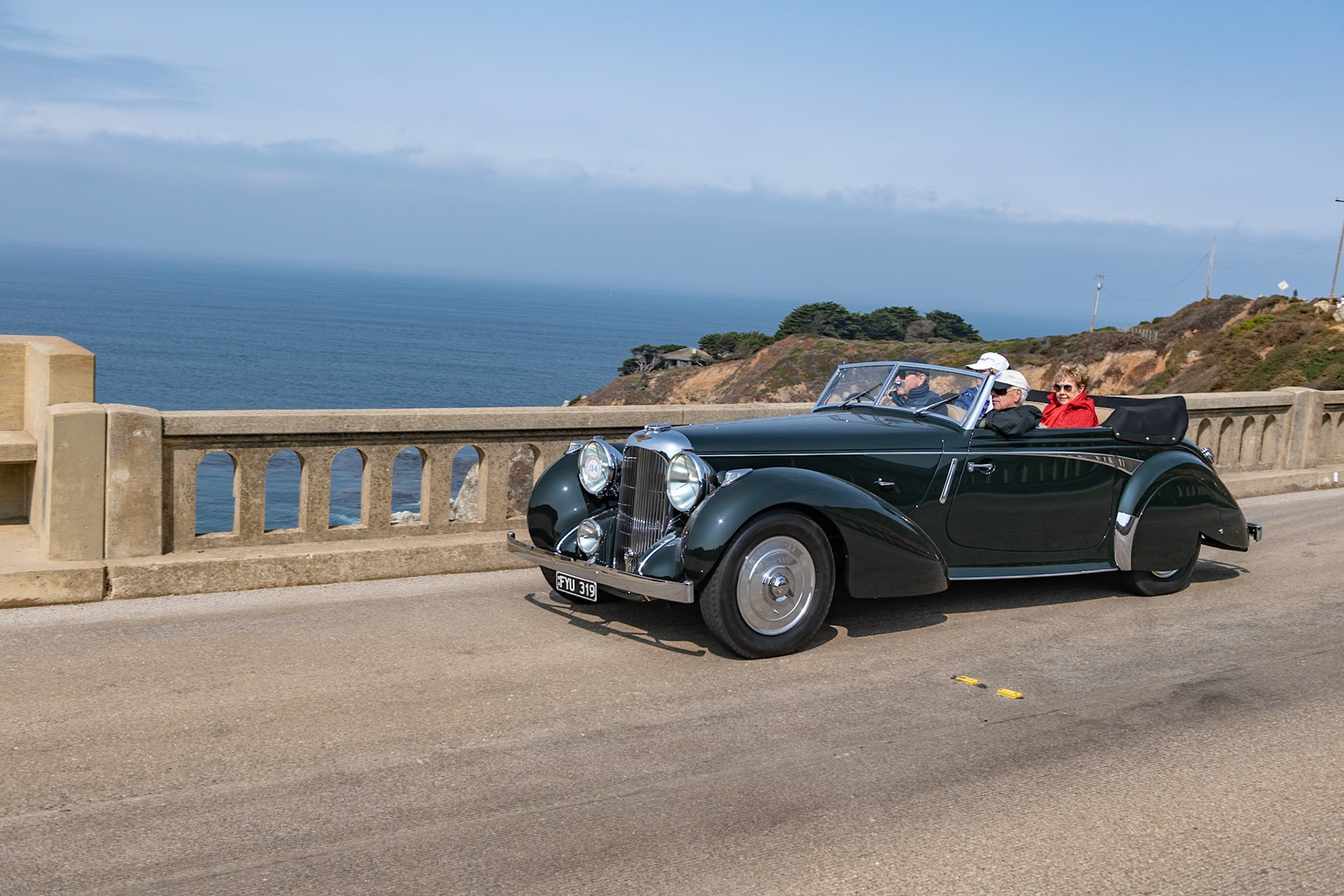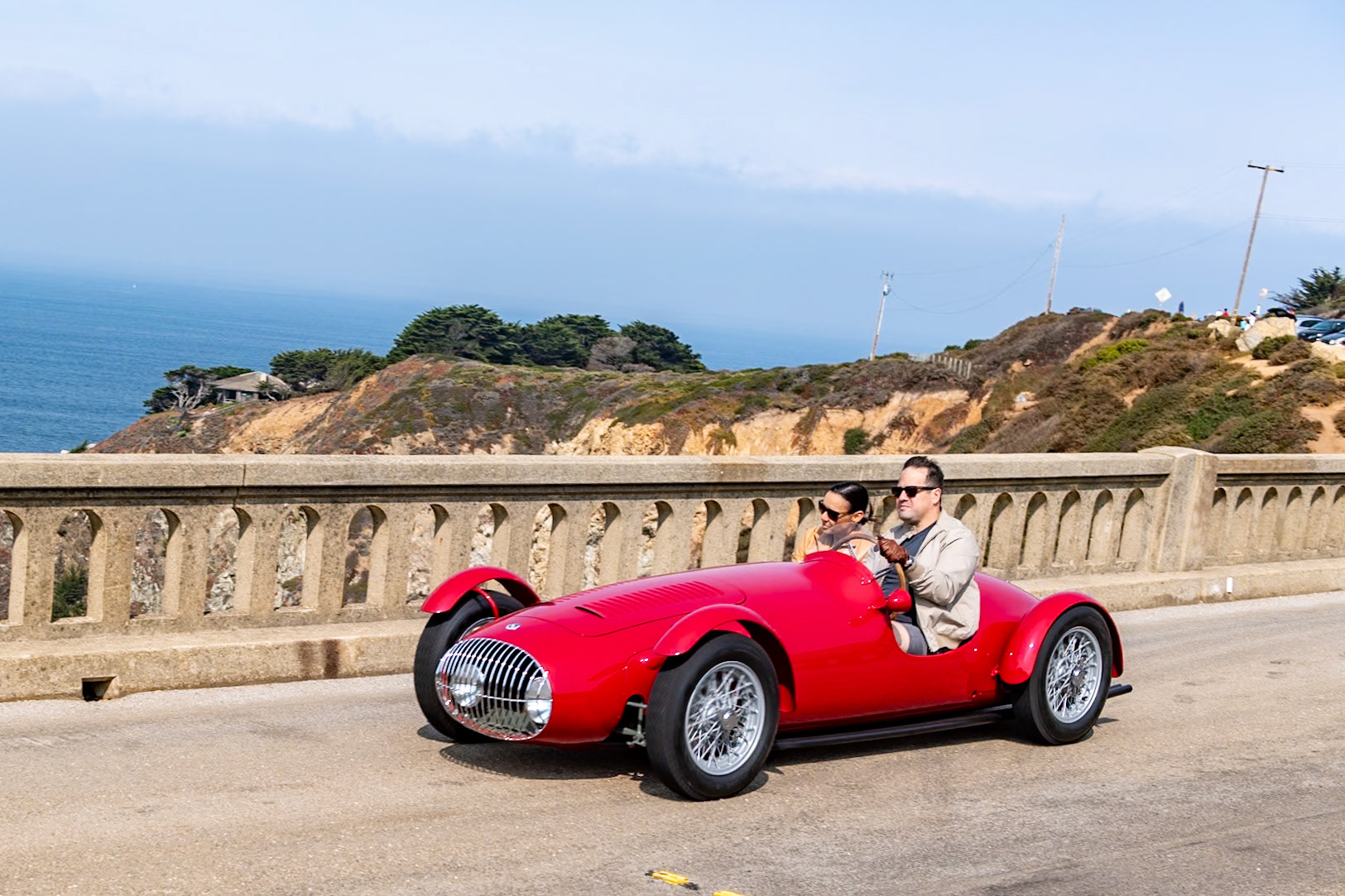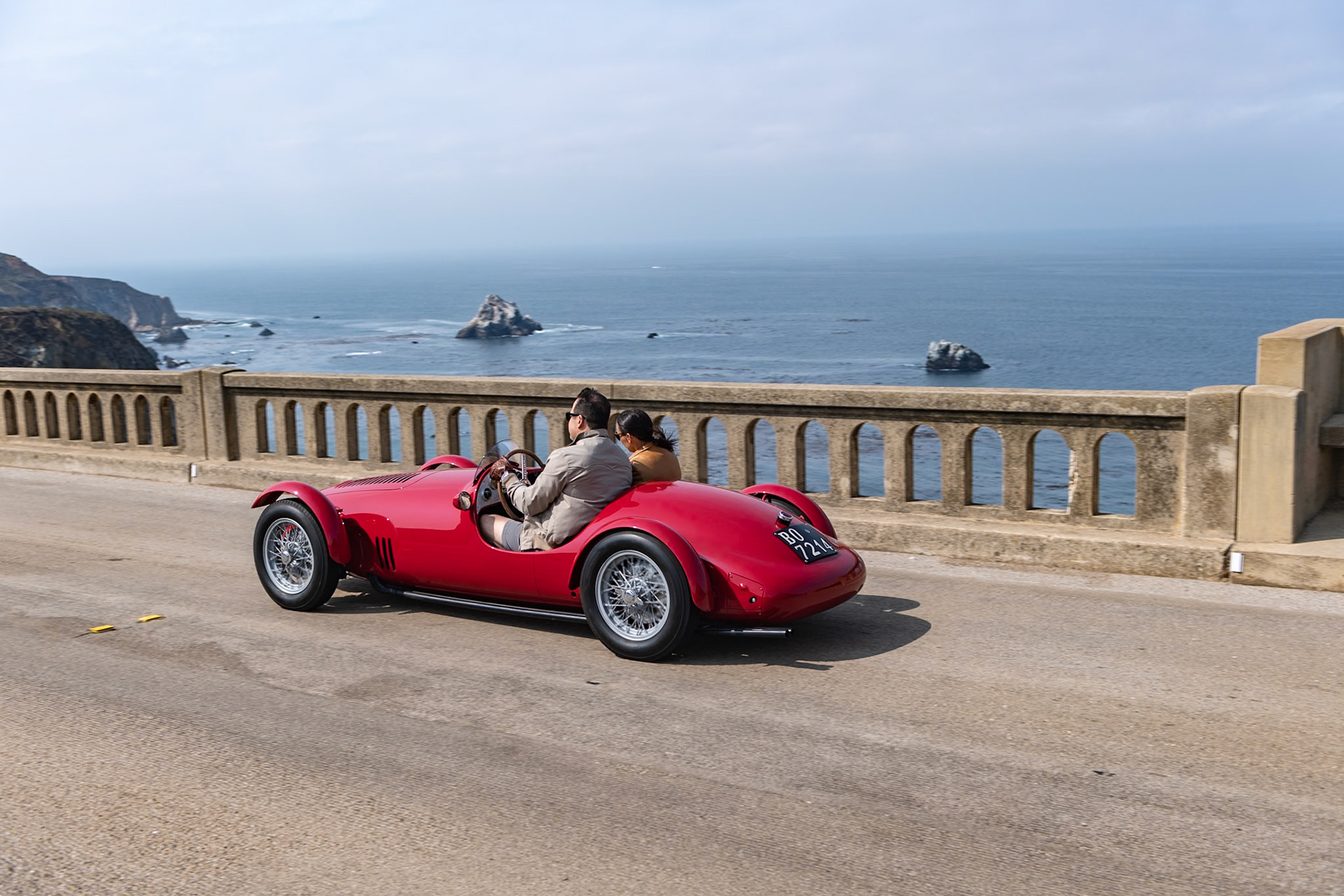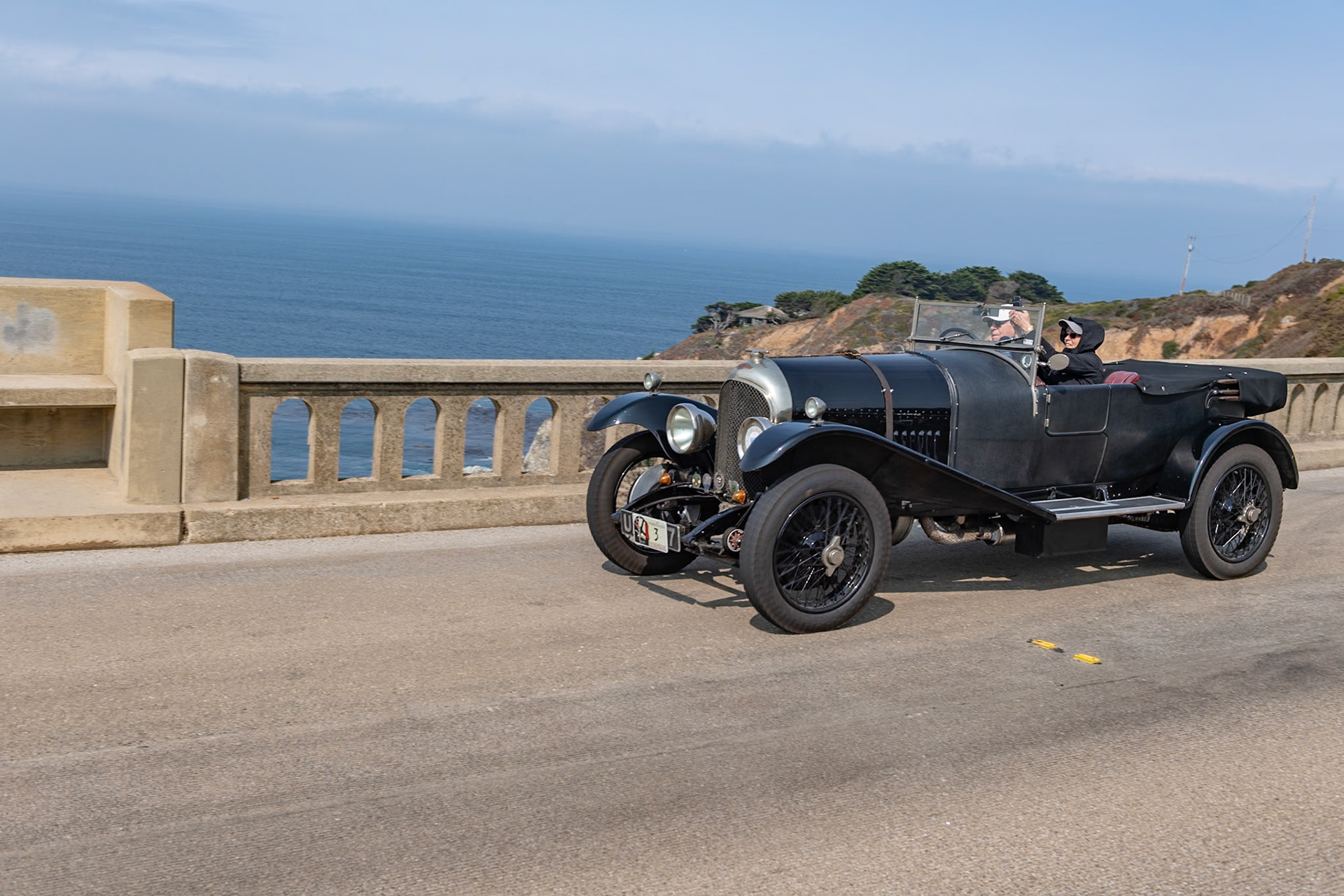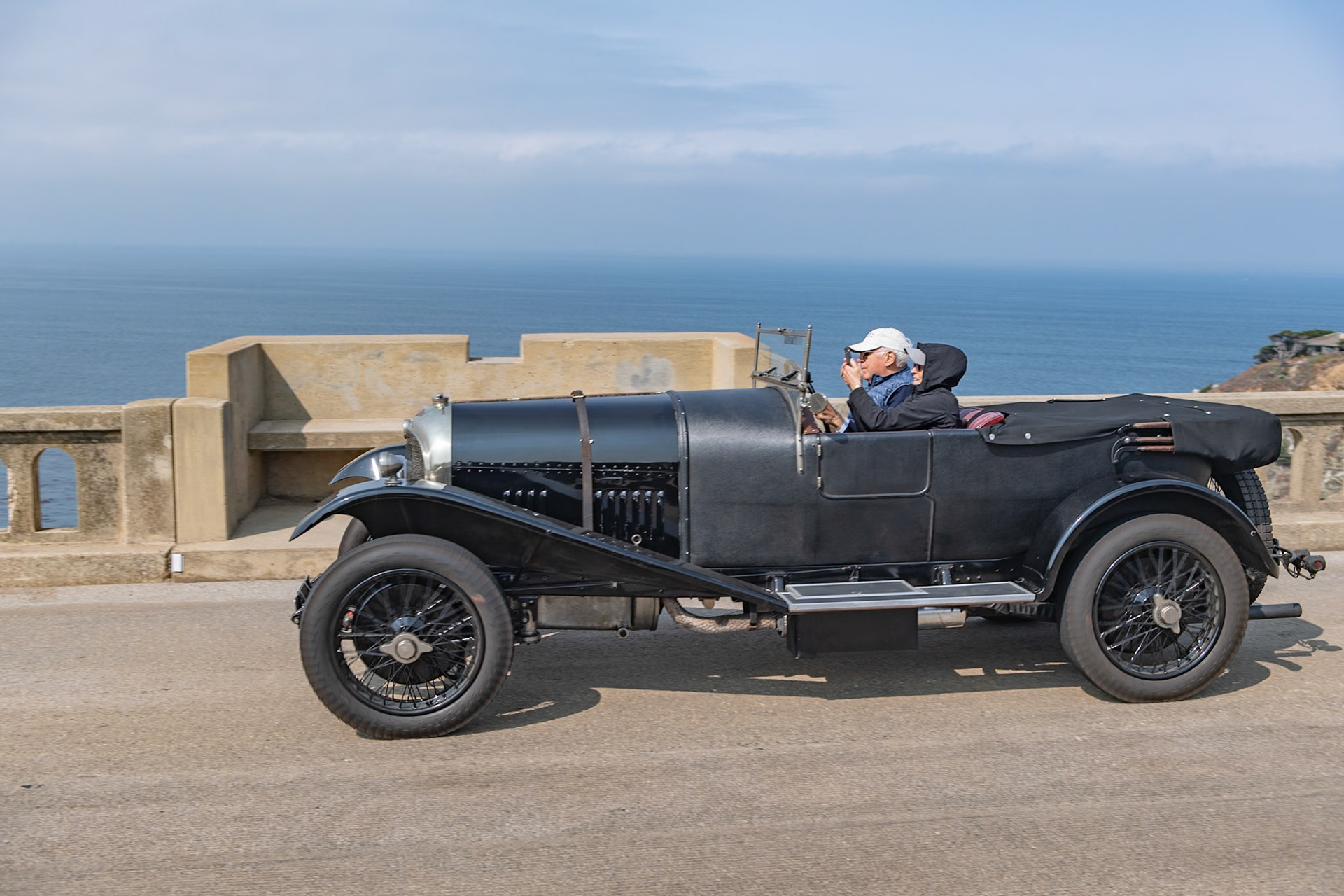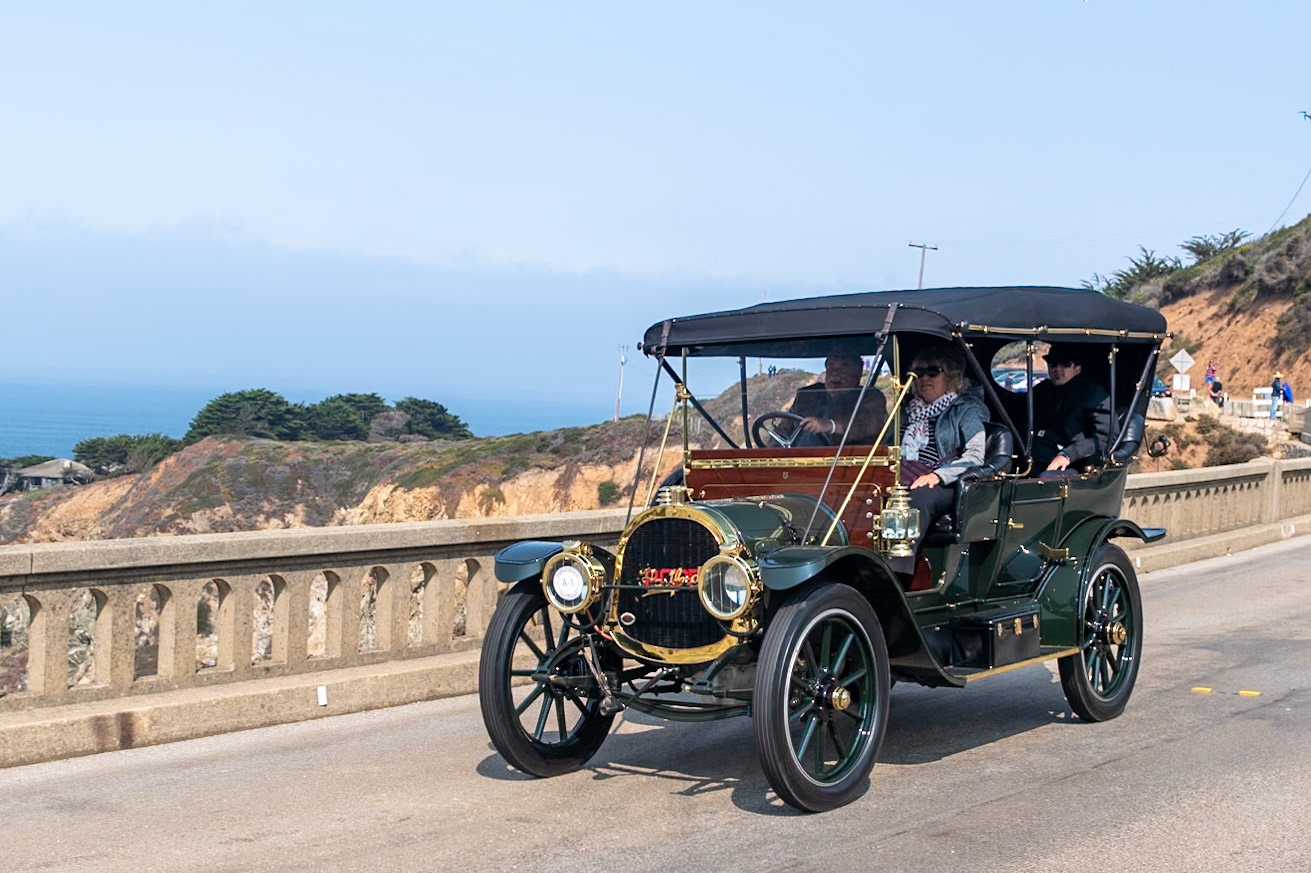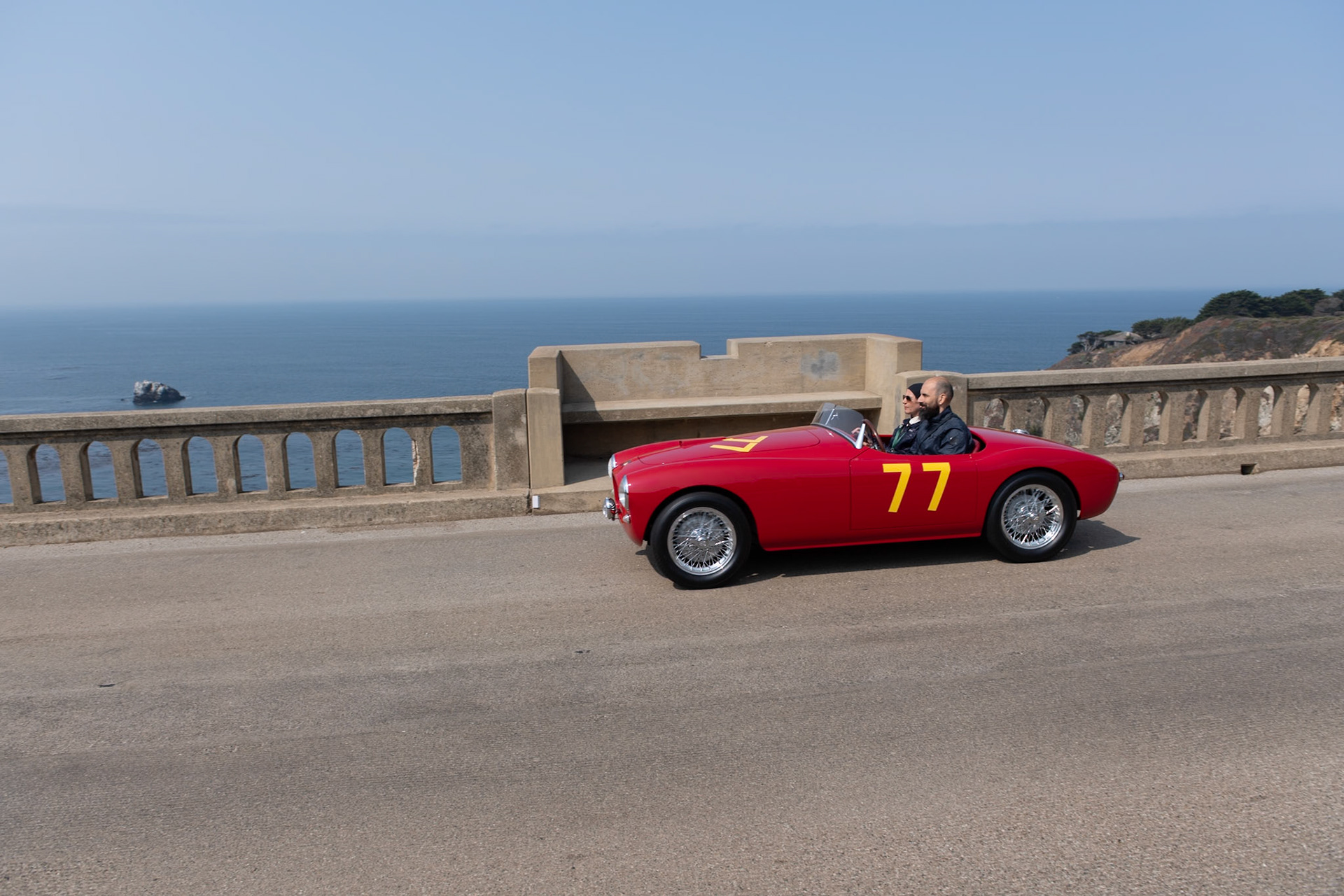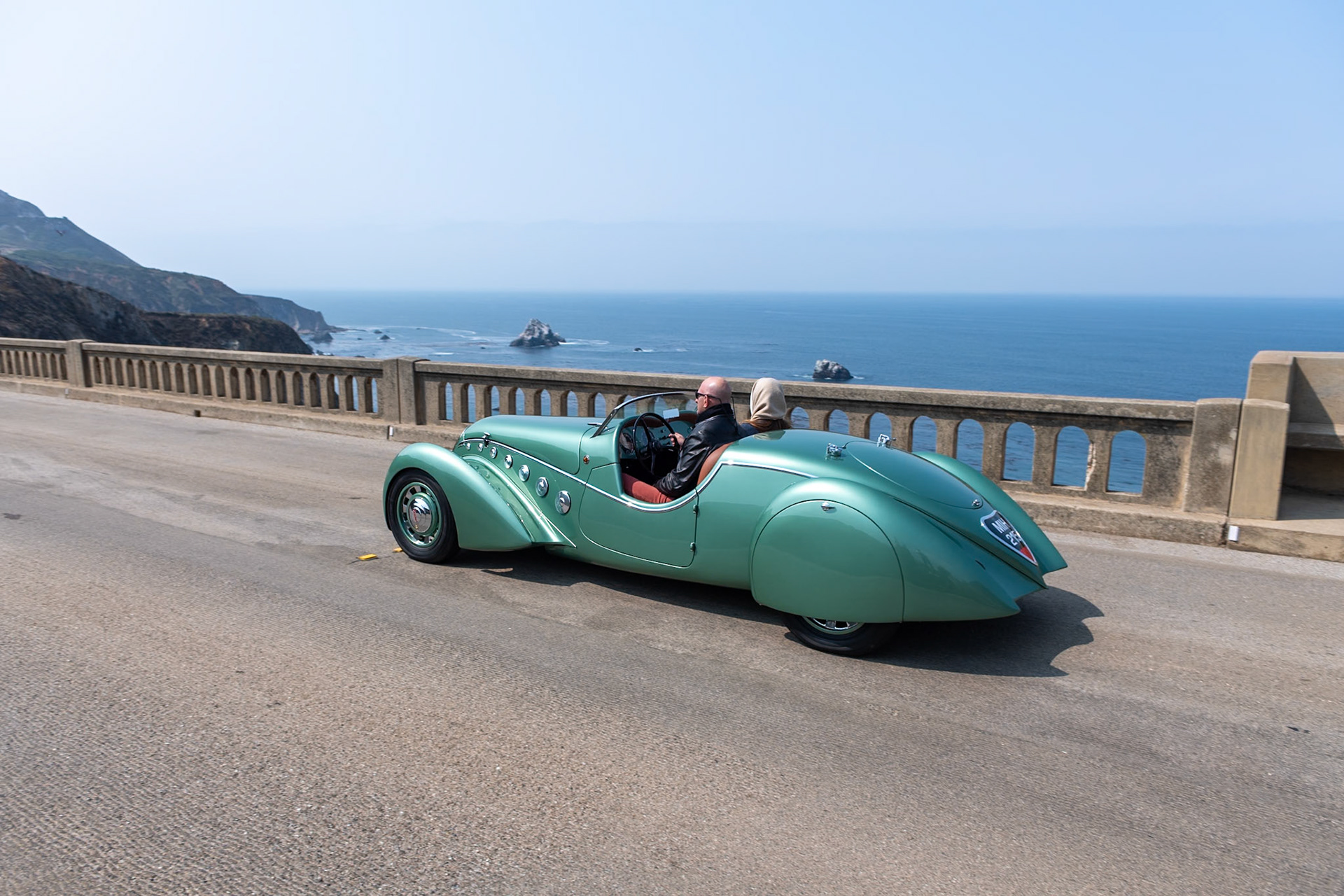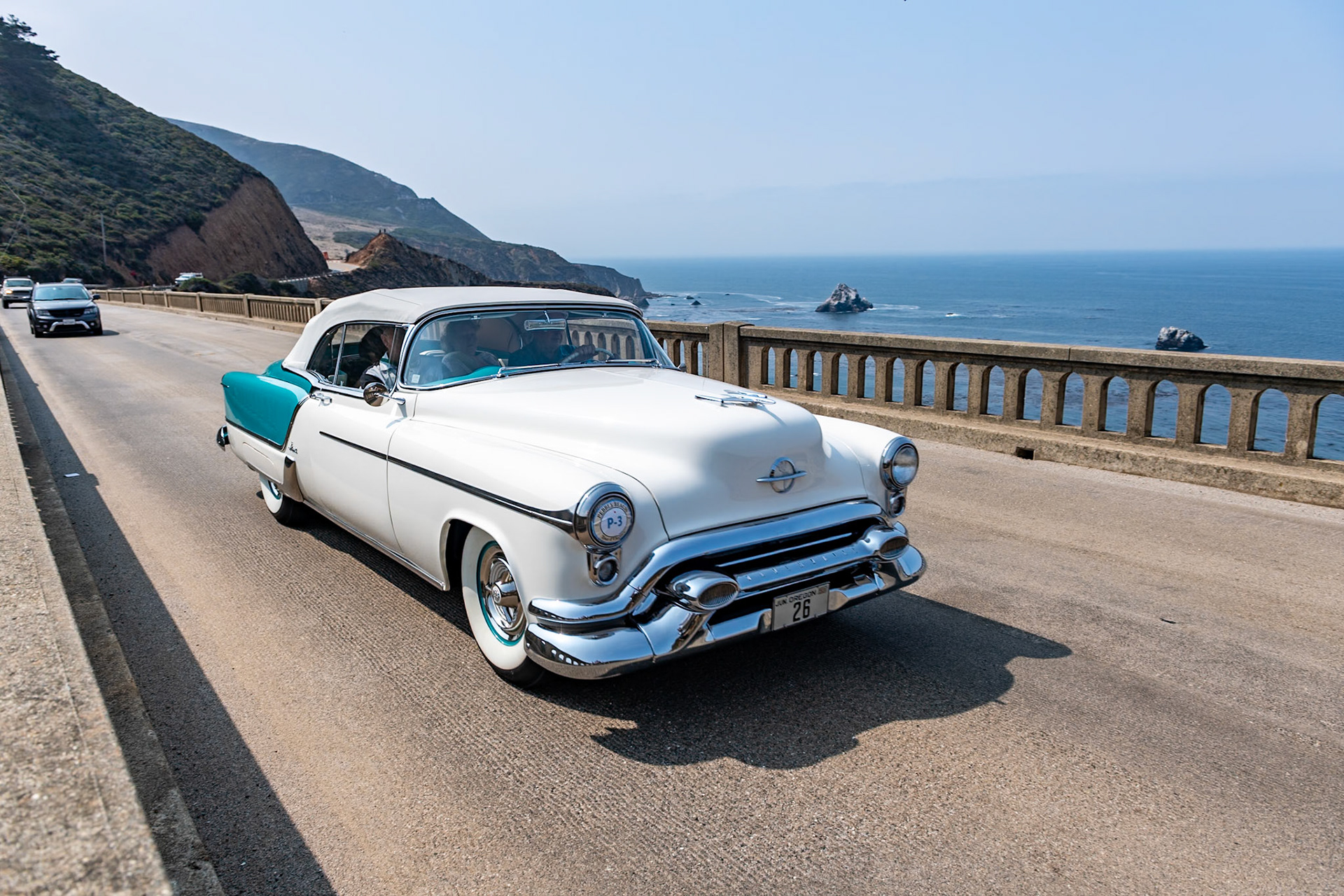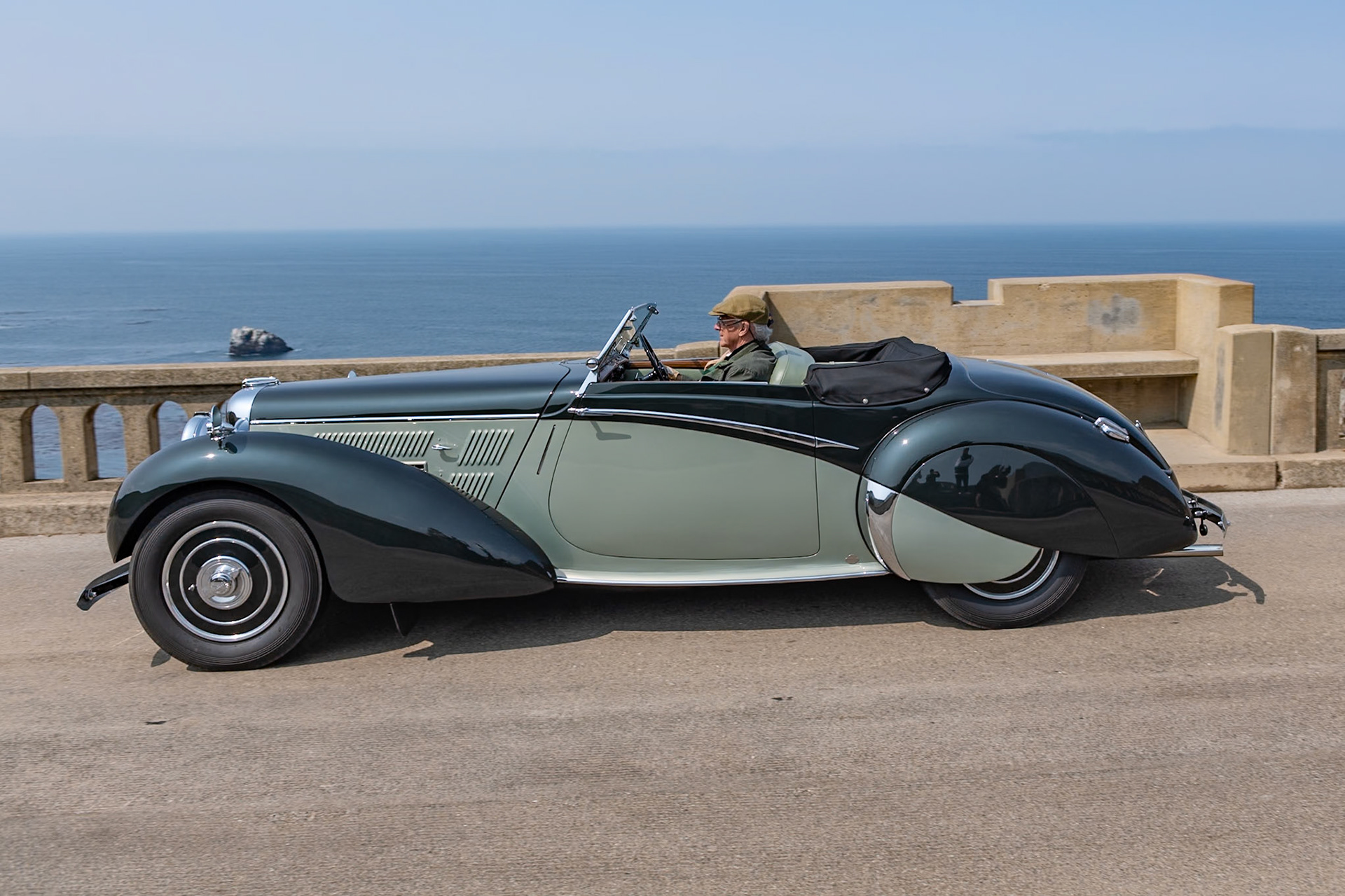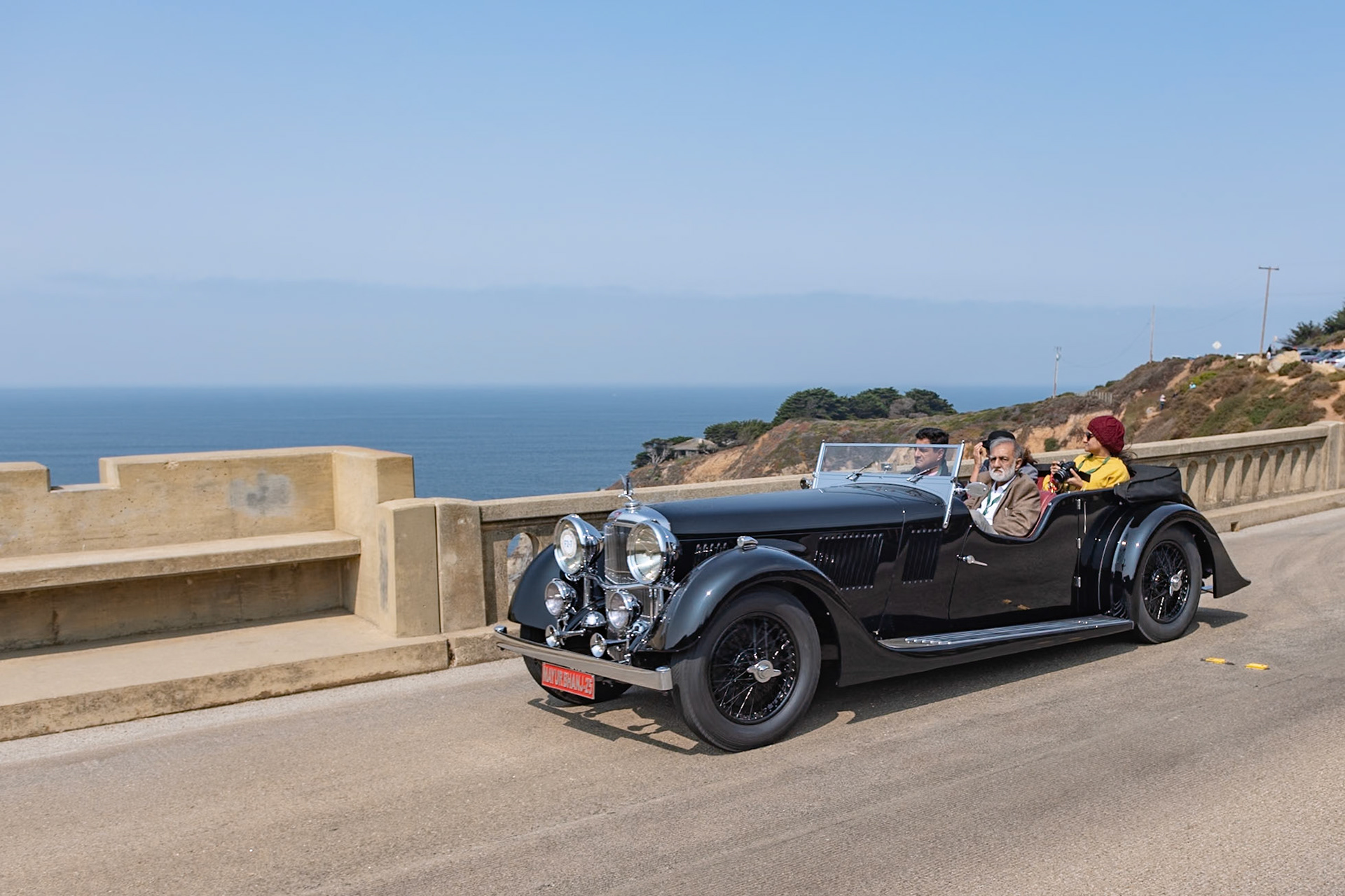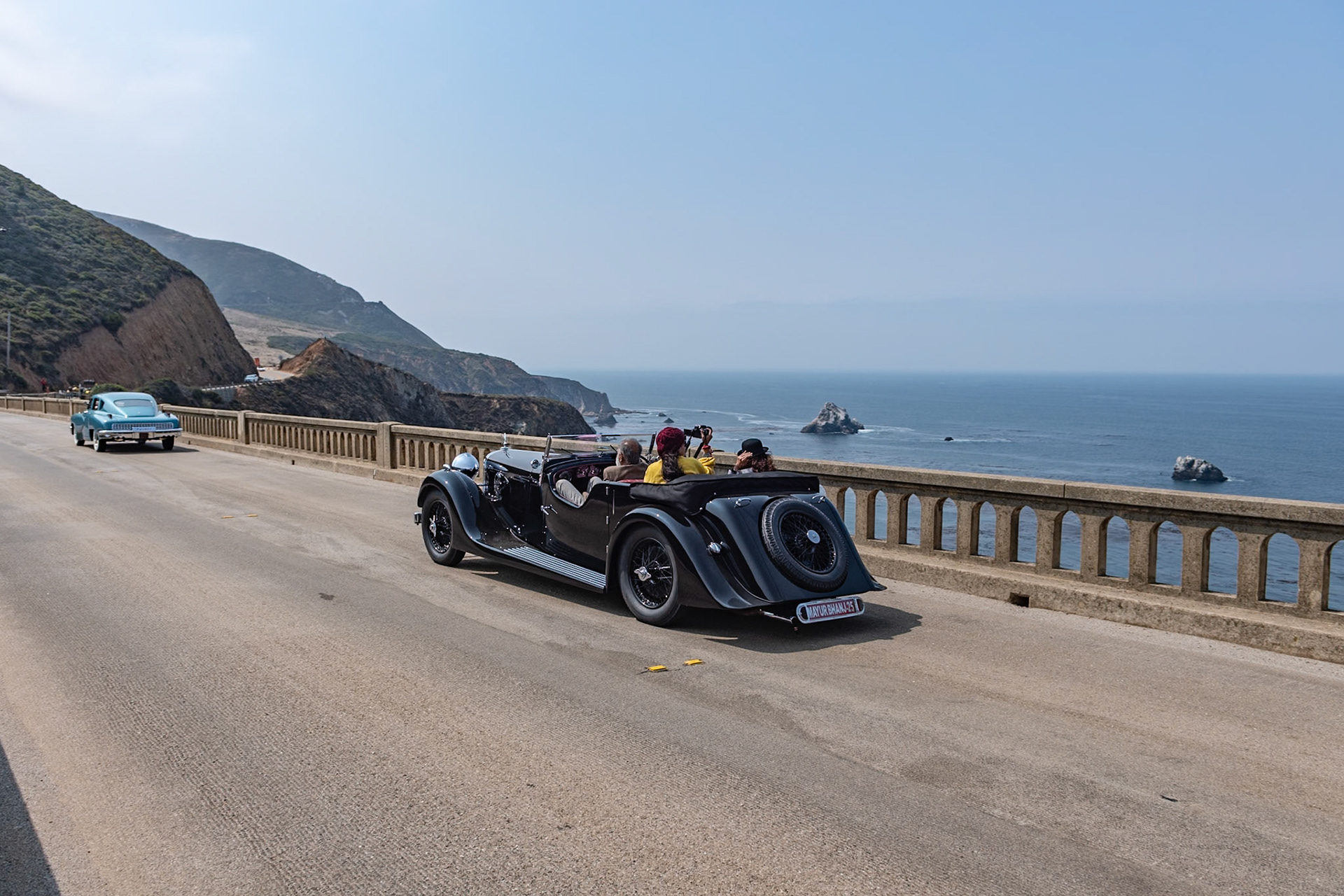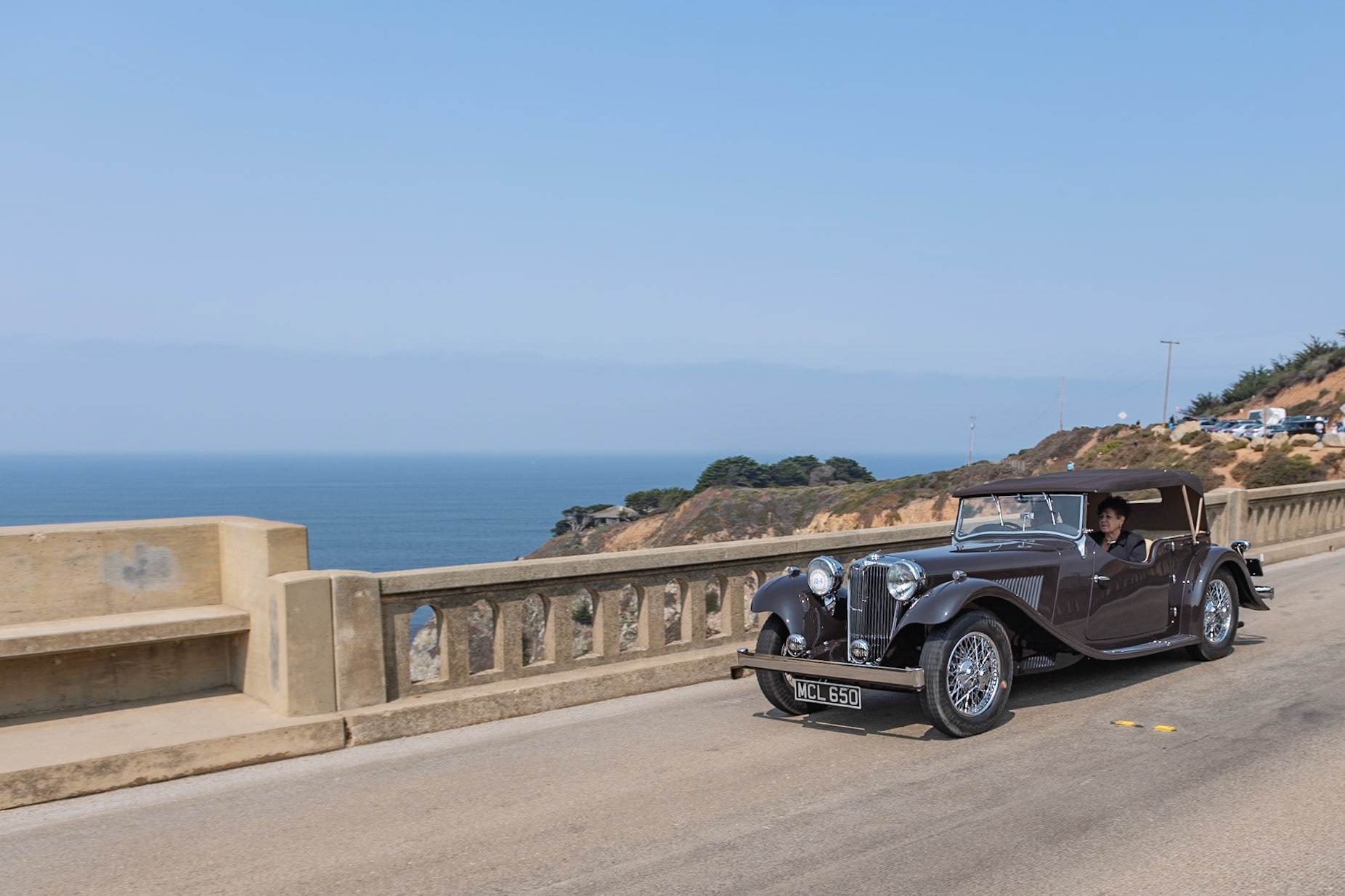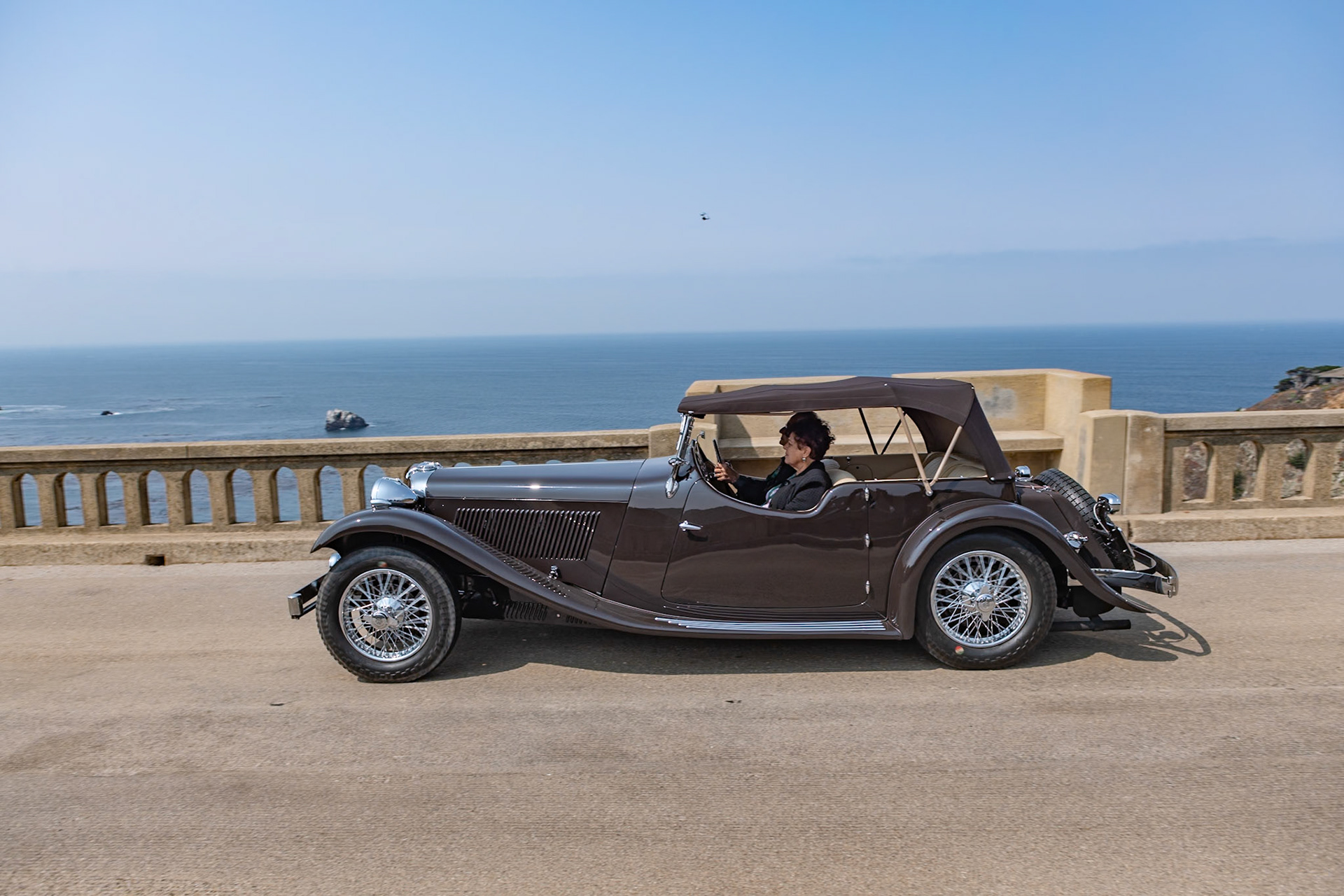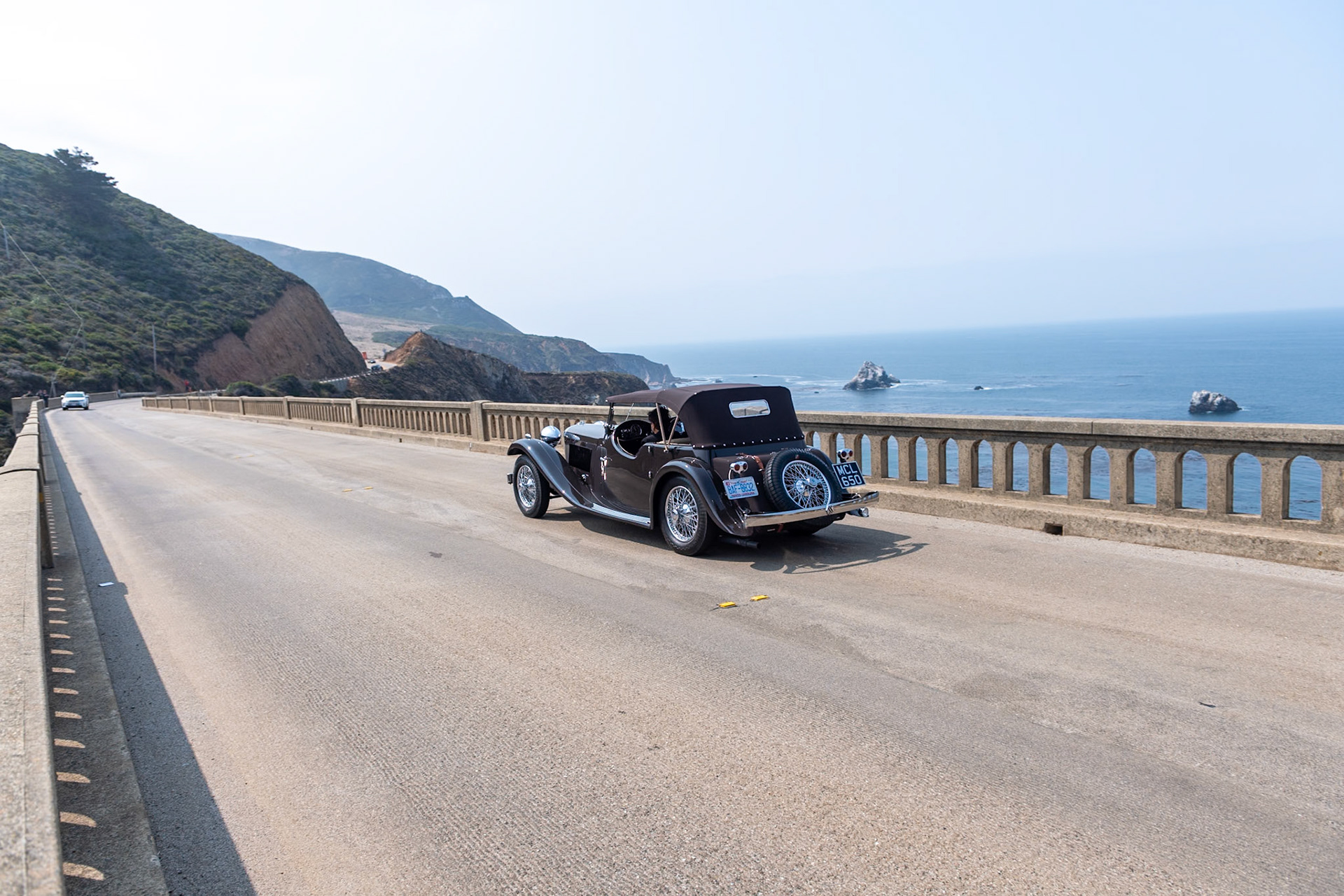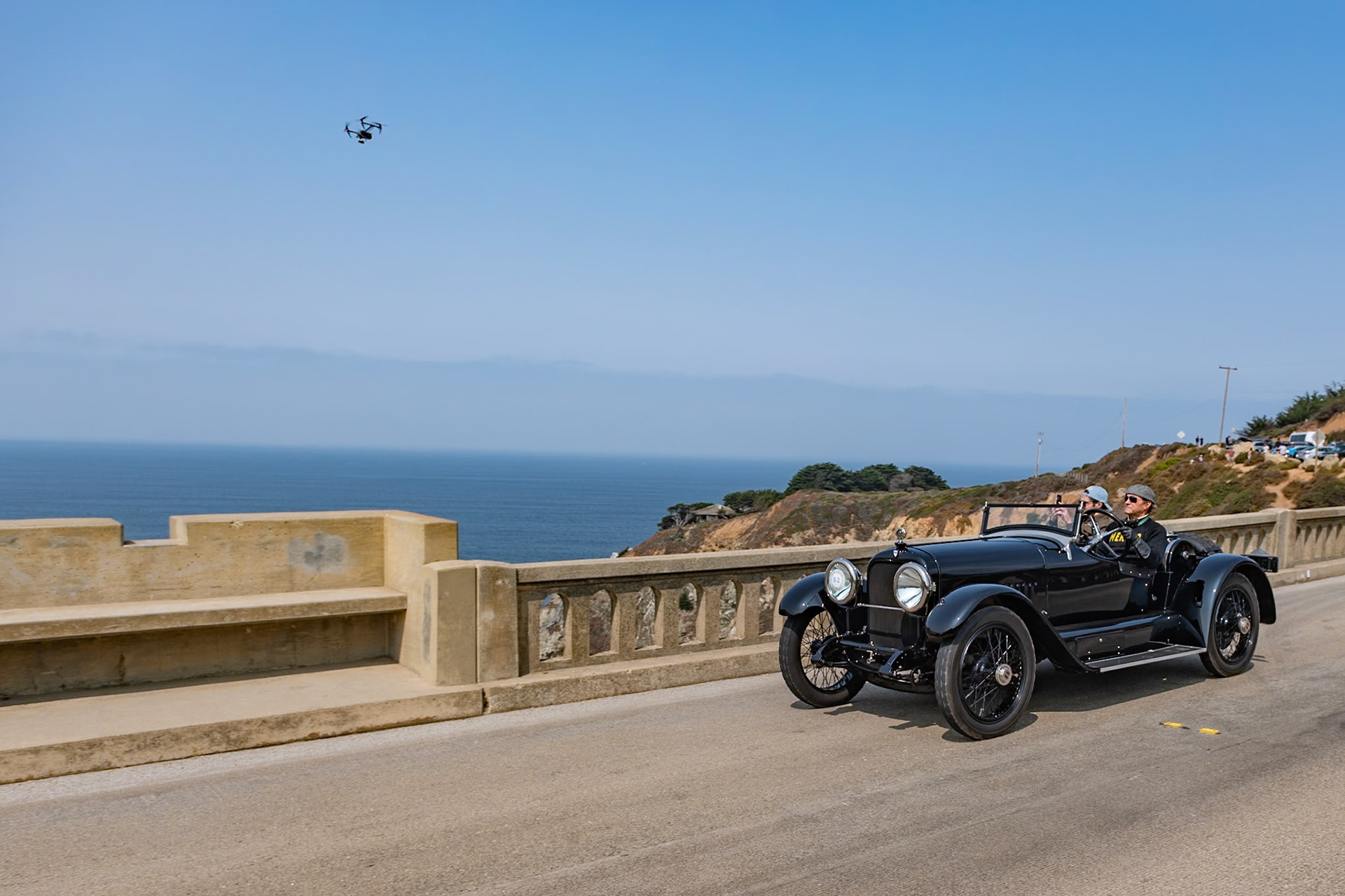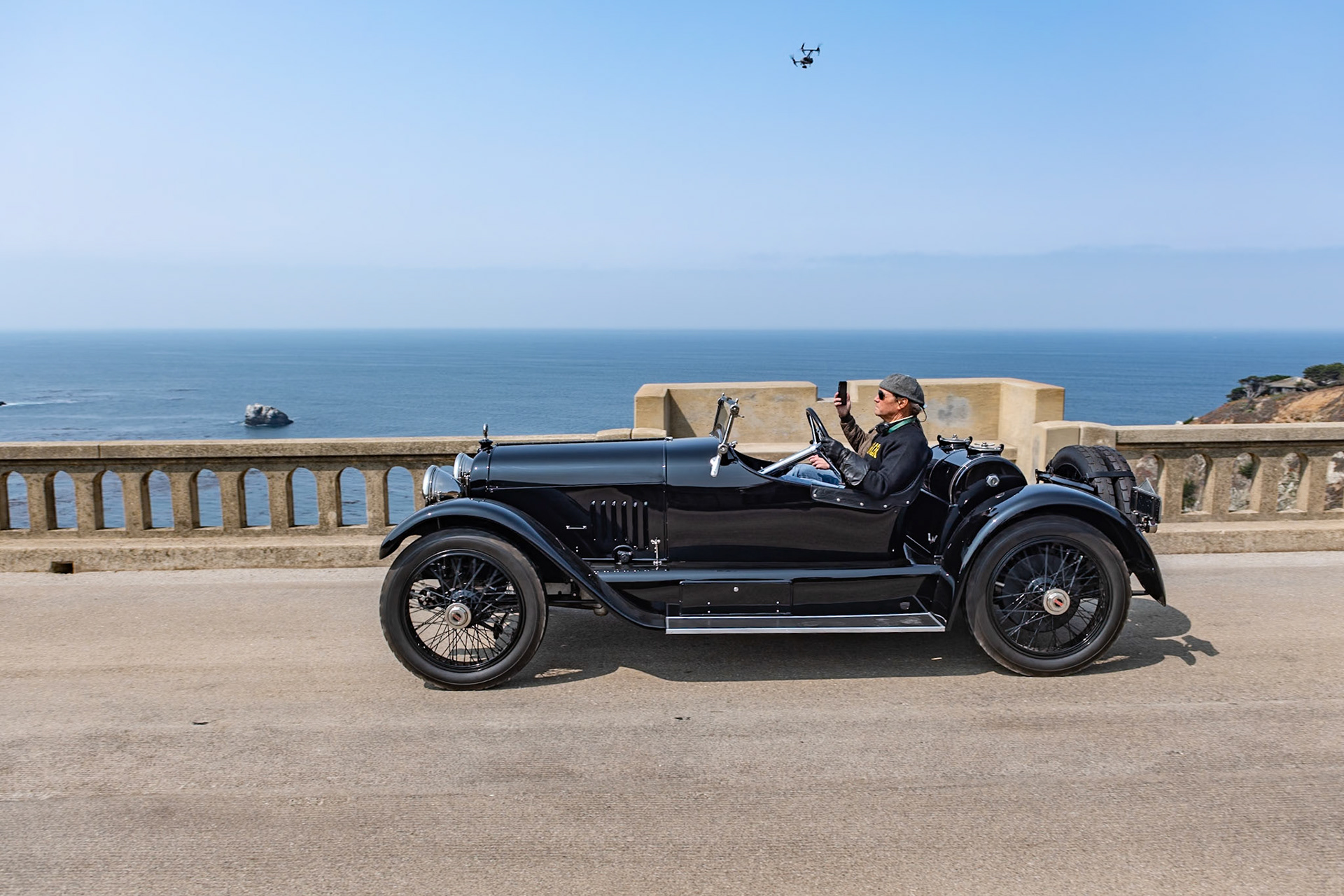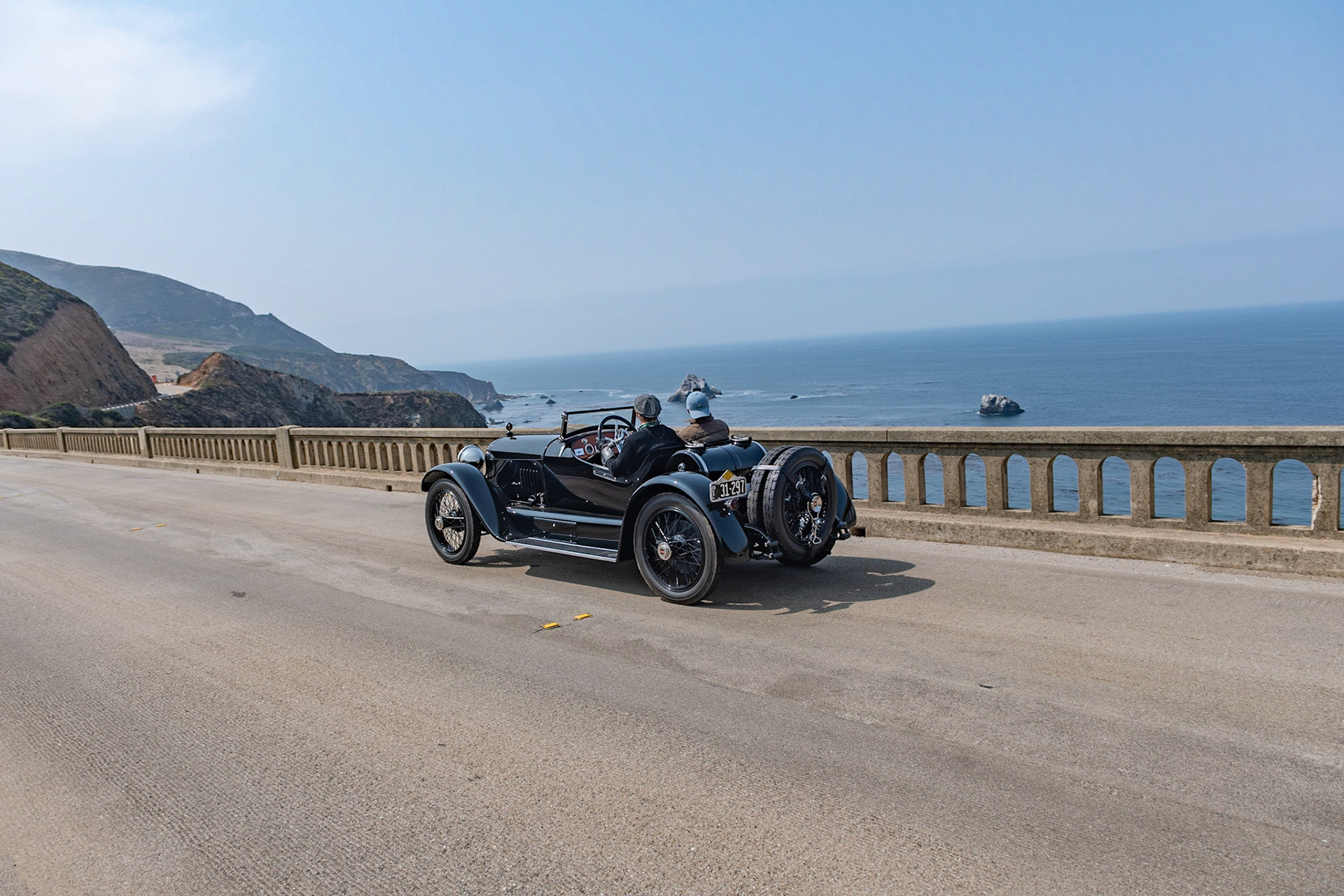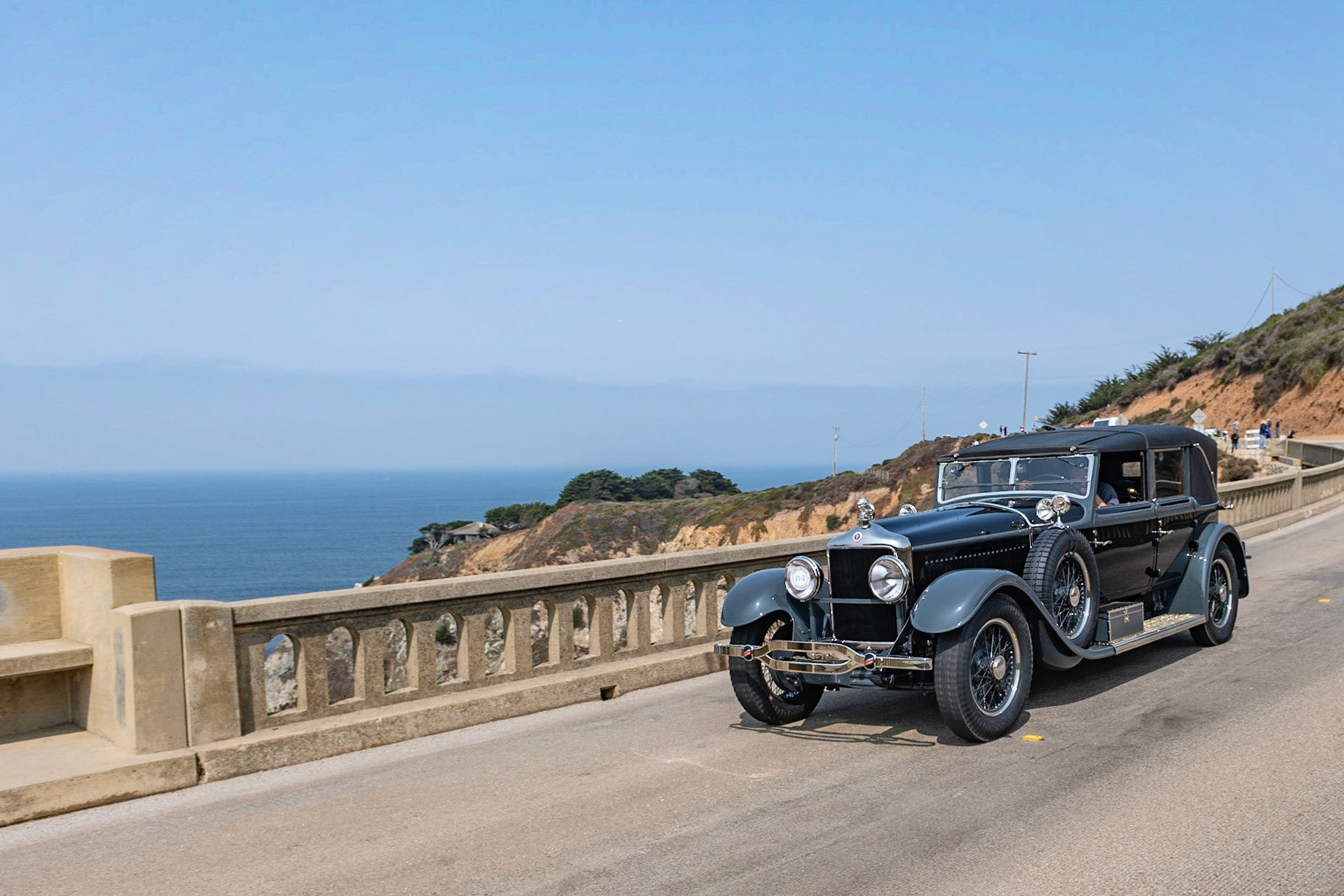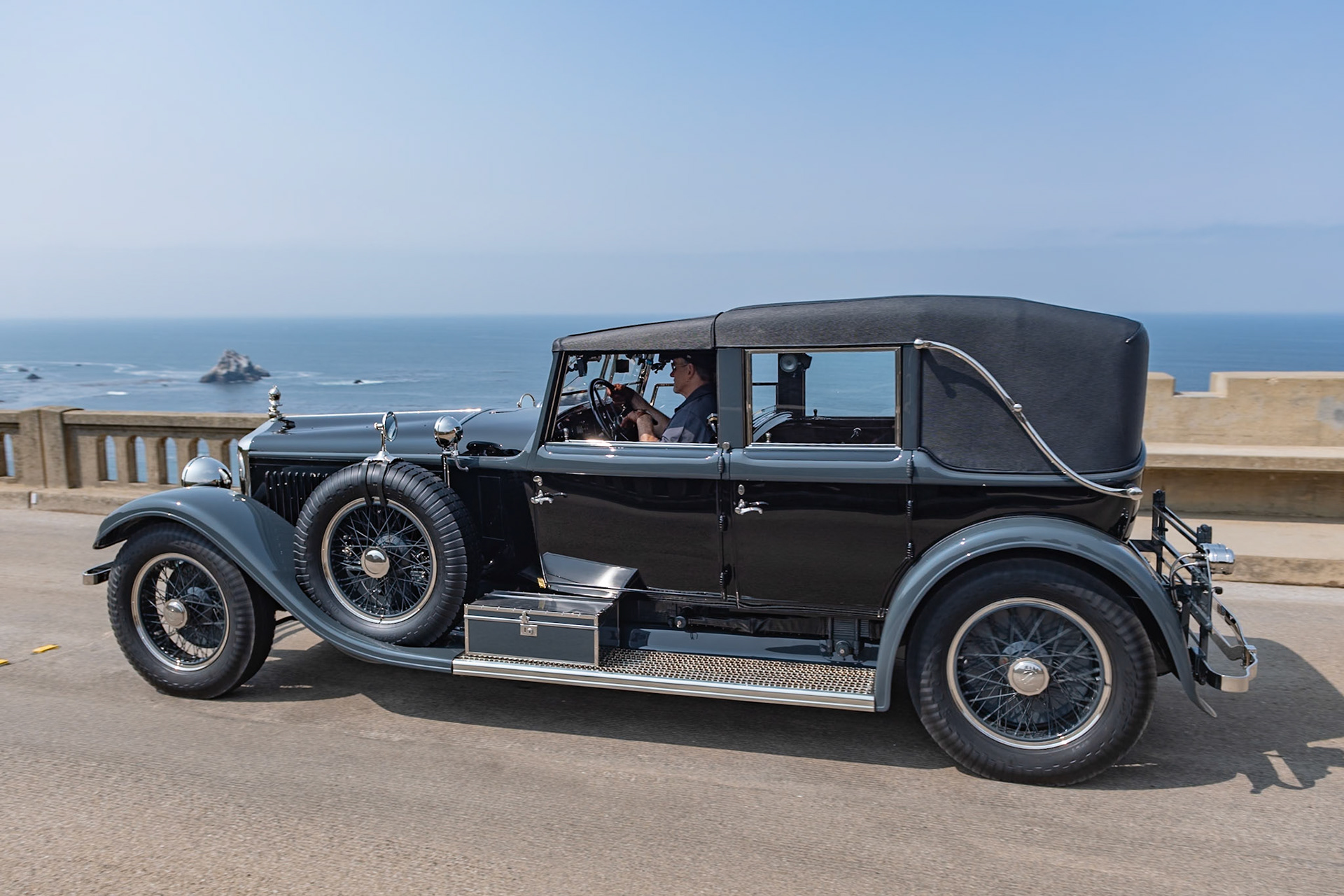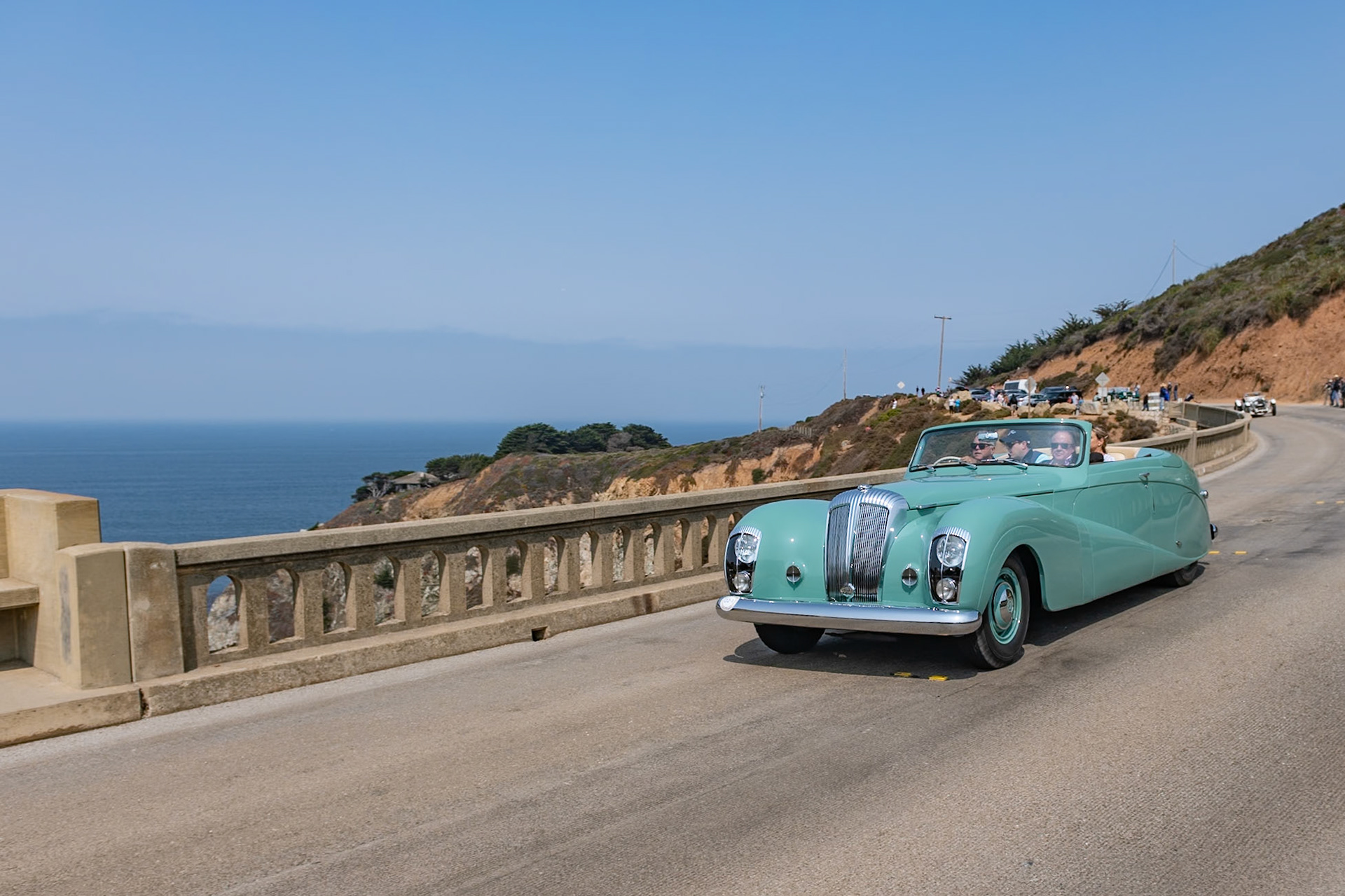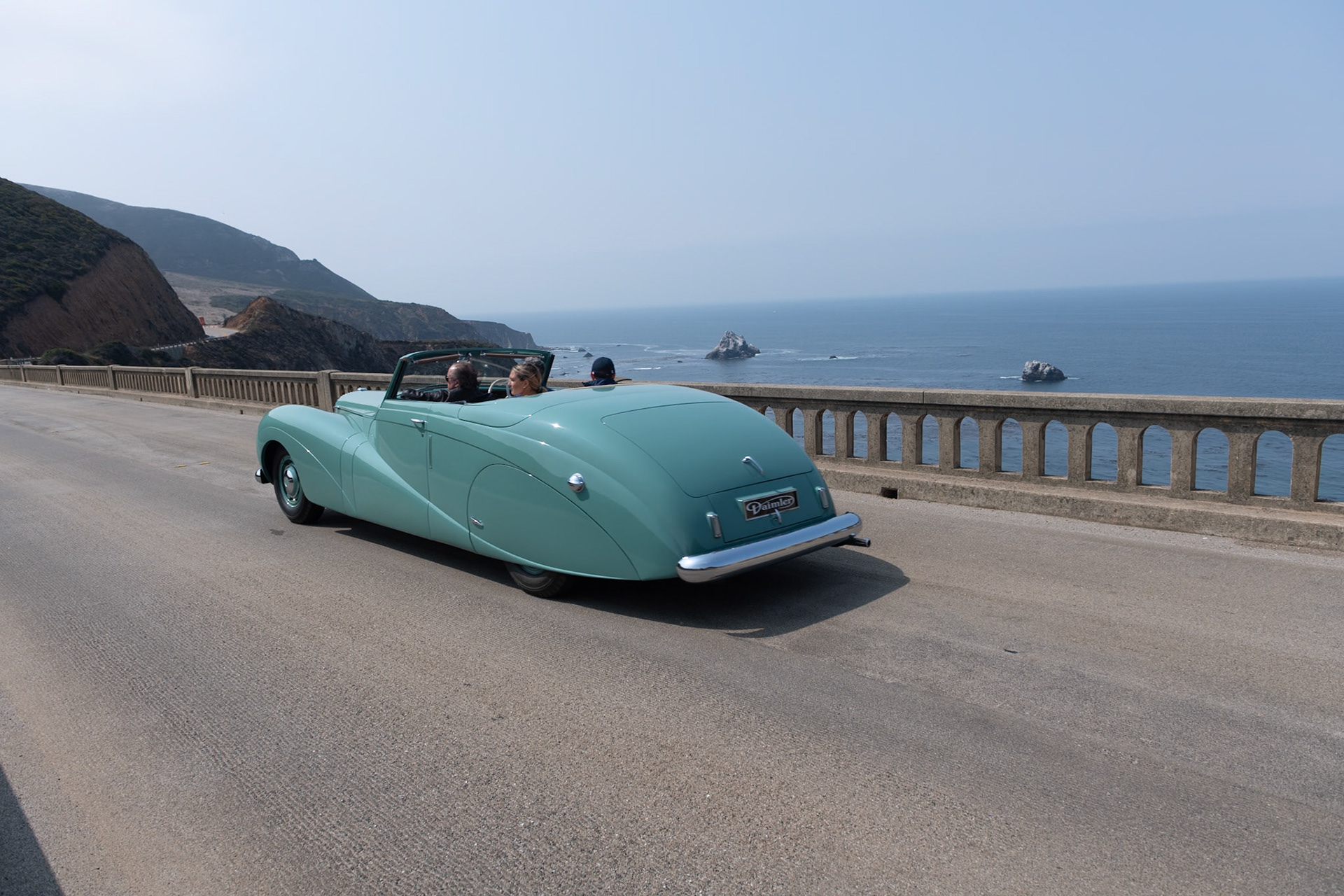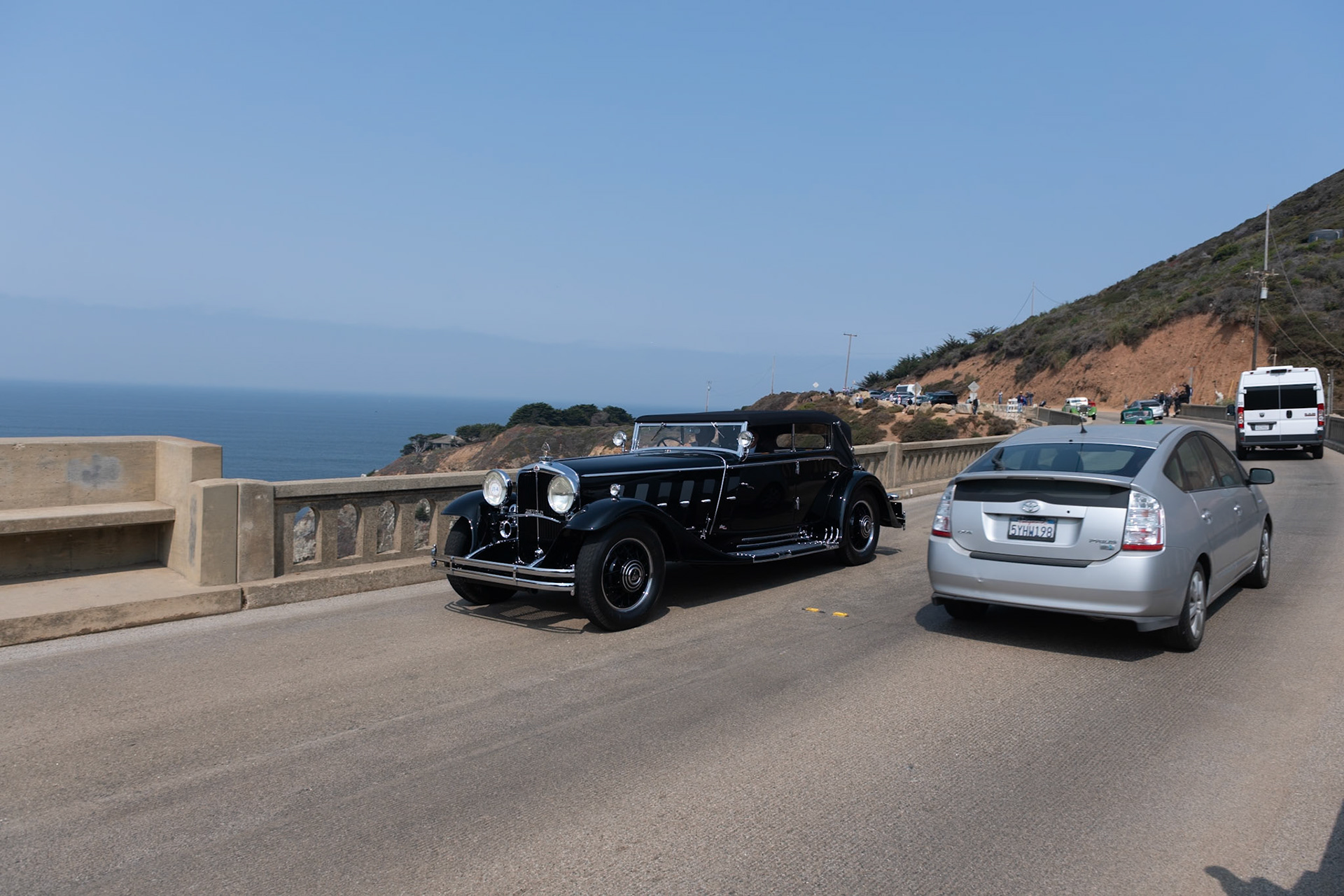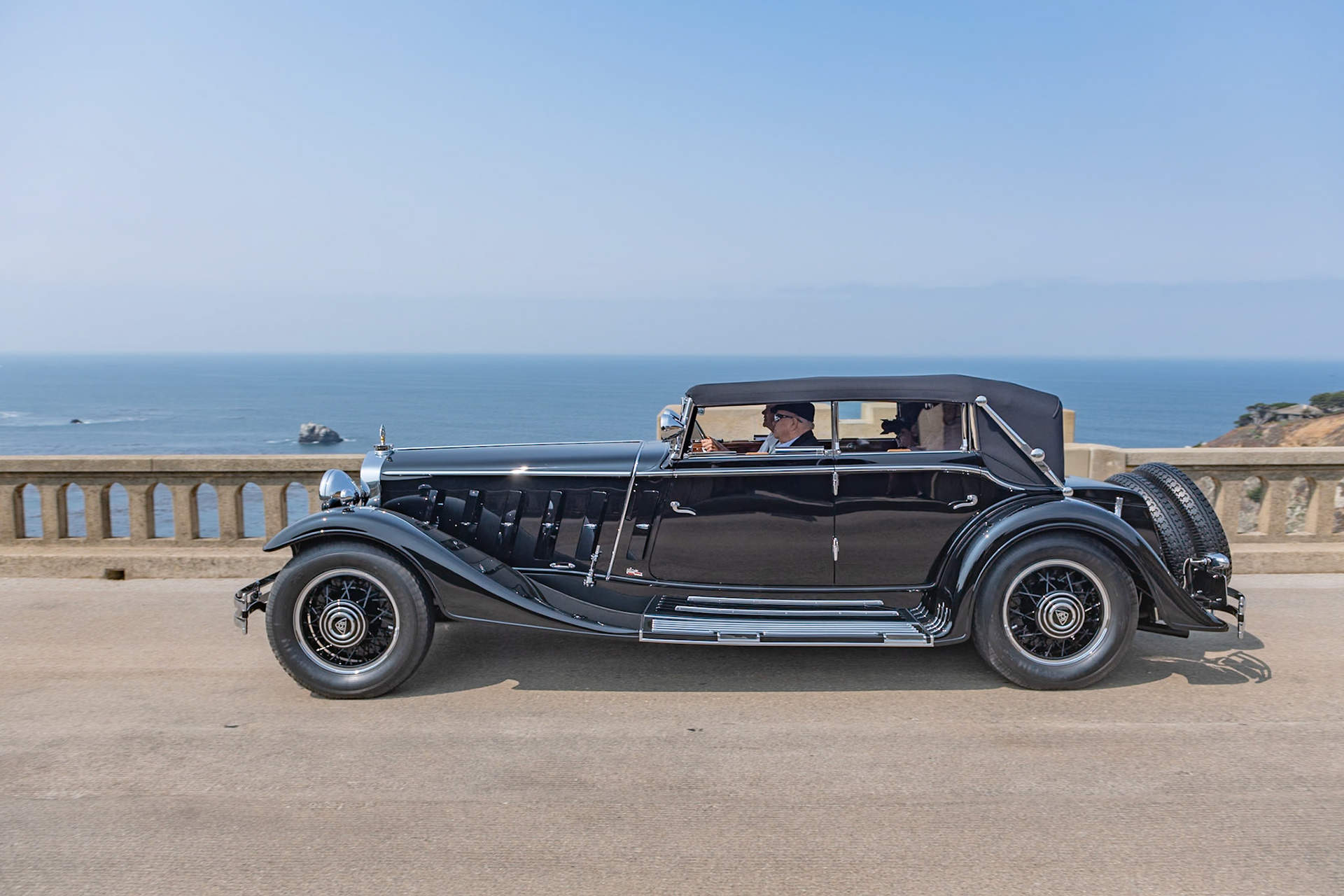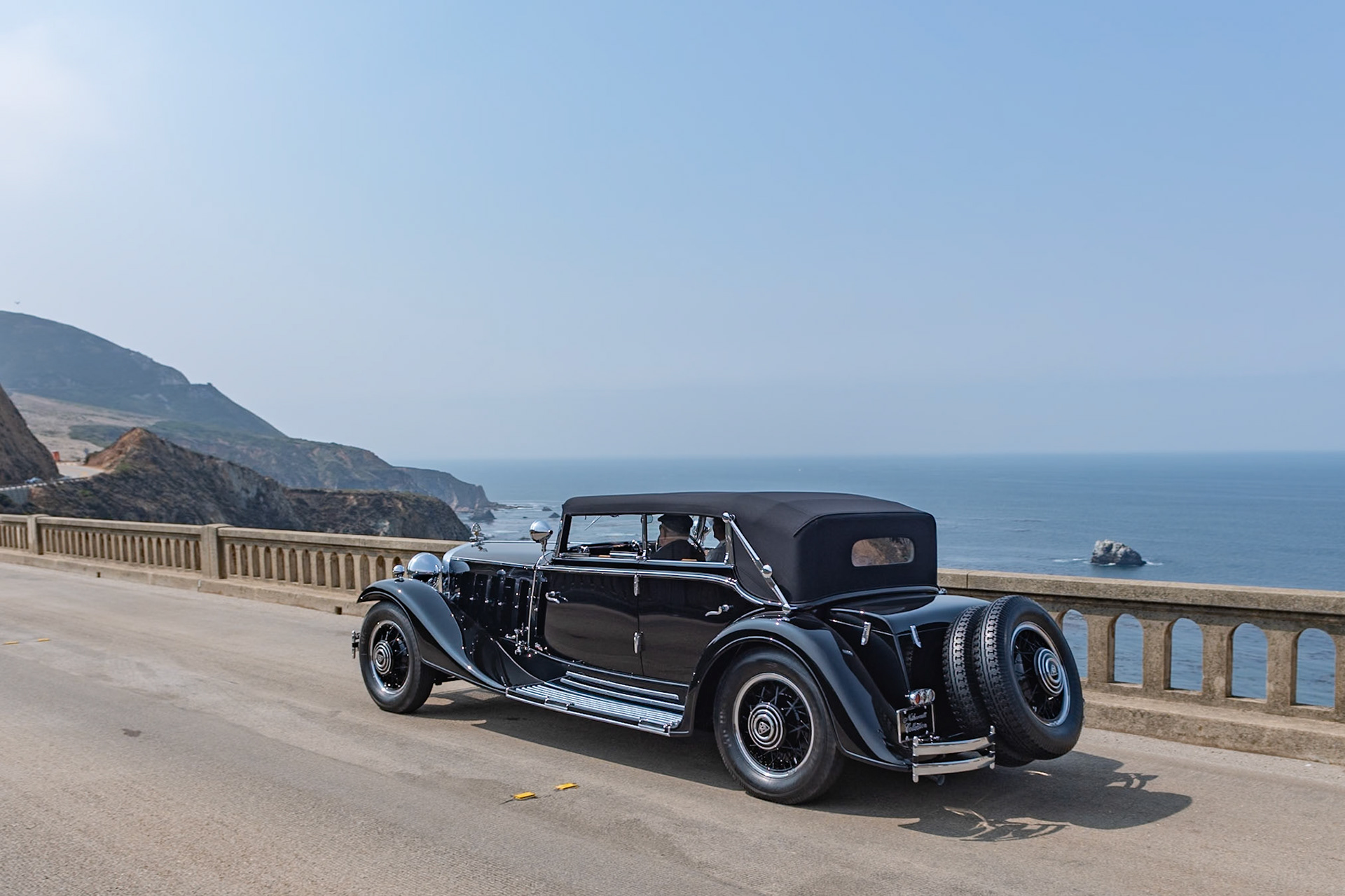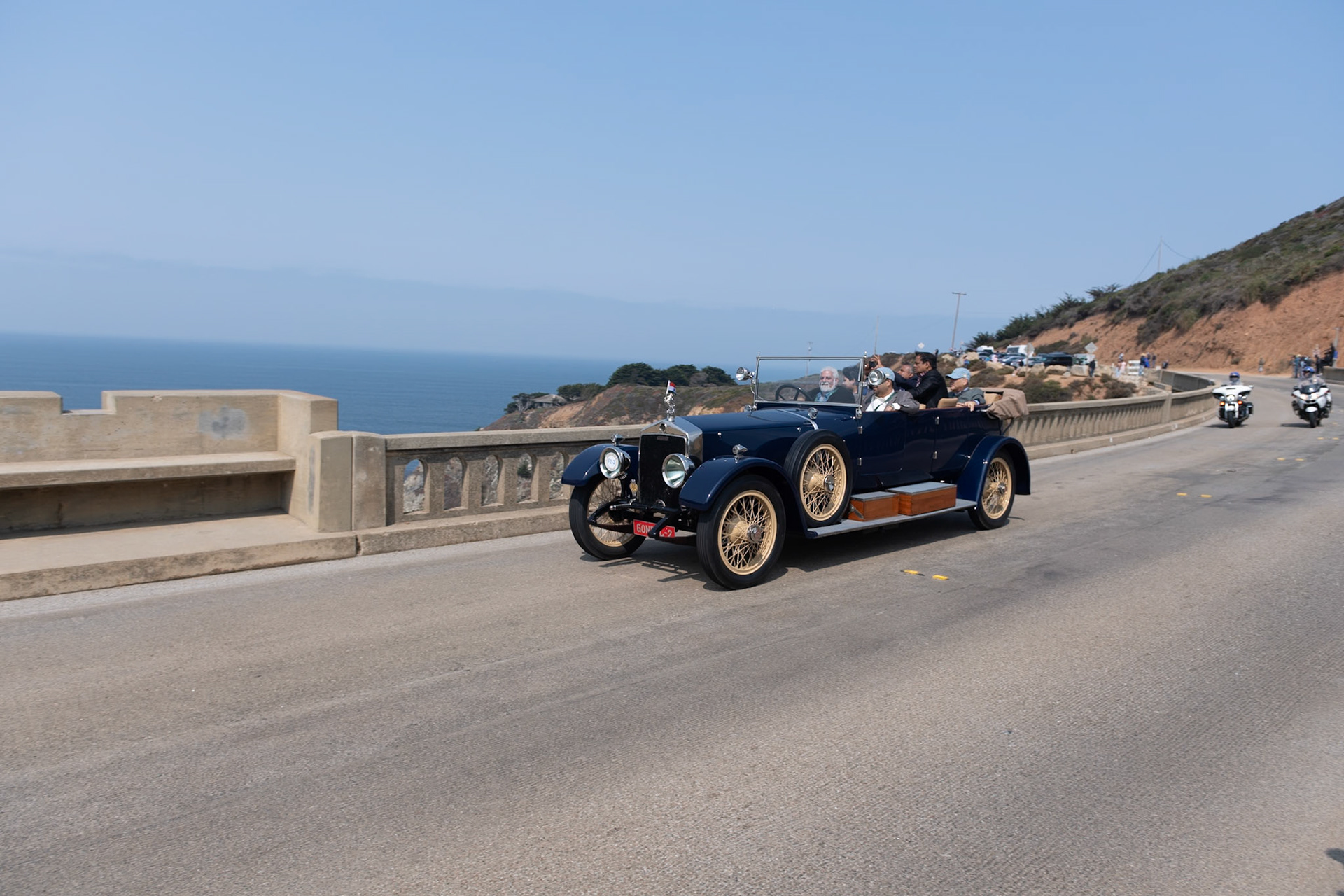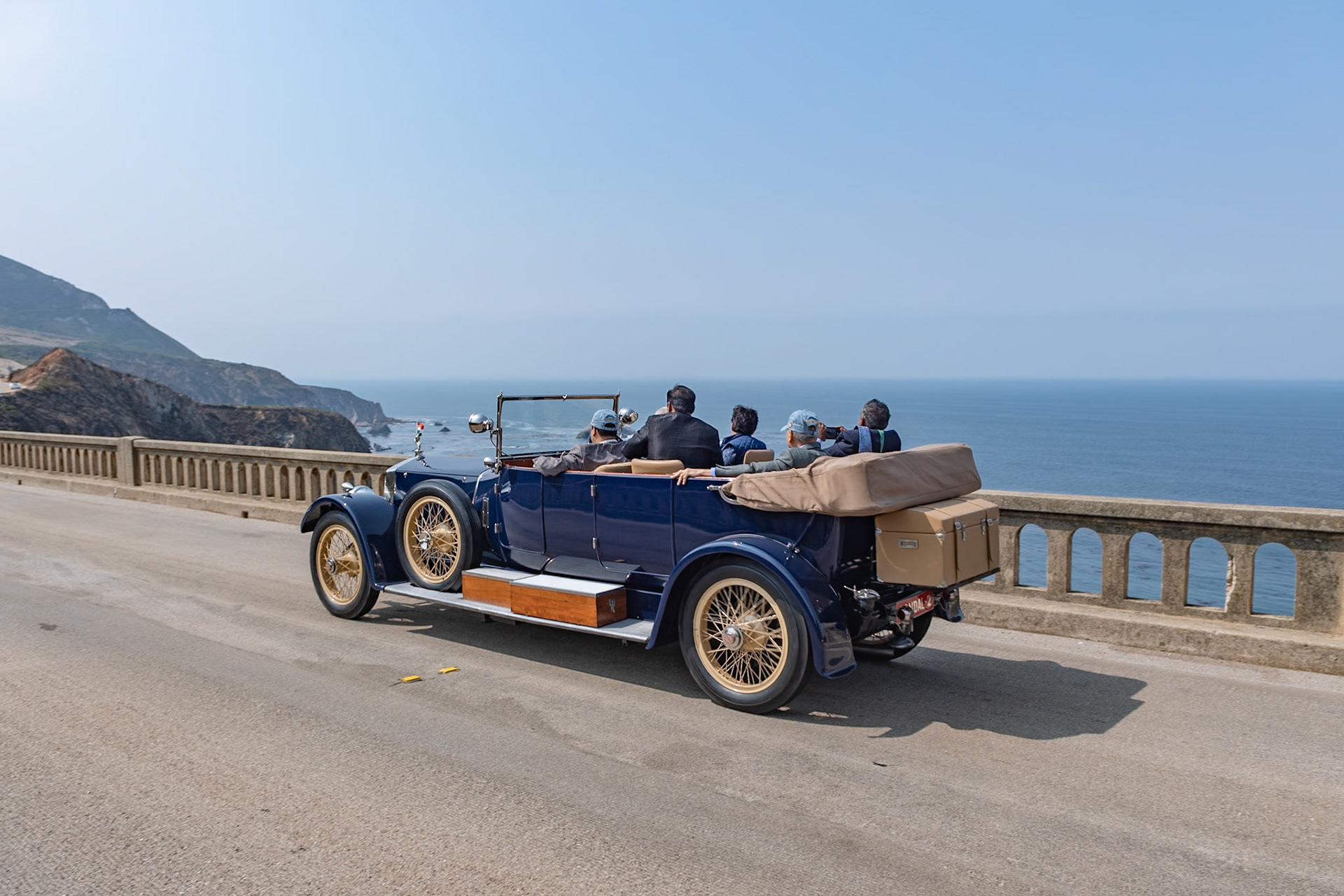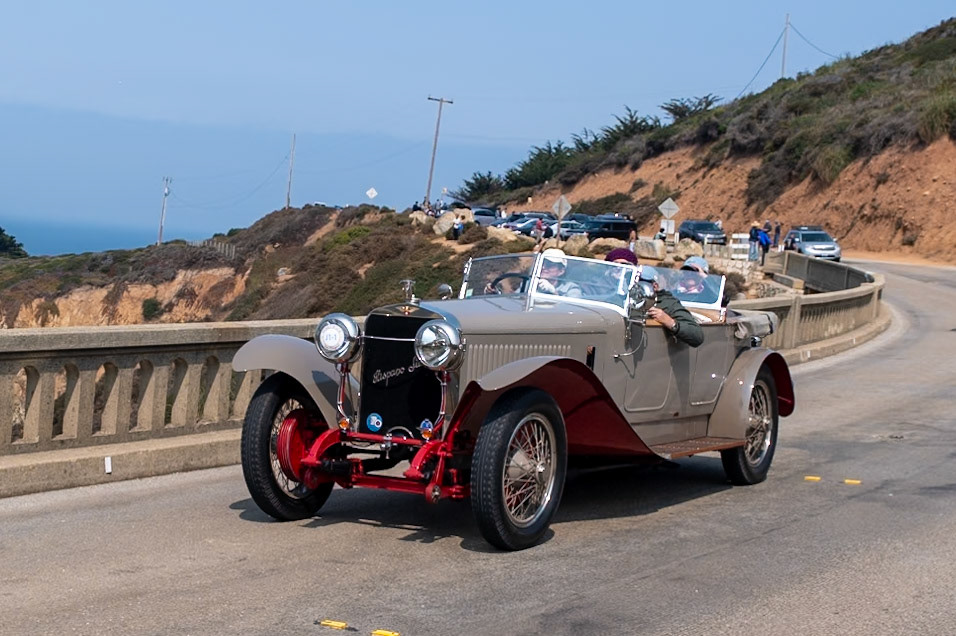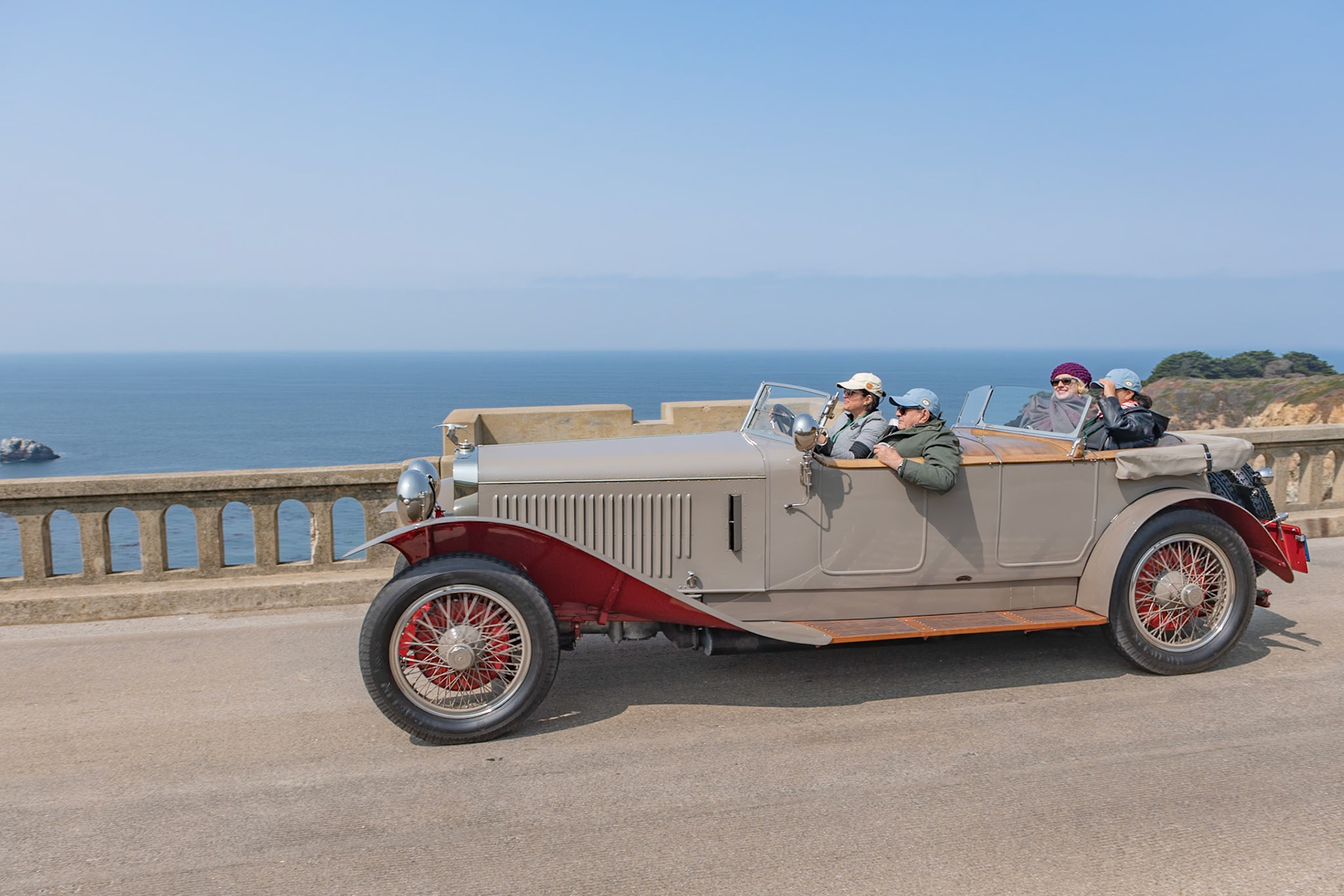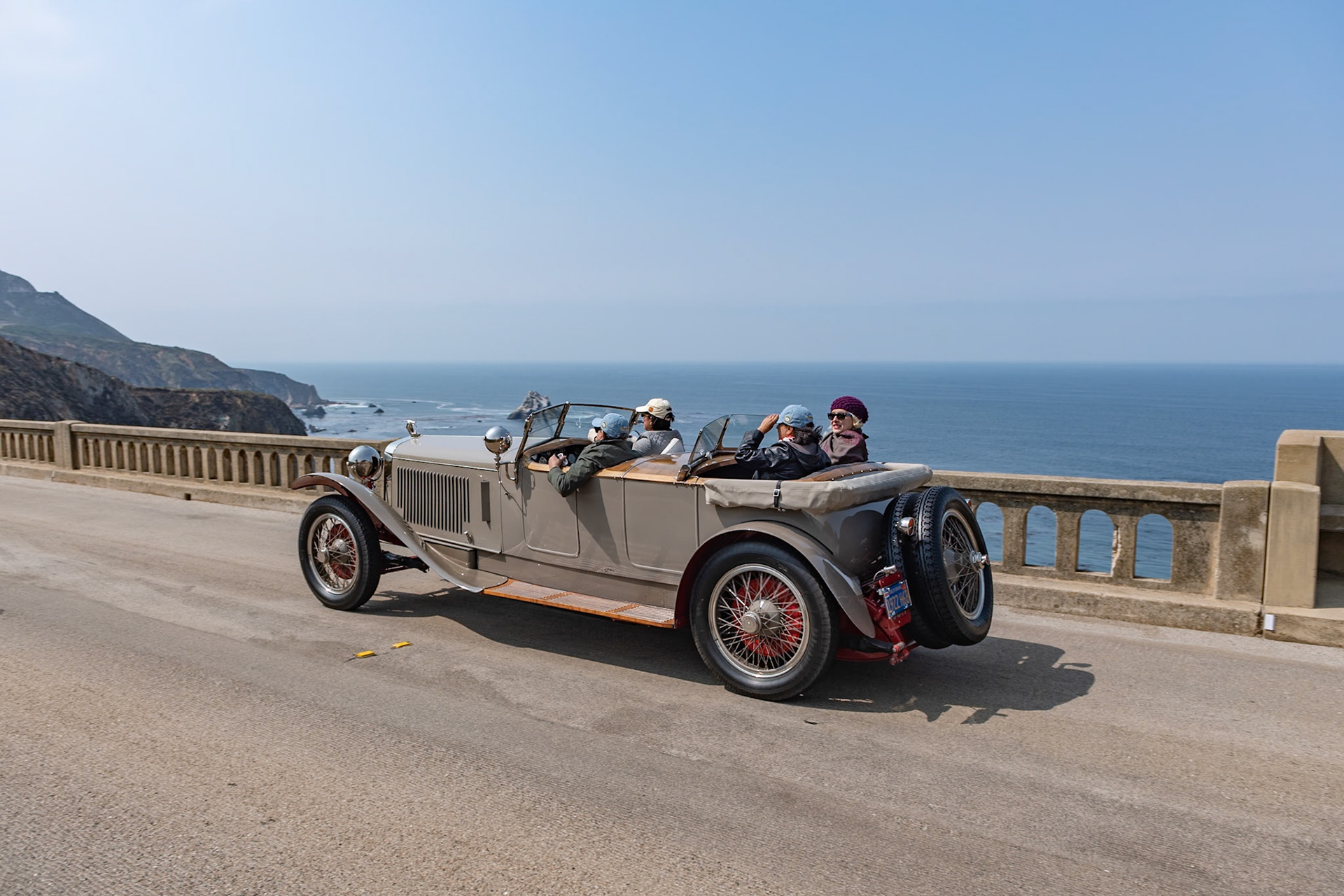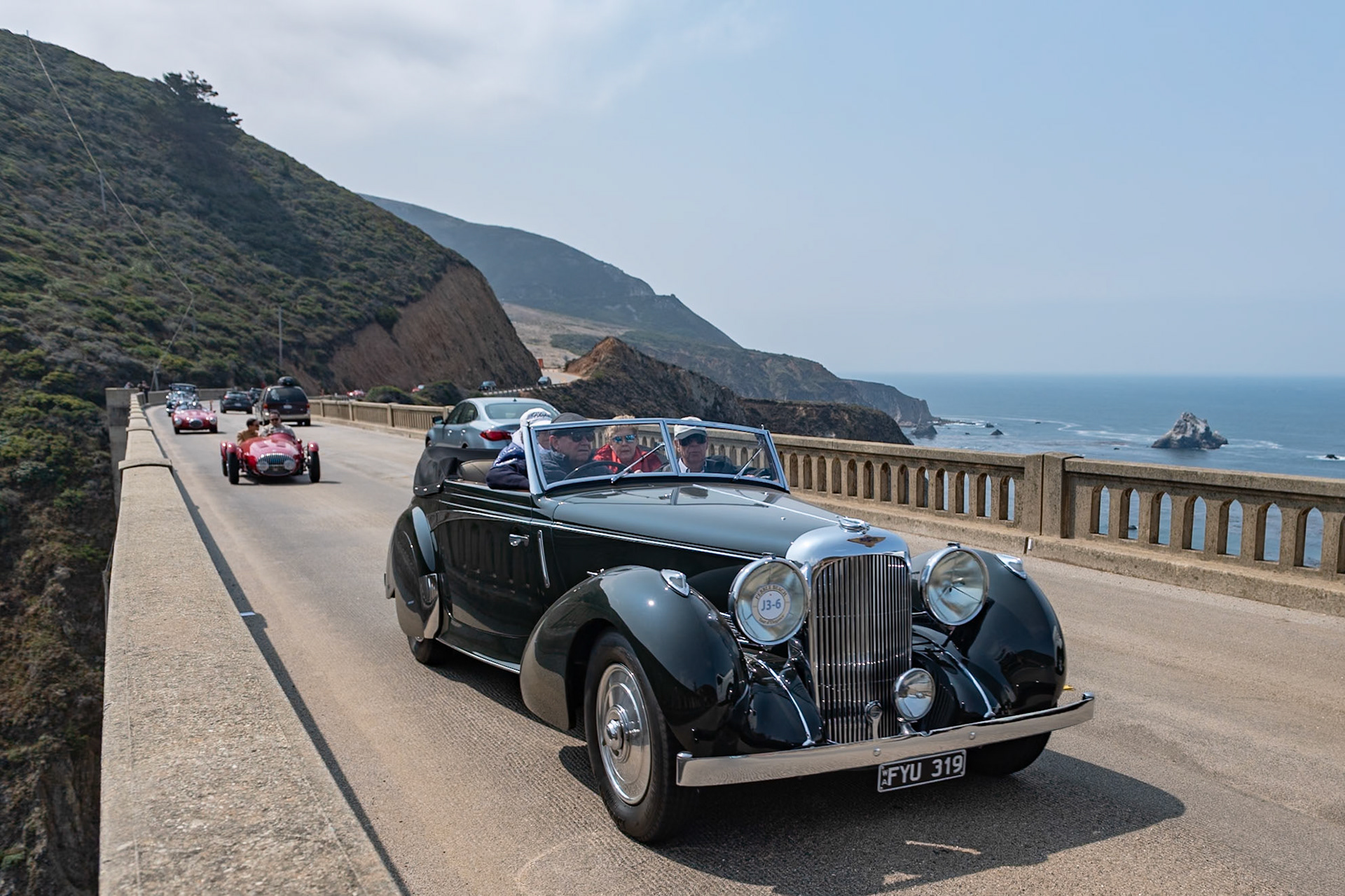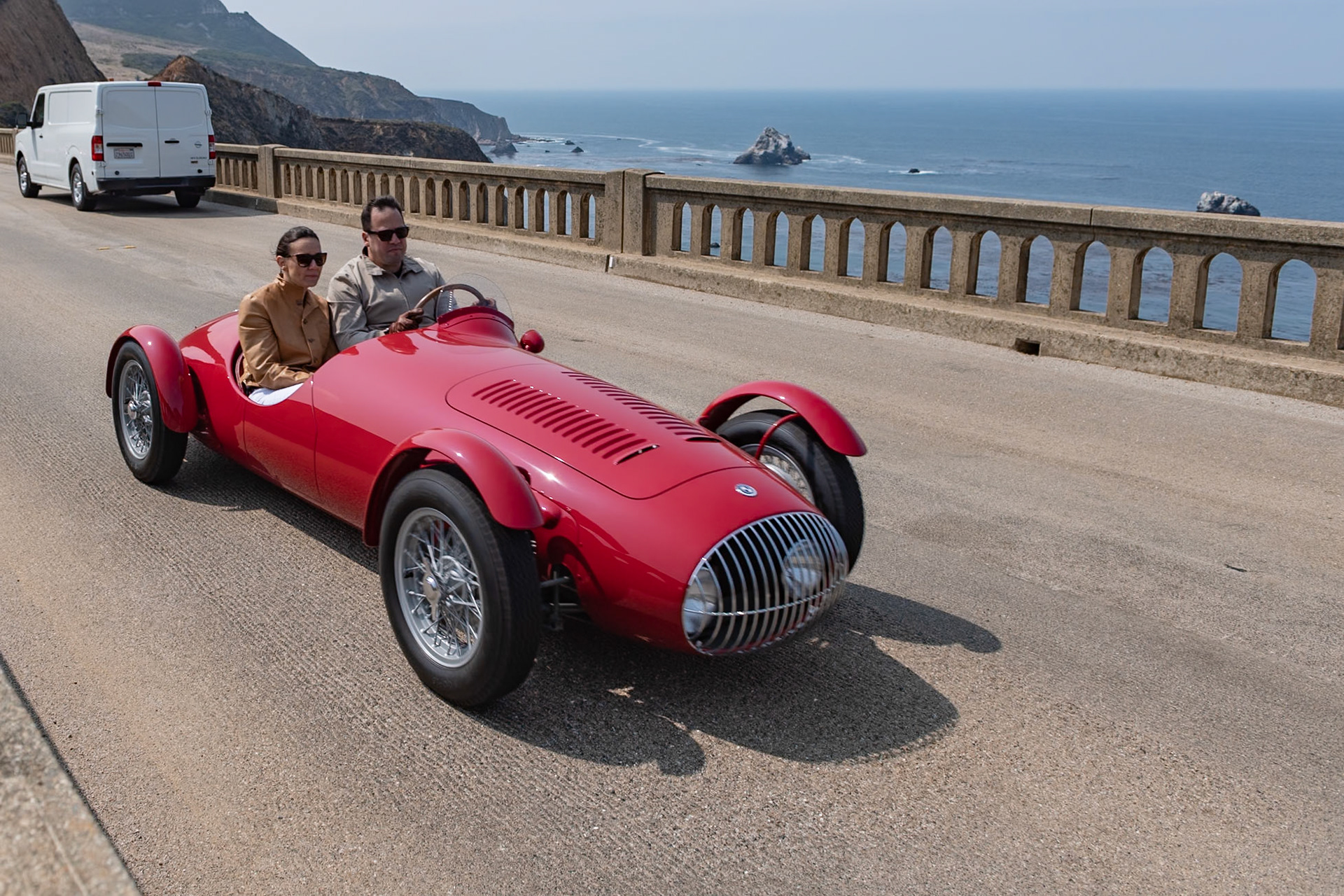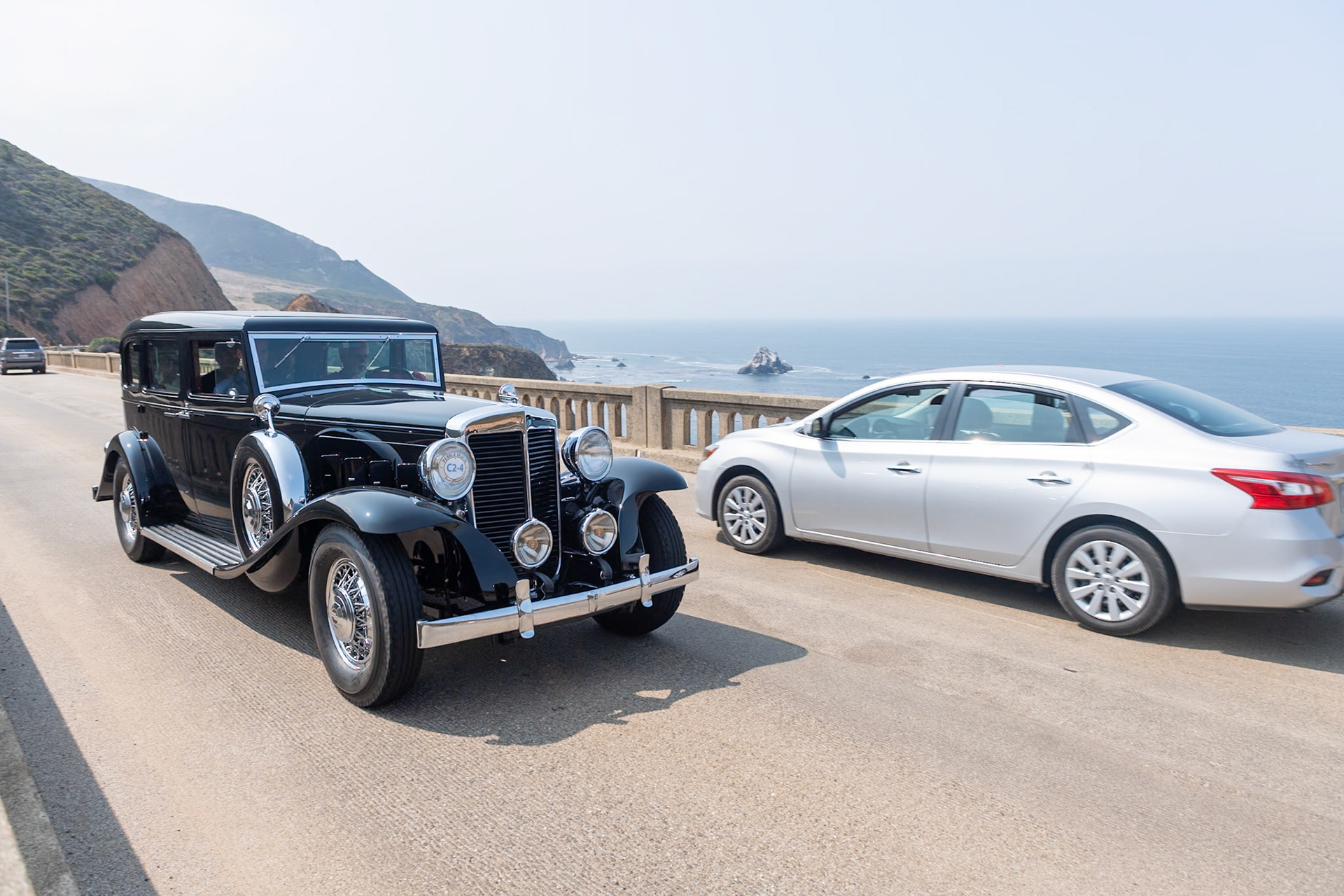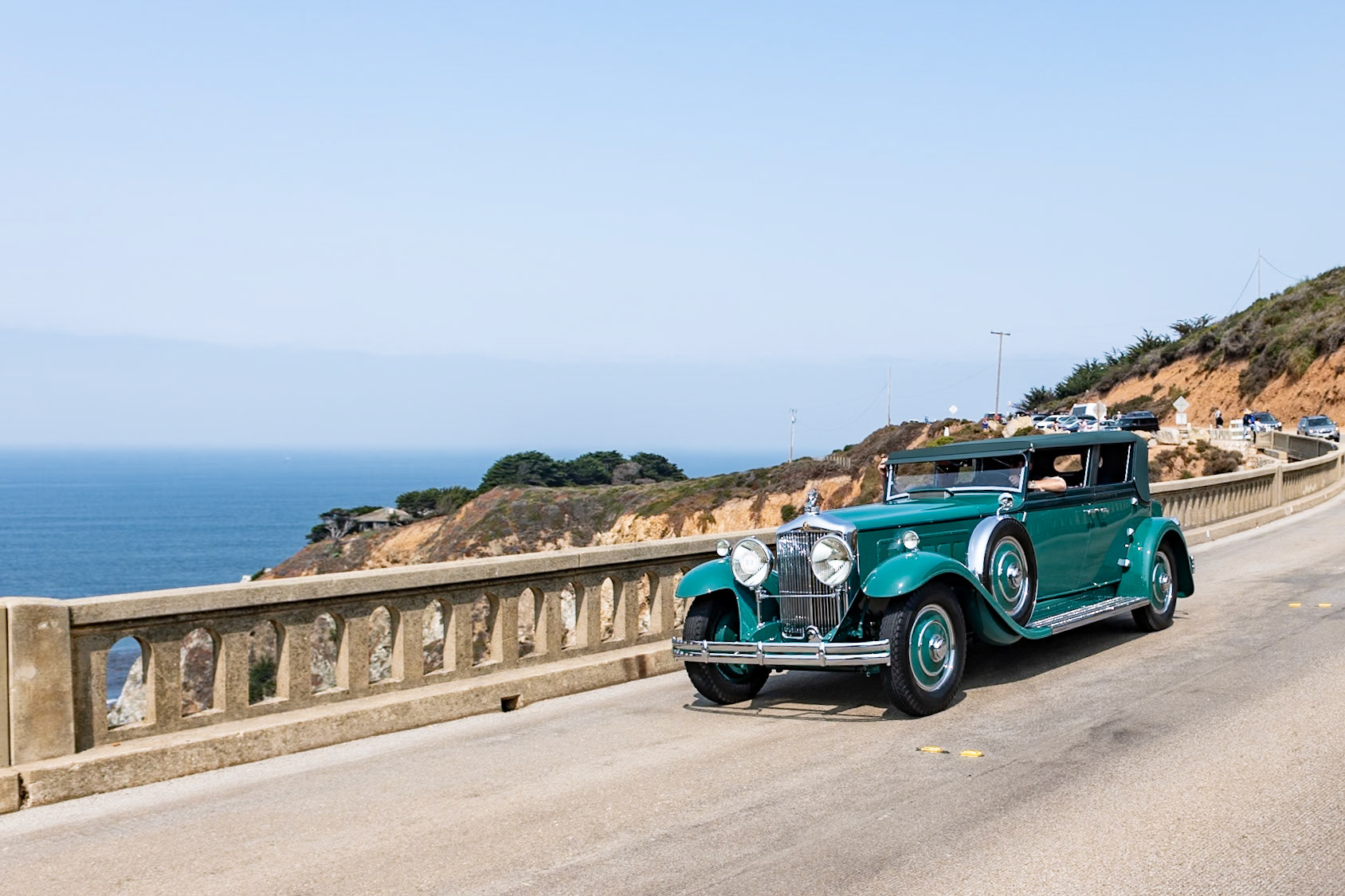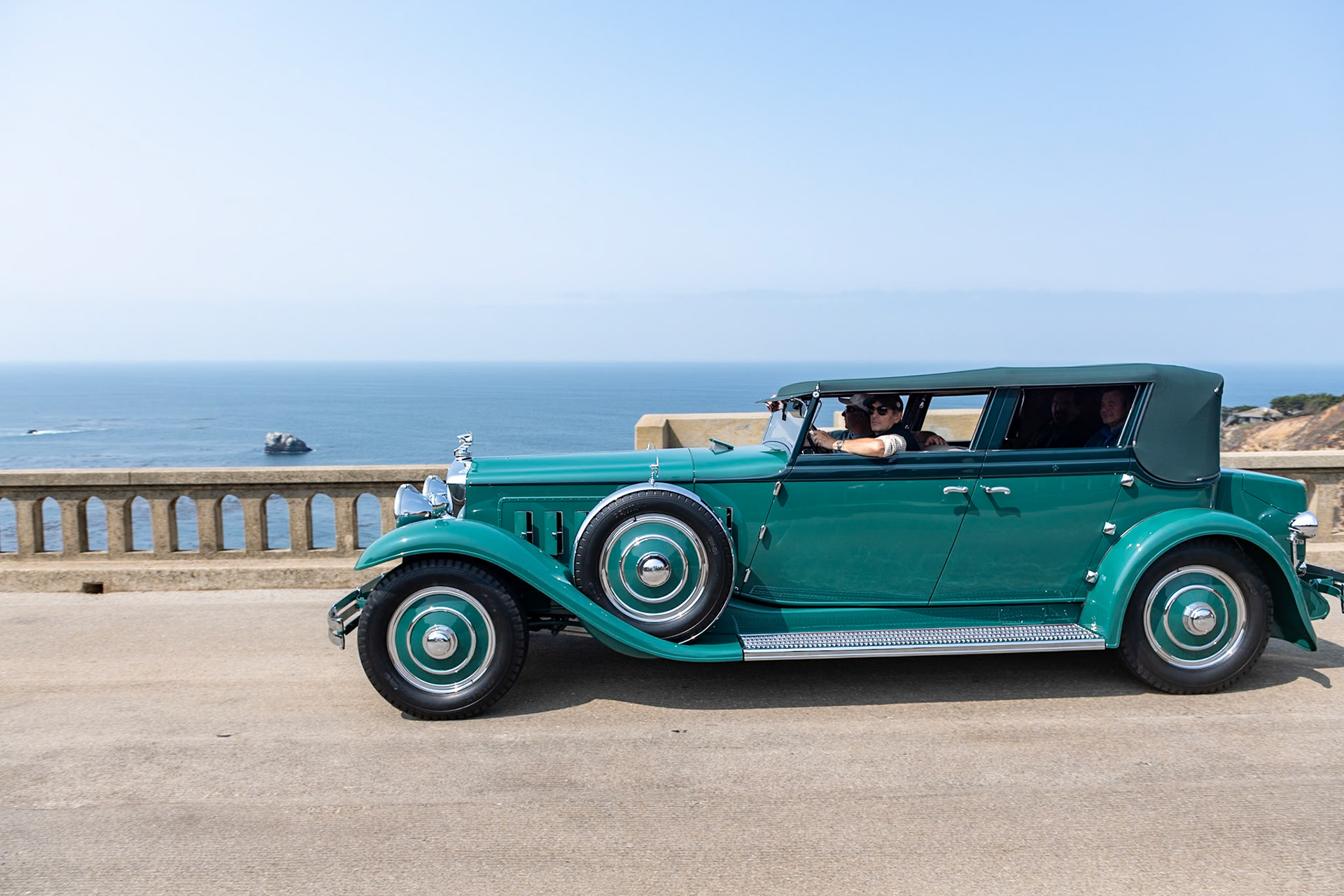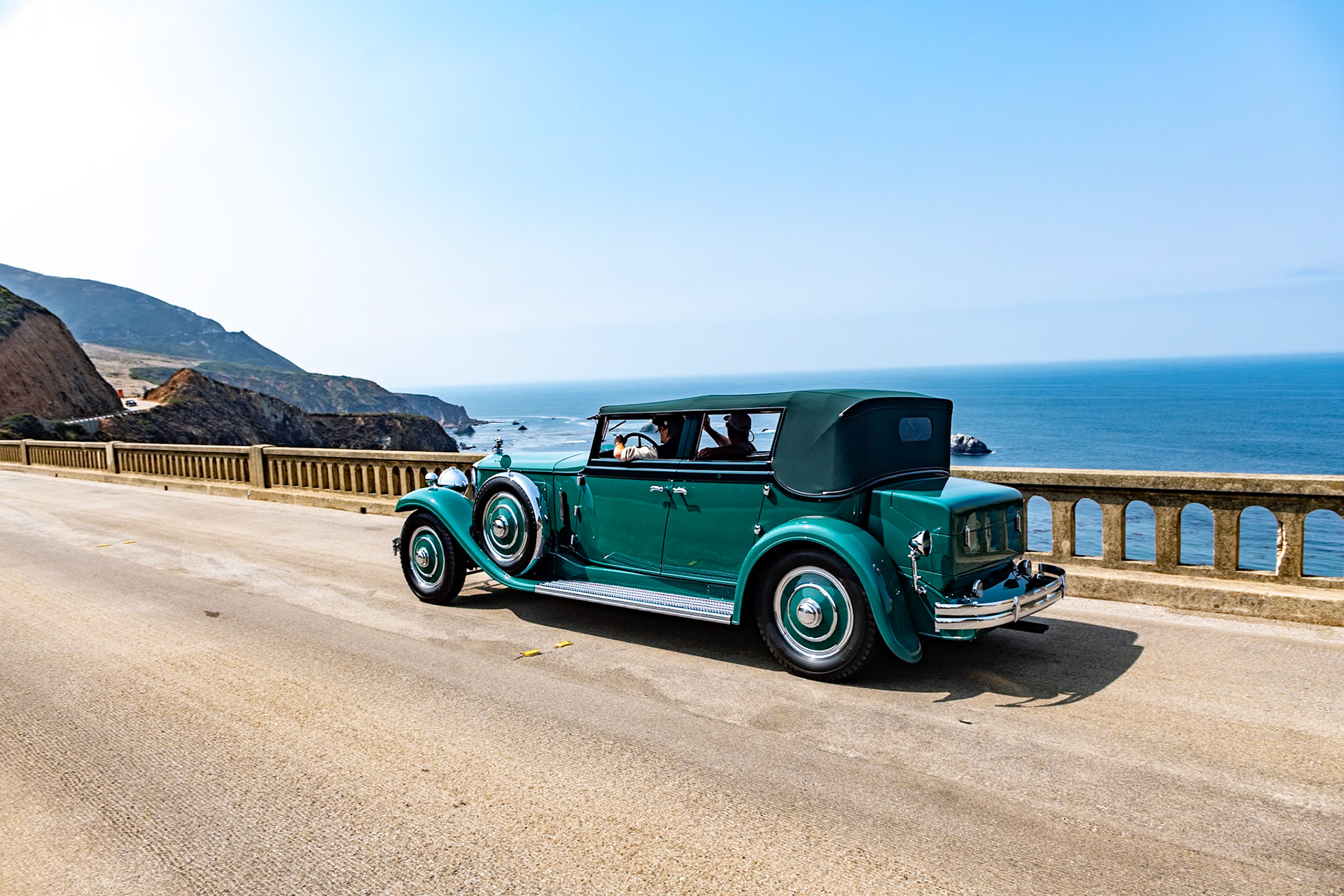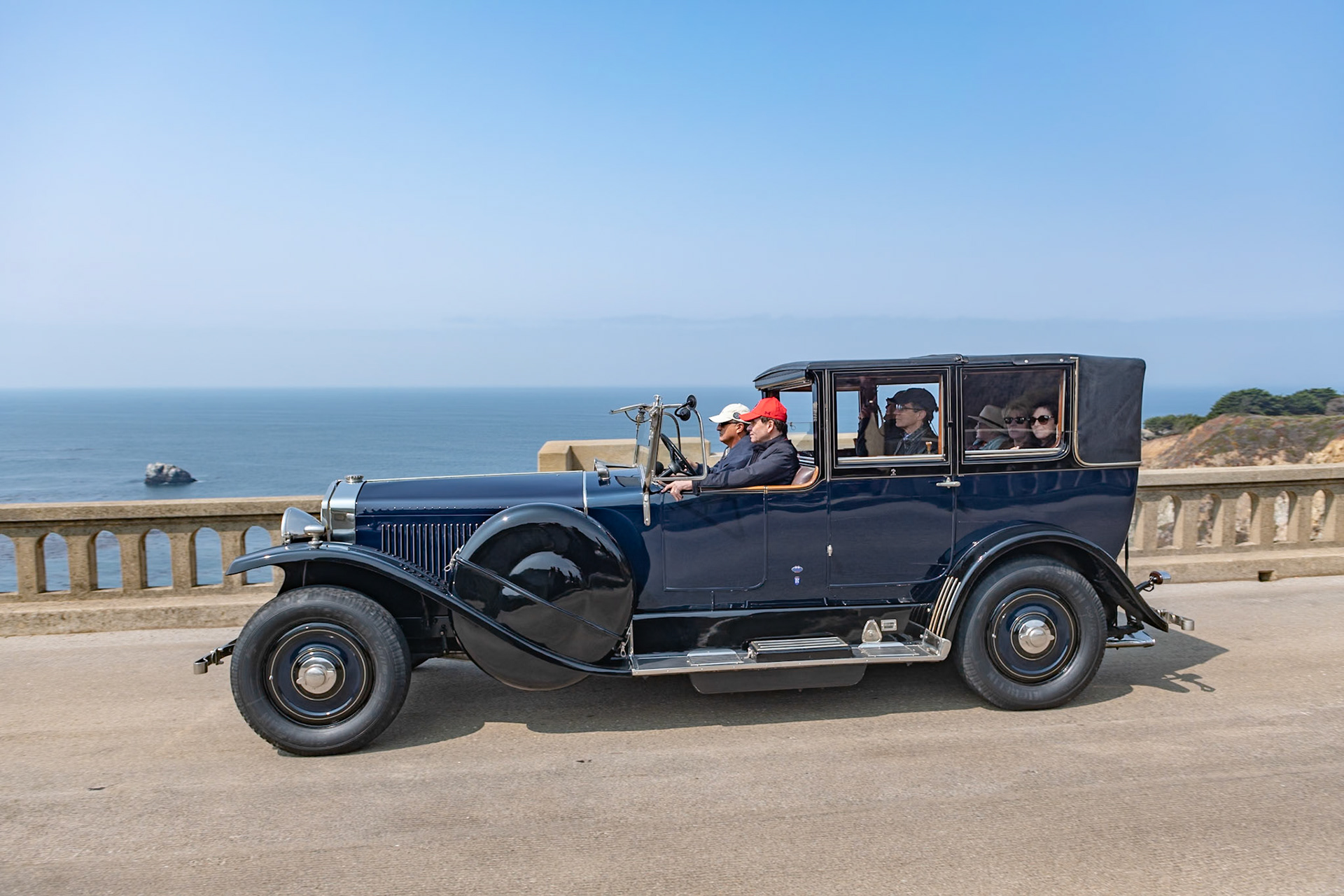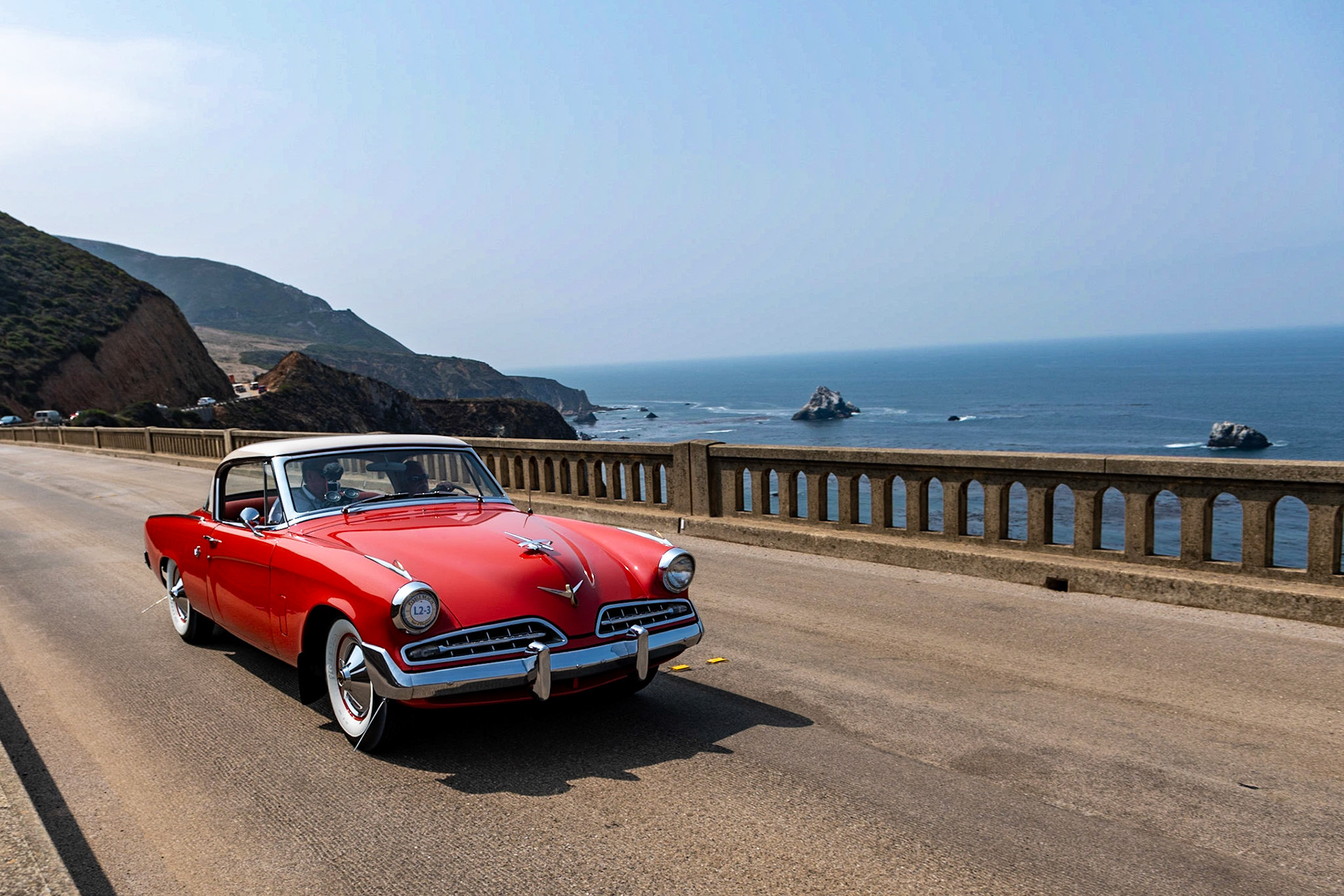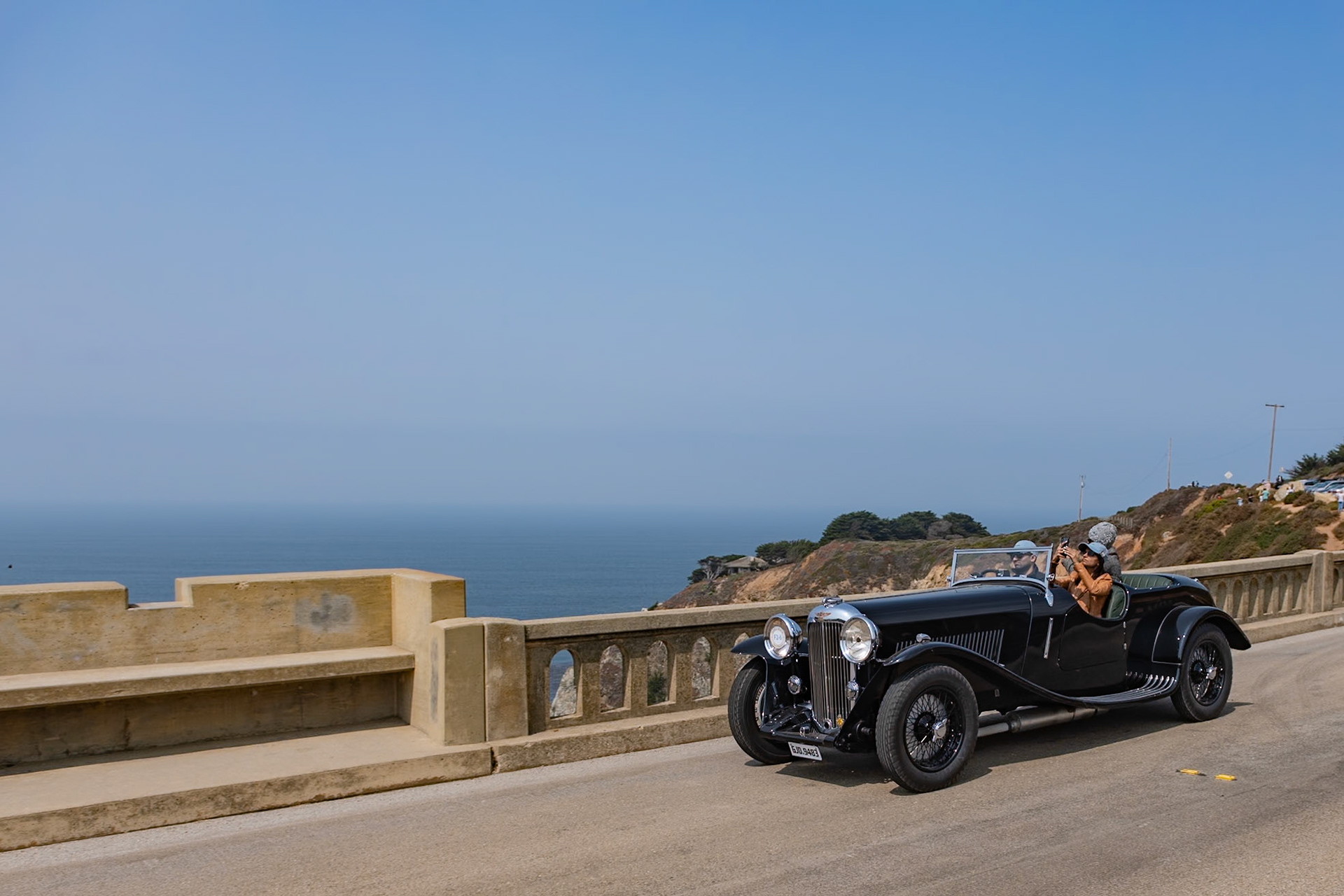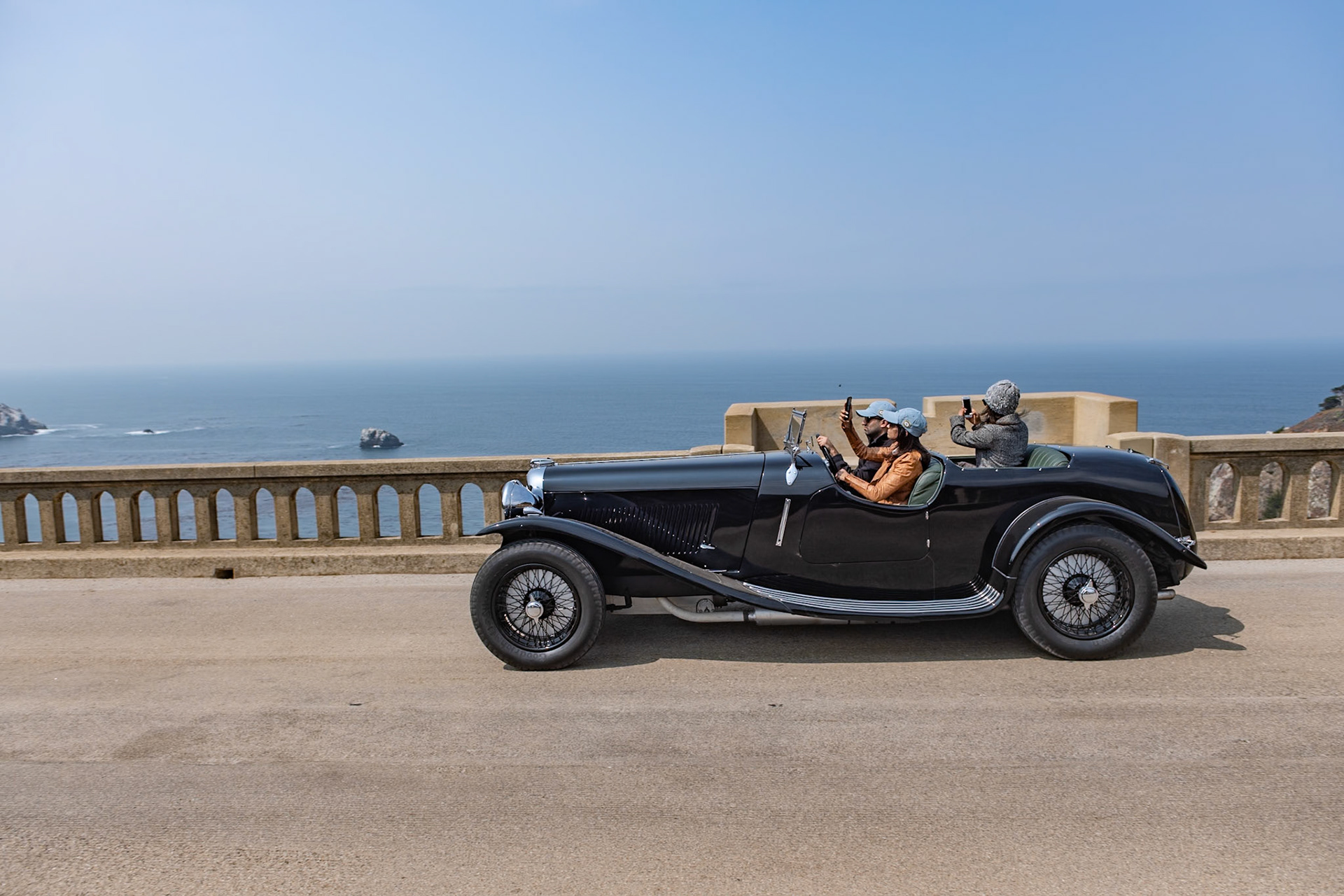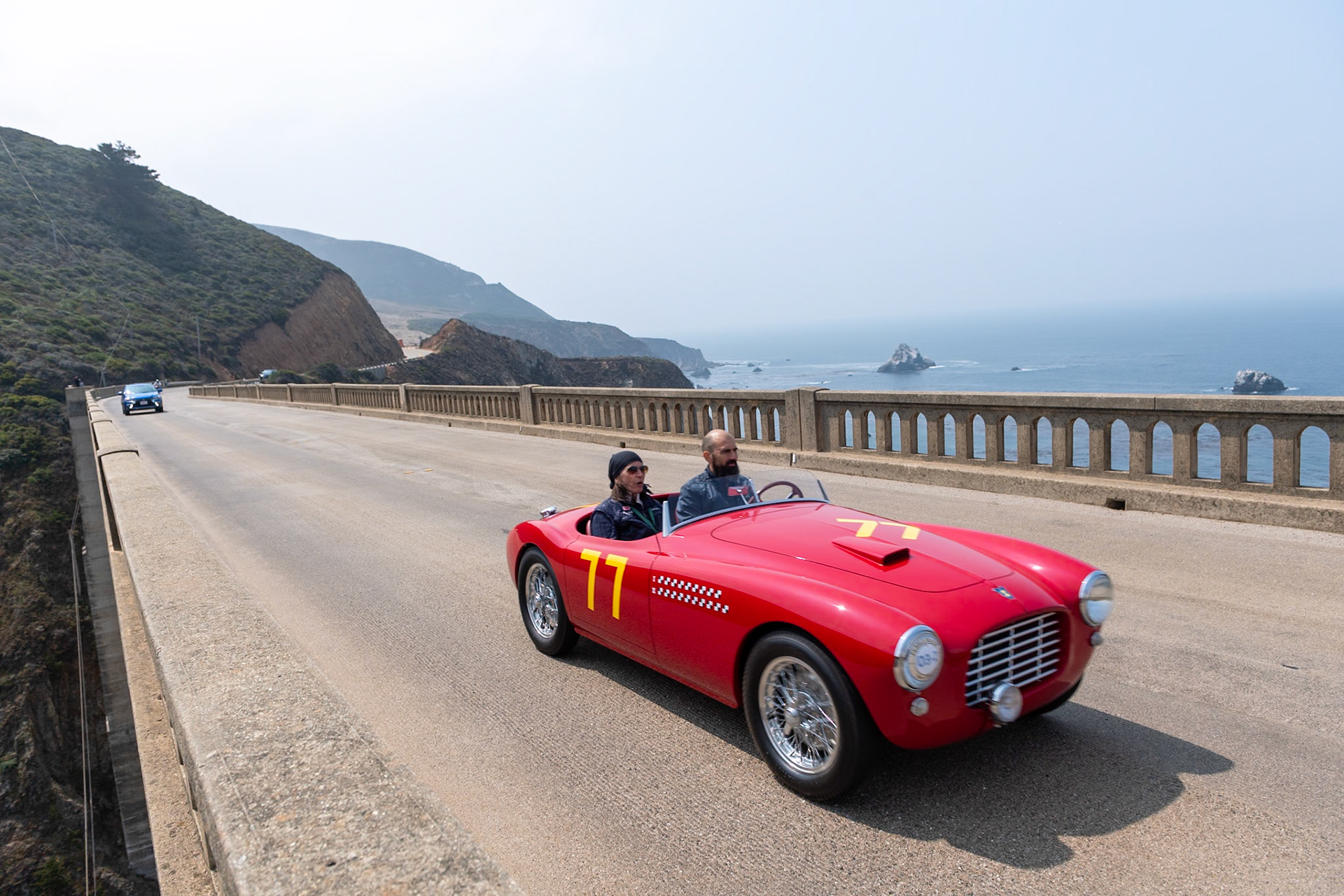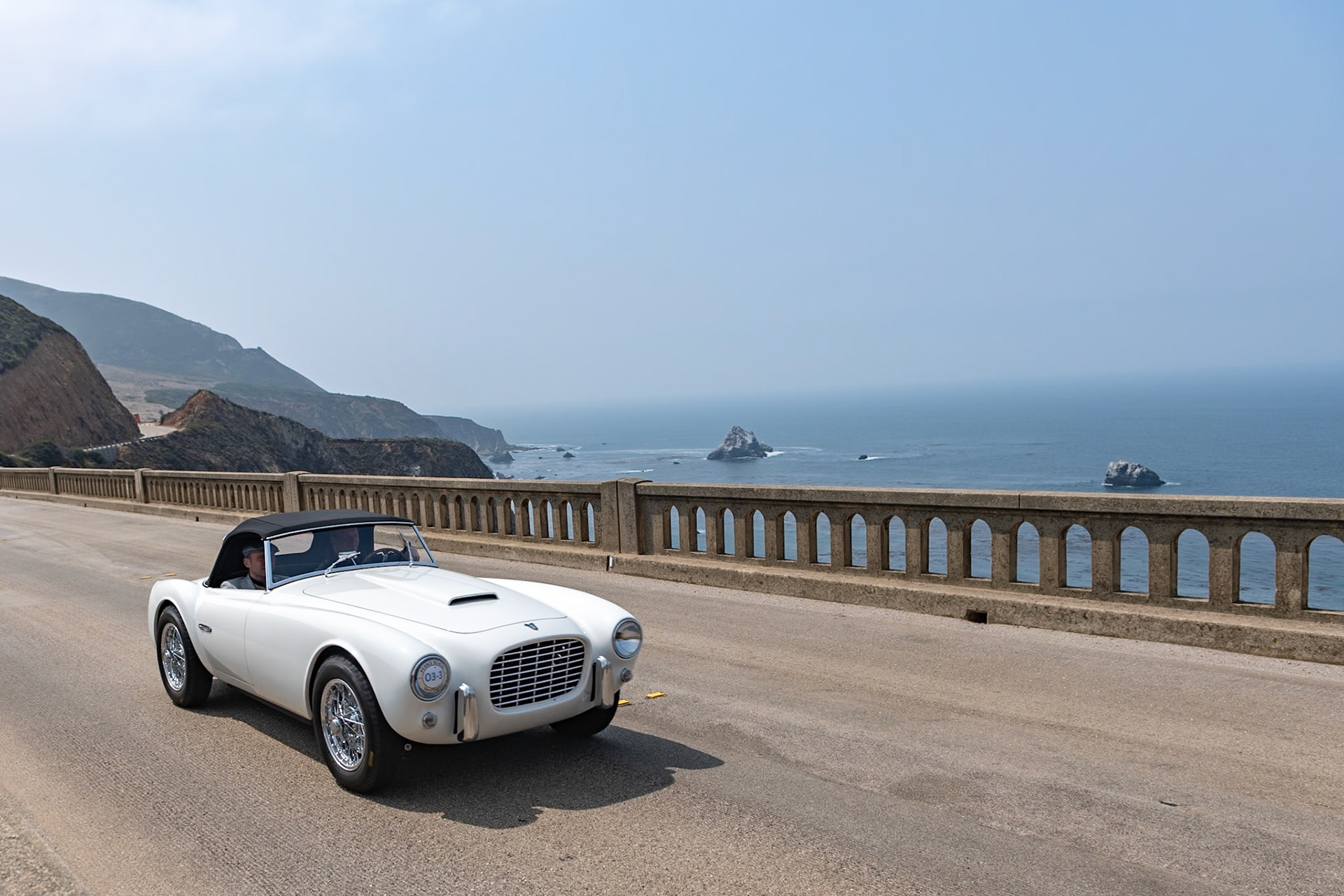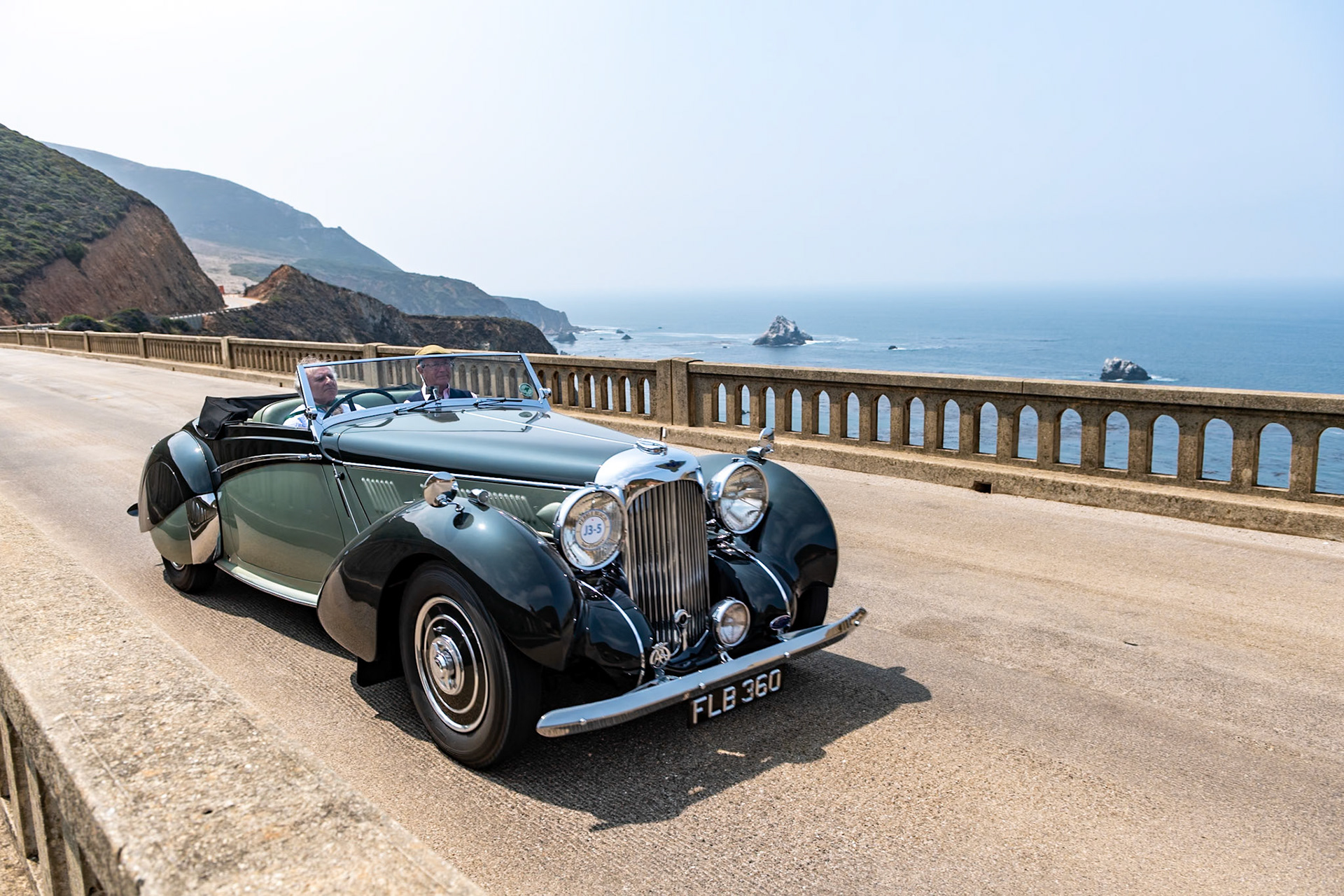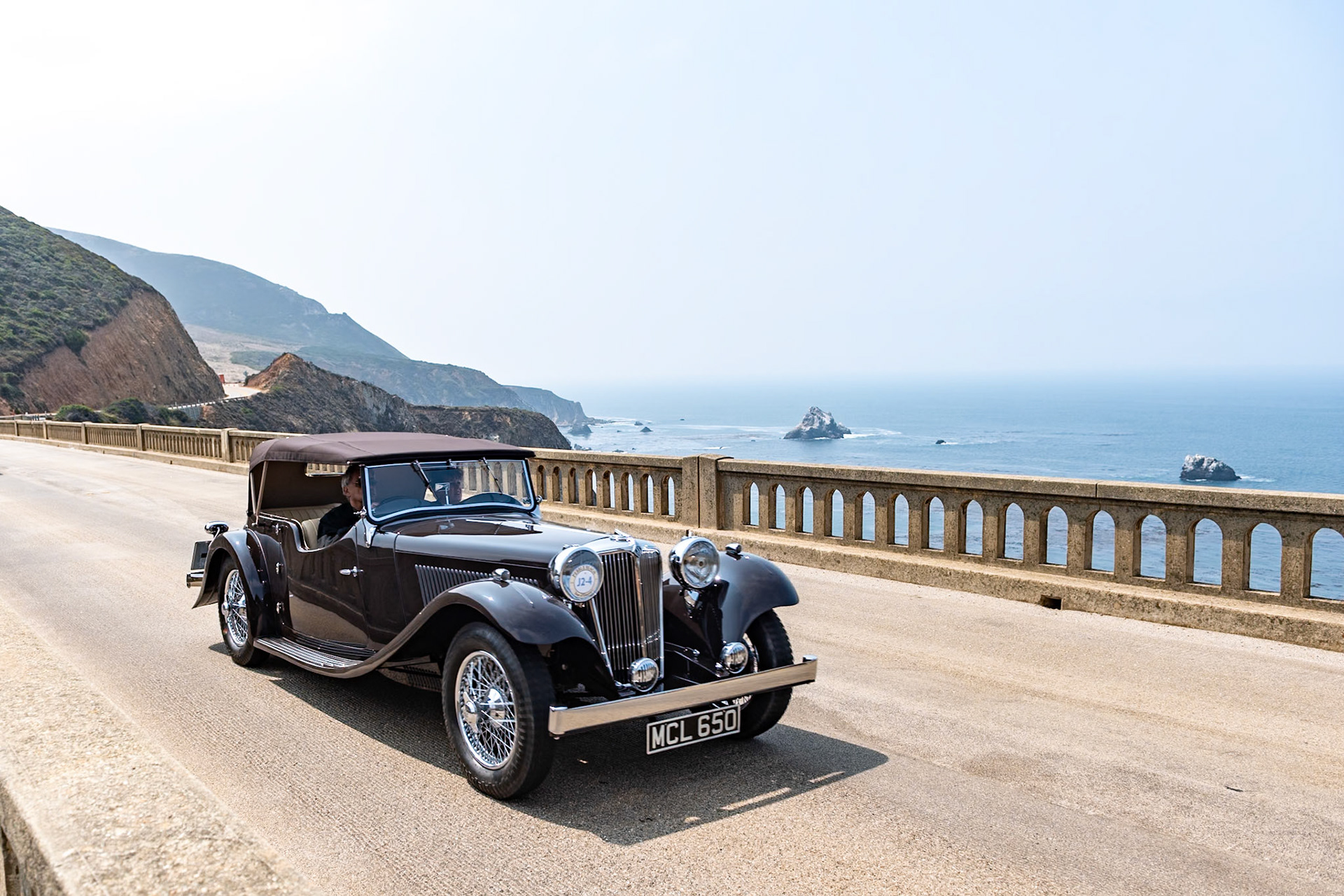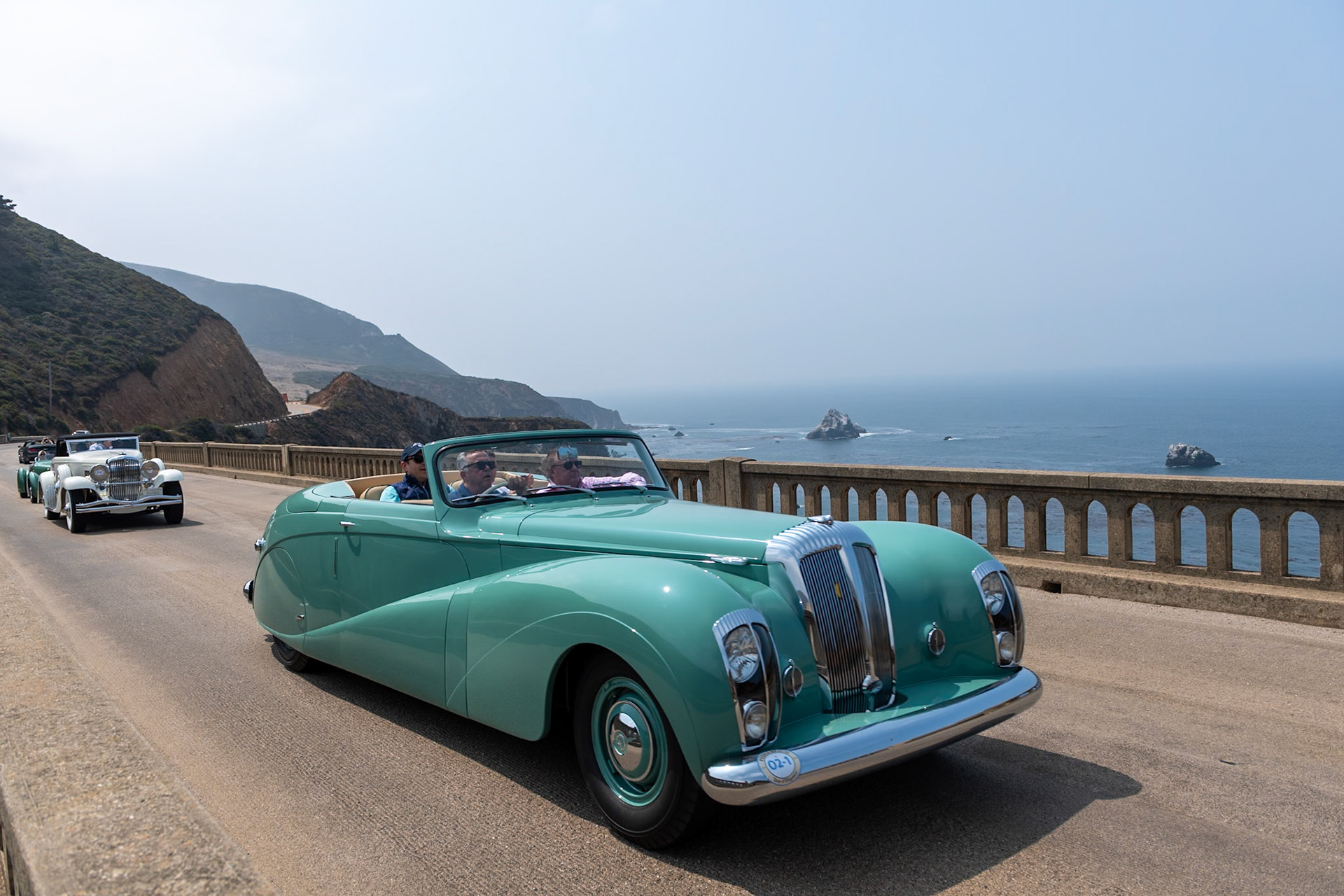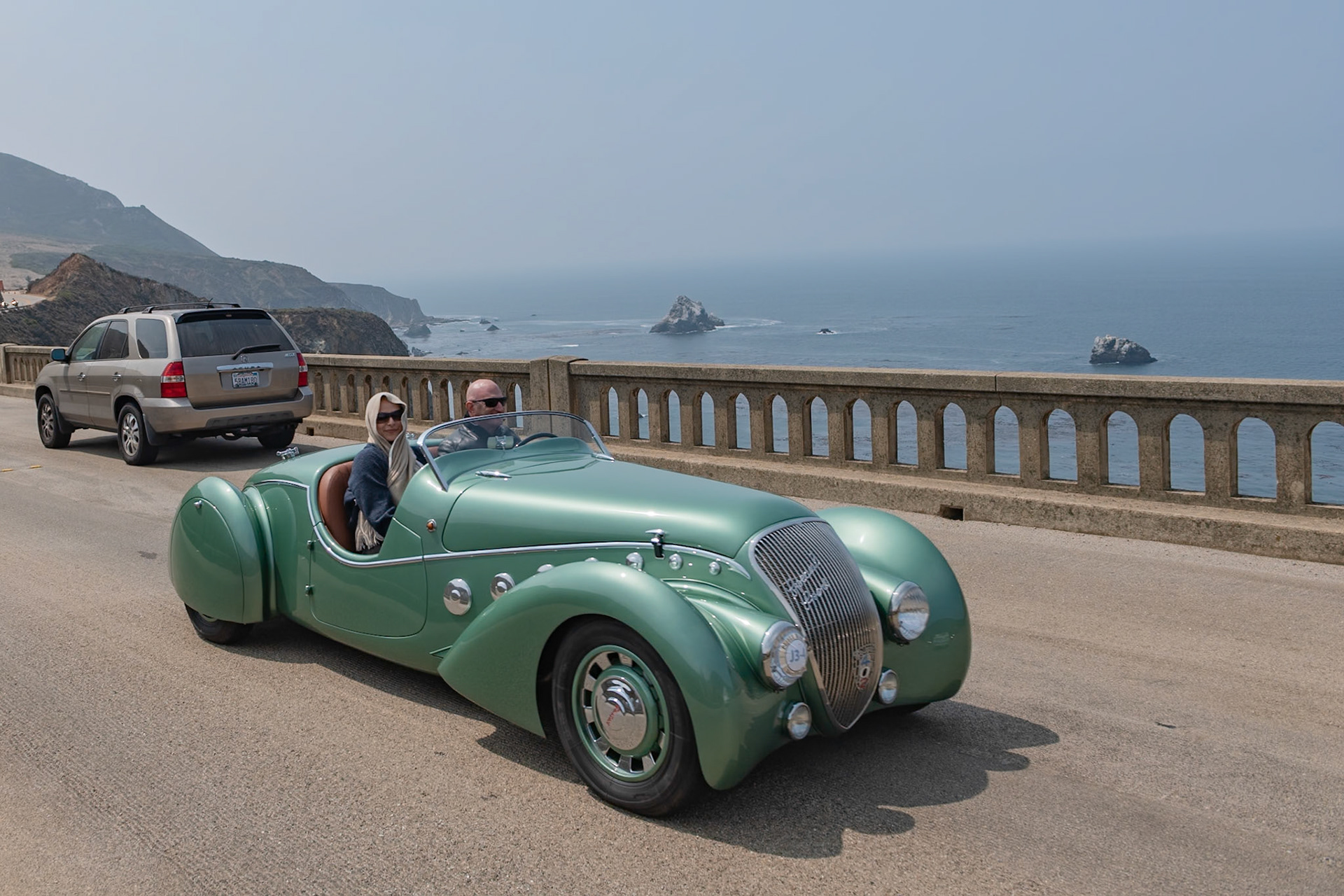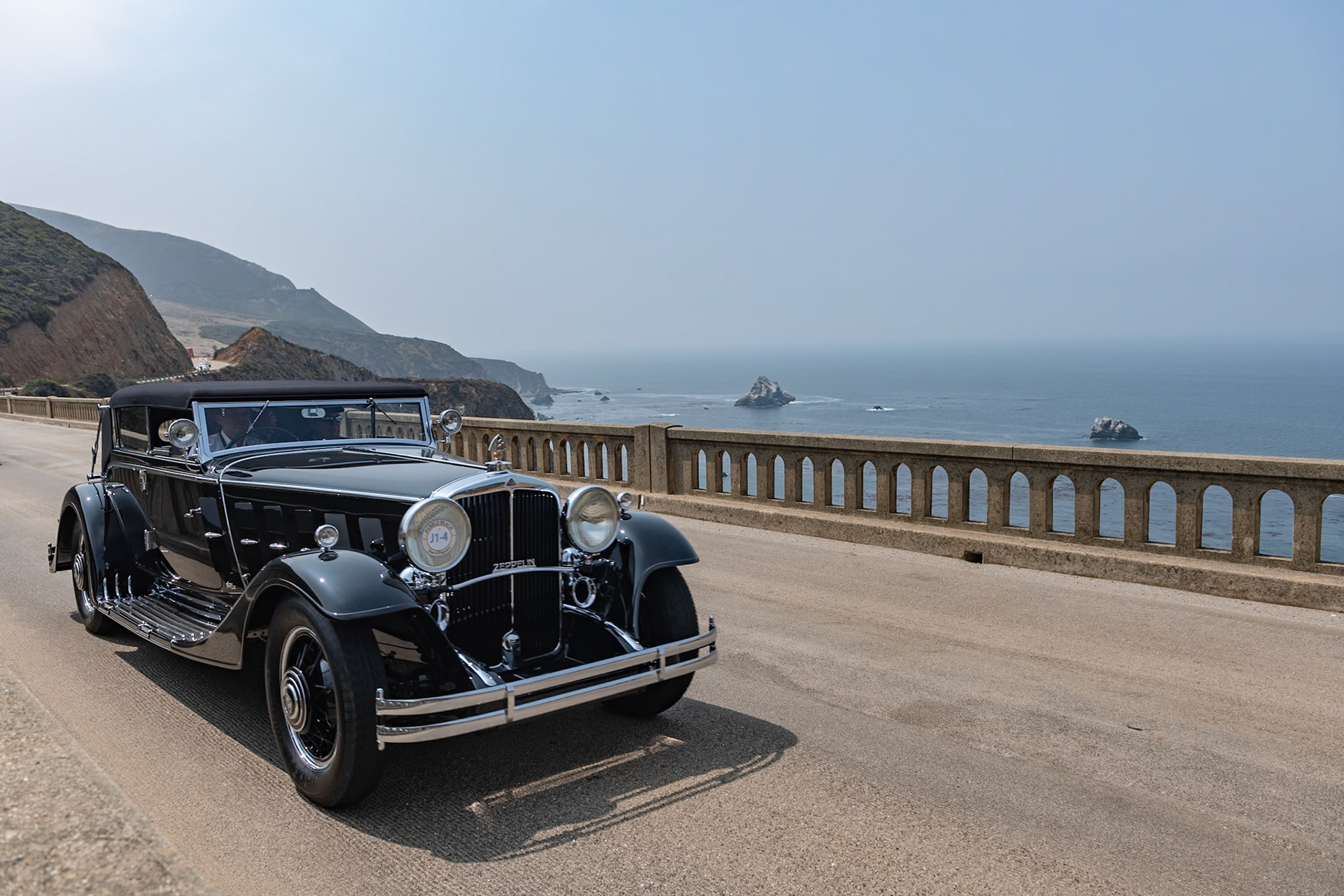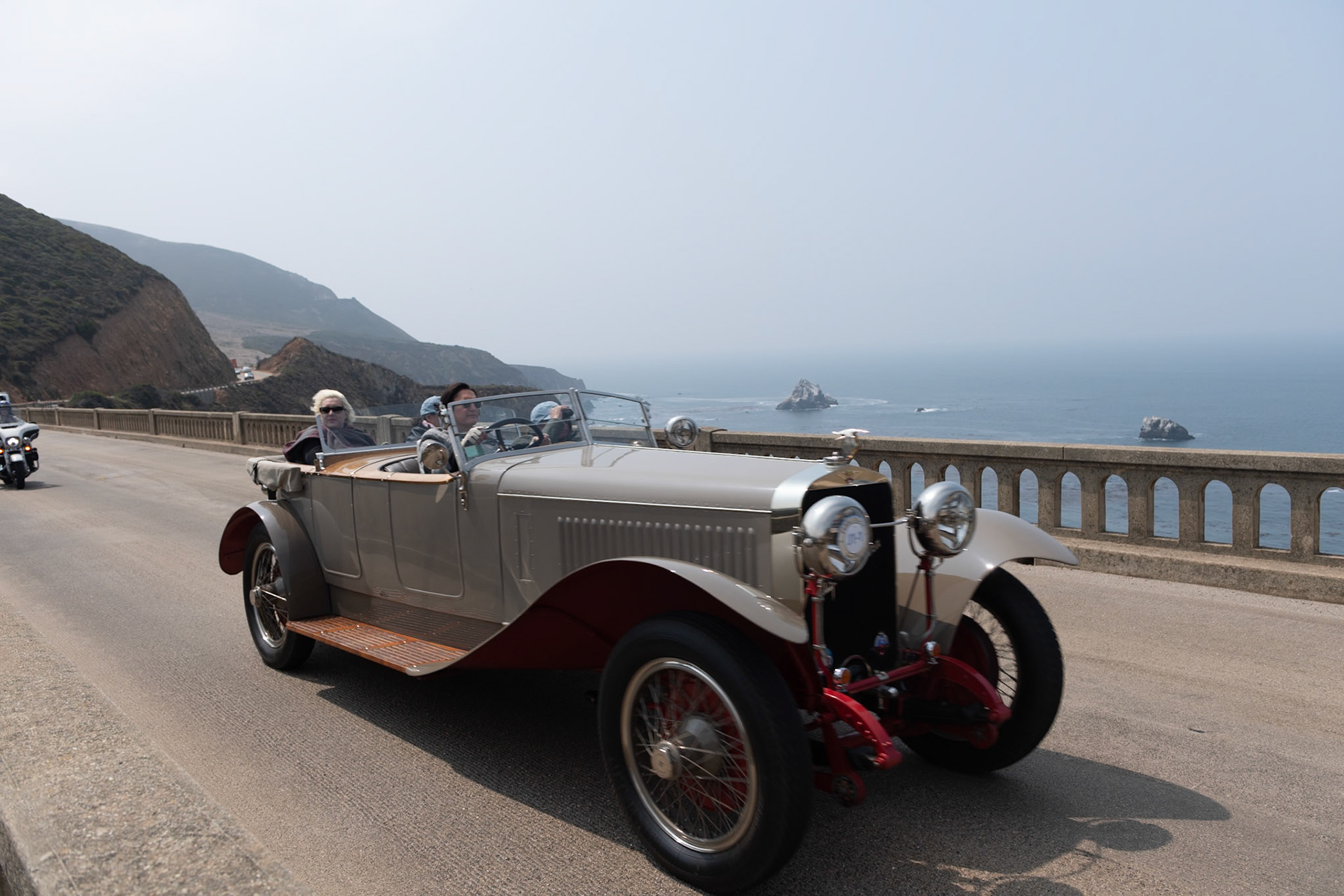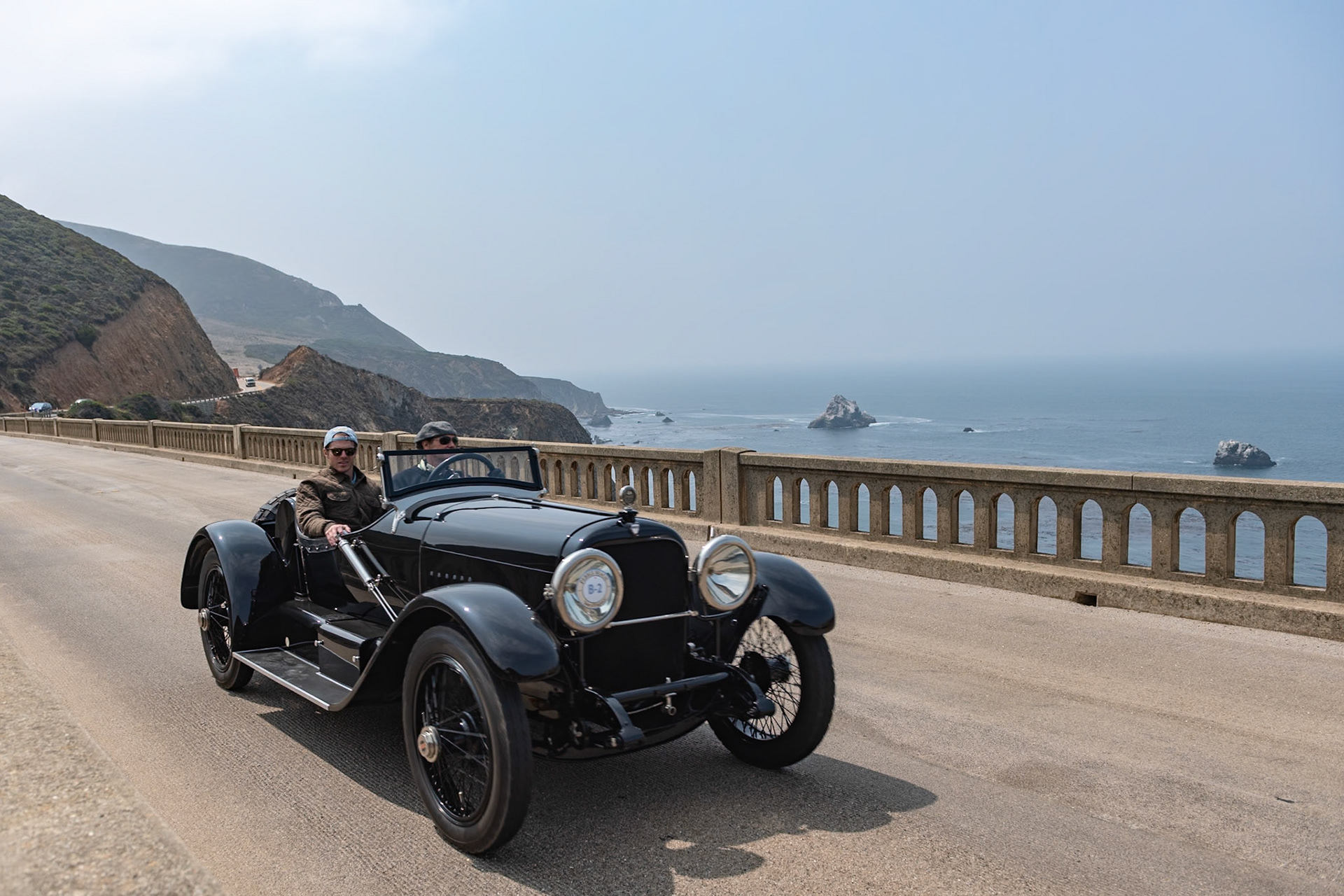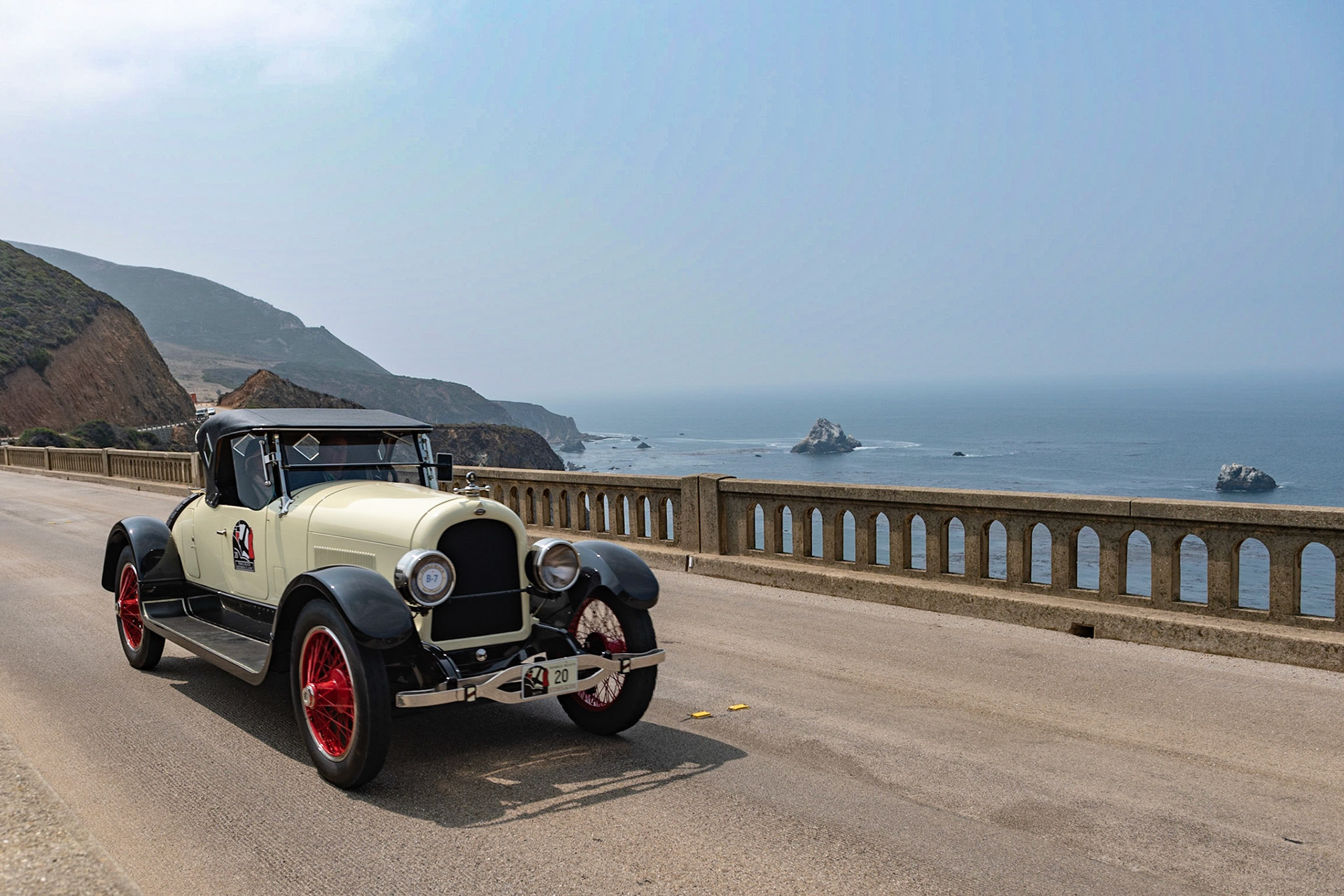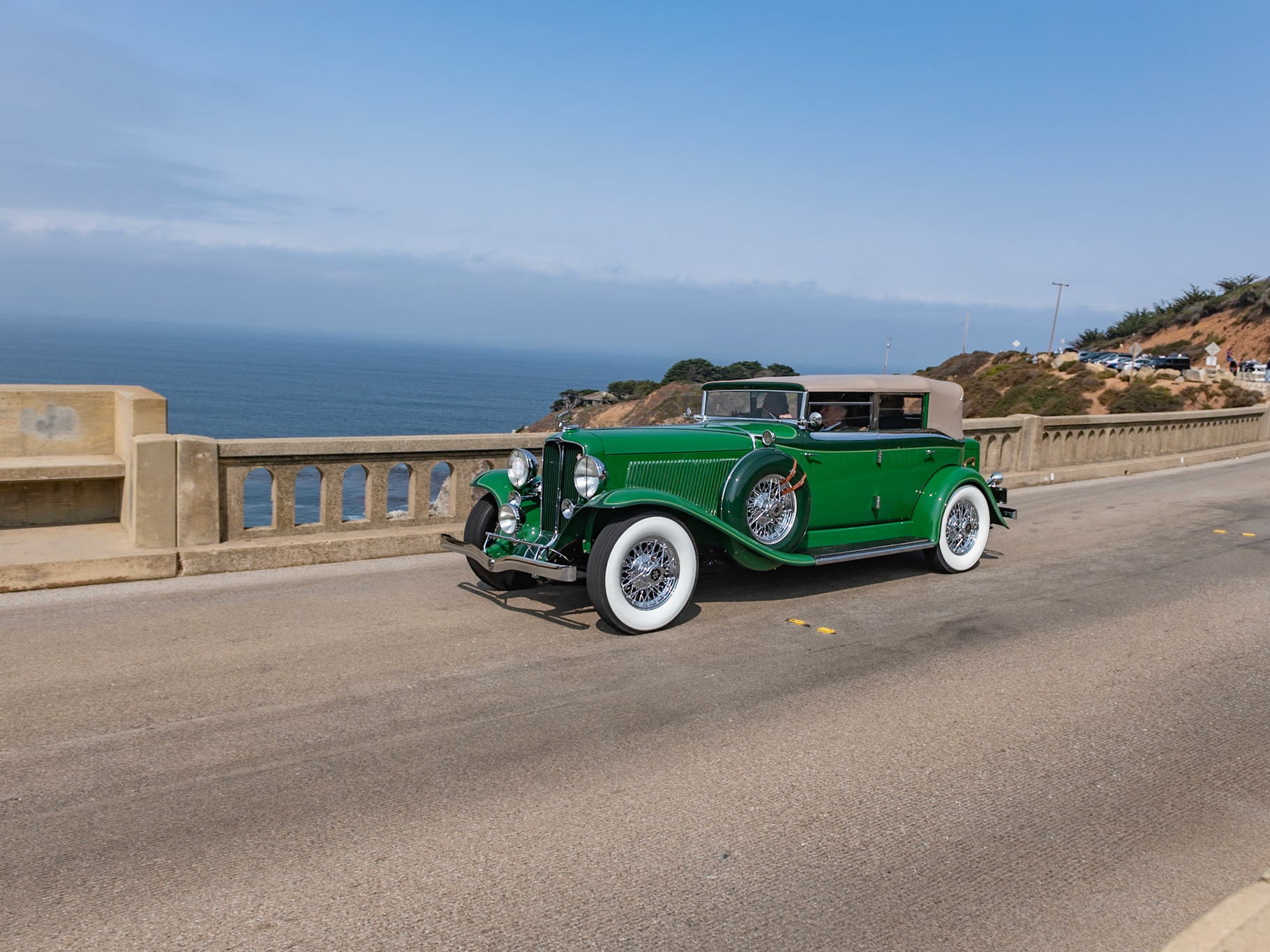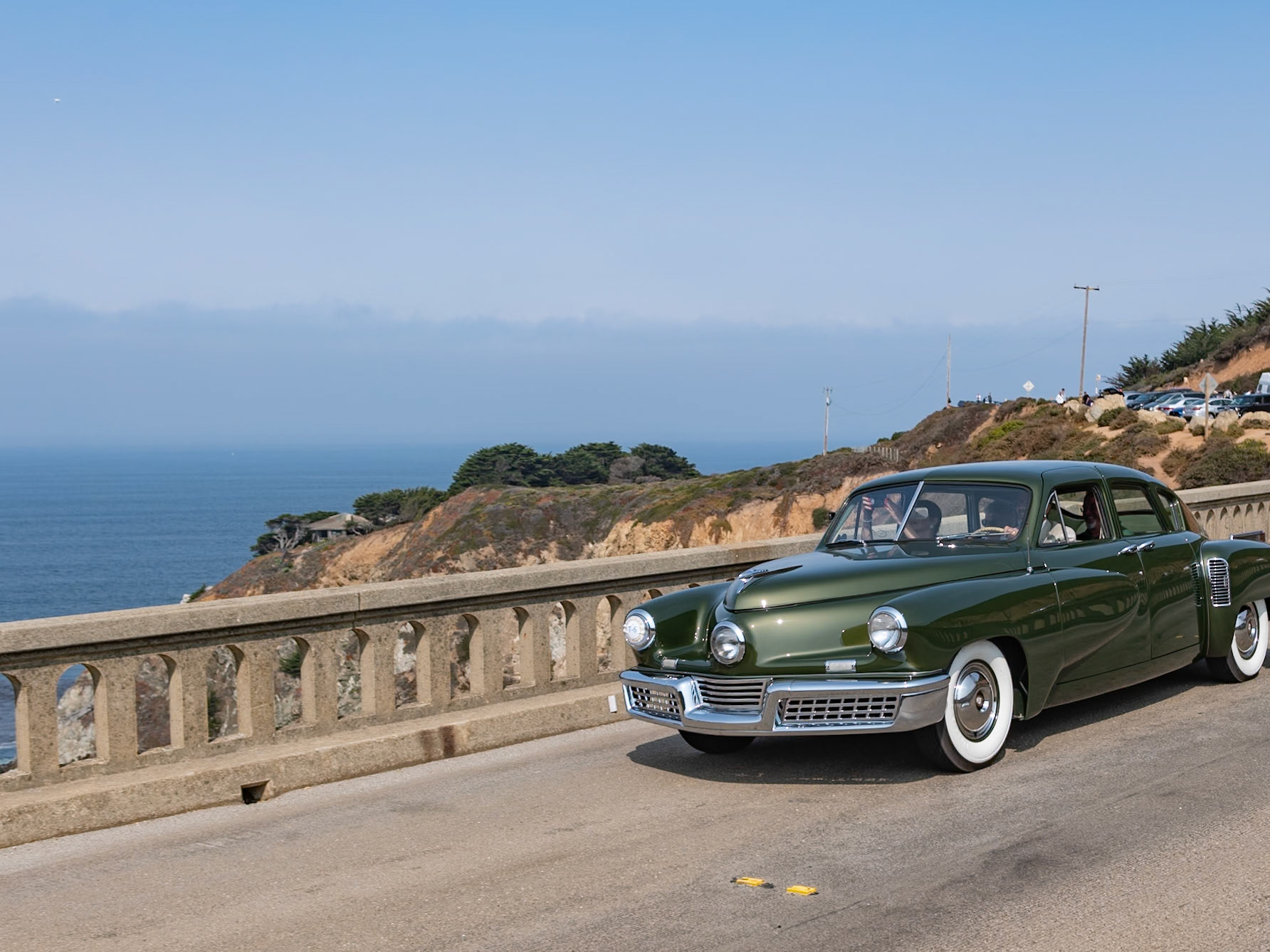
Frank Kurtis built four Kurtis 500SX sports racing cars and each one was unique. This one was built for Bill Murphy, who had owned and raced two earlier Kurtis 500S sports cars. In two years of competition, the Murphy Kurtis 500SX achieved eighteen class victories and nine overall wins against the best drivers of the day. Murphy competed in the Del Monte Trophy race in 1956, the final year of the Pebble Beach Road Races. The Murphy Kurtis 500SX still has its original Hilborn-Injected Buick Nailhead engine, Jaguar 4-speed transmission and Halibrand quick-change differential. The car sat at Murphy’s dealership for 20 years until it was purchased by Rich Siefried, who then restored it. It won the Pebble Beach Cup at the 1980 Pebble Beach Concours d’Elegance.

Introduced at the 1933 Olympia Motor Show, the Lagonda M45 had a 4½-liter, twin-plug straight-6 Meadows engine that proved to be quite a potent machine. A team of three short-chassis cars fitted with Girling drum brakes and highly tuned engines were prepared by Lagonda’s main agents, Fox & Nicholl, for the 1934 RAC Tourist Trophy, and they finished in fourth, fifth and eighth place. The following year one of these TT cars, driven by John Hindmarsh and Luis Fontes, won the 24-Hours of Le Mans. These cars were the basis for the Lagonda M45 Rapide, which quickly established itself as a favorite among sporting motorists of the day. This car was raced extensively by its owner Billy Michaels in the 1950s, but then disappeared. It was recently rediscovered hidden in a tumble-down English lock-up after 60 years of abandonment. The Rapide has just been restored and returned to competition, participating in this year’s Mille Miglia retrospective.

Richard Bosley was heavily involved in motorsport during the 1950s. He built his own sports car, the Bosley Mark I, which was used as a daily driver. Bosley later traded that car for a racing Corvette SR-2 chassis that became the foundation for this Bosley Mark II Interstate, which first turned a wheel in 1966. He named it the “Interstate” for its intended use on the miles of new highways that were springing up all over the United States. The monocoque fiberglass body was built on his Corvette chassis, and the car was fitted with a 345 bhp, Tri-power Pontiac V-8 engine and a Corvette manual transmission. The car was featured in several magazines and was also invited to The Henry Ford museum for the Annual Sports Cars Review in 1967. Abandoned until the early 1990s, it was acquired by the current owner and shipped to Florida for a complete restoration.

Richard Bosley was heavily involved in motorsport during the 1950s. He built his own sports car, the Bosley Mark I, which was used as a daily driver. Bosley later traded that car for a racing Corvette SR-2 chassis that became the foundation for this Bosley Mark II Interstate, which first turned a wheel in 1966. He named it the “Interstate” for its intended use on the miles of new highways that were springing up all over the United States. The monocoque fiberglass body was built on his Corvette chassis, and the car was fitted with a 345 bhp, Tri-power Pontiac V-8 engine and a Corvette manual transmission. The car was featured in several magazines and was also invited to The Henry Ford museum for the Annual Sports Cars Review in 1967. Abandoned until the early 1990s, it was acquired by the current owner and shipped to Florida for a complete restoration.

In 1905 Marcel Renault built a 12.3-liter car for the Vanderbilt Cup race on Long Island, and although the car failed to finish, it went on to win the Eagle Rock Hill Climb in New York later in the year. In 1906, Renault introduced the 4-cylinder, 13-liter Type AK, which was entered in the two-day Grand Prix de l’Automobile Club de France and eventually won this grueling event by some distance. Renault’s many early victories impressed William Kissam Vanderbilt Jr., often called “Willie K.,” who was one of the first people to purchase a Renault 35/45 HP Runabout built on the lighter Renault AI chassis. The Renault AI 35/45 HP model has come to be so linked with Vanderbilt that it is now often called, more simply, a Vanderbilt Renault. Famed tenor and antique car collector James Melton discovered this Vanderbilt Renault in the late 1940s still in good condition. The car was bought and sold a few times before it was acquired by Cunningham factory driver Bill Spear, who often used the car until selling it to the Indianapolis Motor Speedway Hall of Fame Museum in 1967. In 2015, the Renault was purchased by its current owner, who rebuilt the transmission and restored the car to top running order.

This unique 3½ liter SS100 is one of a small group of SS cars bodied by the Swiss coachbuilder Hermann Graber. The five-seat coupé body was designed for Monsieur Michel Dionisotti of Geneva and features two pull-down occasional seats at the rear and a small door for his skis. The car stayed in Switzerland until 1955 when a Canadian serviceman took it home with him. A restoration was begun in 1987, but after the car was dismantled, the work was halted for six years. Another collector then purchased the parts and rebuilt the coupé after a great deal of research. It was shown at Pebble Beach in 1994 and won a Class Award. It has since been restored again and repainted in this attractive Silver Gray.

Officine Meccaniche introduced the 4-cylinder Tipo 465, designed by the Austrian engineer Lucien Barratouch, in 1920. This was followed by the 6-cylinder Tipo 665 “Superba,” which was first shown at the Milan Auto Salon in 1923. The Tipo 665 remained in production until 1932 and its engine and chassis were continually improved. The first 1927 Mille Miglia witnessed a 1-2-3 finish by the OM cars, the first and last win for the company. The cars were improved further, and this OM team car is one of 25 similar models entered for the 1930 Mille Miglia. After finishing second in its class and seventh overall in the 1,000-mile race, it was also entered in the 1930 Targa Florio and the Circuito di Caserta. The car remained with the OM company, which merged with Fiat in 1938, until the car was purchased by its current owner in 2004.

Designed by Carrozzeria Touring and released in 1963, Aston Martin’s replacement for the DB4 used a new all-aluminum engine enlarged from 3.7 to 4.0 liters with triple SU carburetors as well as a new five-speed transmission, as was used in the outgoing DB4 Vantage. The DB5 also shared the latter’s faired-in headlamps. Built for Prince Abdul Ilah Bin Abdulaziz of Saudi Arabia, this Aston Martin DB5 (chassis 2270/L) was the sixth from last DB5 chassis to be built at the Aston factory in Newport Pagnell and was probably the last to be delivered. The car was equipped with every factory accessory available, including air conditioning, Marchal fog lamps, a heated rear screen, three-eared hubcaps and the rare Continental touring kit. Coming at the end of DB5 production, many of its additional features became standard equipment on its replacement, the Aston Martin DB6, launched a few months after this car was completed.

Chrysler went upmarket with their Imperial series, which began in 1926. All were fitted with 6-cylinder engines until the 8’s were introduced in 1931. The look of the CL Imperial is credited to industrial designer Alexis de Sakhnoffsky, who created several European prewar sports cars and whose work on the Cord L-29 brought him fame in the United States. All of the CL Imperial bodies with their long six-foot hood line were built by LeBaron on a 146-inch wheelbase. In 1933, Chrysler sold just over 150 CL Imperials and of those nearly a third were Close Coupled Sedans, but this is one of only four Close Coupled Sedans known to survive. It was owned and restored by the Chrysler “guru” Frank Kleptz in the mid-1990s. Its current owner bought the car in 2015 and restored it.

This Isotta Fraschini Tipo 8A wears a Castagna body similar to the car shown by Isotta Fraschini at the Commodore Hotel in 1928. The radiator wears one of the coachbuilder’s signature Art Deco radiator guards, and that is topped with a striking cobra hood ornament adopted by several American Isotta owners after one was first used by Rudolph Valentino. Other features typical of Castagna are the cut-glass running board lamps, German Silver landau arms, and multiple steps giving access to the rumble seat. The distinctive set of Grebel lights include a mother-of-pearl fender lamp depicting the badge of St. Christopher, the patron saint of travelers. The Bahre Collection acquired the car from the Craven Foundation in the early 1980s.

The Kurtis Sports Car has been called the first true American Sports Car. This example was a high school graduation gift from its originator, Frank Kurtis, to his son, Arlen. The gift came a year early and it came in pieces, so Arlen assembled it with the help of the Kurtis Kraft staff, finishing it in June 1951. The car has several unique features, including a dashboard that Arlen machined himself to fit Stewart Warner gauges. The front fenders are aluminum, while the rear fenders, hood and trunk lid are fiberglass. In designing the car, Frank Kurtis made certain there was no trace of fender contour. The bumper also really wraps around—the whole car. Arlen sold this car when he joined the Navy in 1952. Arlen’s wife and his sister bought it back for him as a surprise Christmas gift in 1990, and he completed its restoration in 2011, 60 years after he first built it. Arlen passed away in May of last year. The car is displayed here in memory and honor of both Frank and Arlen Kurtis.

The combined talents of Virgil Exner at Chrysler and Carrozzeria Ghia in Turin developed four Dodge Fire Arrows concept cars that were to be the basis of a future production model. They were extensively exhibited across America but were never put in production. They did, however, attract the attention of Eugene Casaroll; he bought the design and set up Dual Motors to build a limited run of Dual Ghias. These flamboyant cars were based on a modified Dodge chassis with a 315-cubic-inch V8 engine. Once the chassis were completed they were shipped to Italy where the bodies were fitted by Ghia. By 1956, Casaroll’s first car was finished and orders were taken from many celebrities, including Frank Sinatra, Dean Martin and Ronald Reagan. Unfortunately, the cost to build the car far exceeded expectations, so only 115 Dual Ghias were completed and just 36 are known to have survived.

Isotta Fraschini marketed their elegant automobiles to the new American aristocracy, the stars of stage and screen—and they flocked to Isotta’s showrooms on Fifth Avenue in New York City, often paying a lot more for an Isotta than they would have paid for a Model J Duesenberg. Clara Bow and Rudolph Valentino both owned Isottas. This 8A SS chassis was built at the Isotta Fraschini factory in Milan then shipped to the LeBaron Company to be fitted with this two-seat boattail body for America’s “Darling of Broadway and The Silent Screen,” Marguerite Clark, who was the inspiration for Walt Disney’s character Snow White. The car was later owned by Jim Thomas in the 1960s. It was shown by Peter T. Boyle at the 2007 Pebble Beach Concours d’Elegance and placed Second in Class.

Giovanni Moretti founded his company in 1925 to build and sell racing motorcycles, then in the late 1930s he designed his first car. These were modest sports cars with 600 cc engines; as with many small Italian sports cars, the Morettis were inspired by the Mille Miglia. At the 1950 Turin Auto Salon Moretti presented his own 750 cc twin-cam engine, and it was used in at least two cars in the 1956 Le Mans 24 Hours Race. A 1200 cc version of Moretti’s 4-cylinder engine was later installed in this car, one of two Spyders designed by Giovanni Michelotti. The car was shown on the Moretti stand at the 1955 Brussels Motor Show, where Pierre Haverland of Liège purchased it. He kept it for nearly 20 years, racing it in the Tour de Belgique Rally in 1955 and at a local event held on a frozen lake in the winter of 1962. After he sold the car, it was later abandoned, but it was saved in 2000 by Martin Dijkhof, who oversaw its complete restoration.

Frank Kurtis built four Kurtis 500SX sports racing cars and each one was unique. This one was built for Bill Murphy, who had owned and raced two earlier Kurtis 500S sports cars. In two years of competition, the Murphy Kurtis 500SX achieved eighteen class victories and nine overall wins against the best drivers of the day. Murphy competed in the Del Monte Trophy race in 1956, the final year of the Pebble Beach Road Races. The Murphy Kurtis 500SX still has its original Hilborn-Injected Buick Nailhead engine, Jaguar 4-speed transmission and Halibrand quick-change differential. The car sat at Murphy’s dealership for 20 years until it was purchased by Rich Siefried, who then restored it. It won the Pebble Beach Cup at the 1980 Pebble Beach Concours d’Elegance.

Richard Bosley was heavily involved in motorsport during the 1950s. He built his own sports car, the Bosley Mark I, which was used as a daily driver. Bosley later traded that car for a racing Corvette SR-2 chassis that became the foundation for this Bosley Mark II Interstate, which first turned a wheel in 1966. He named it the “Interstate” for its intended use on the miles of new highways that were springing up all over the United States. The monocoque fiberglass body was built on his Corvette chassis, and the car was fitted with a 345 bhp, Tri-power Pontiac V-8 engine and a Corvette manual transmission. The car was featured in several magazines and was also invited to The Henry Ford museum for the Annual Sports Cars Review in 1967. Abandoned until the early 1990s, it was acquired by the current owner and shipped to Florida for a complete restoration.

The small Italian automaker Cisitalia was founded by the wealthy industrialist and sportsman Piero Dusio in 1946. His first cars were single-seat racers based on the Fiat 500 Topolino, and several were raced as voiturettes. In 1947 Dusio produced his first road car, the Cisitalia 202, the first of which were coupes styled by Pinin Farina. Later, Vignale bodied a small run of lightweight cabriolets, a few of which were built in steel and aluminum, including this car, a second series model. This car is one of six built by Cisitalia and sent to Uruguay in 1950 for Emilio Fontana, who was the Cisitalia dealer for South America. Its first owner sold the car to a US Air Force pilot in 1959 who kept it until 1970. Then, in 1986, it was sold to an Italian collector, who brought it home to Italy to be restored. Its current owner saw the car in the Mille Miglia Museum in 2013 and purchased it a year later.

In 1946 in Warwick, England, Donald Healey formed a car company to build the Healey Elliot, a fast saloon with a Riley engine. The Healey Elliot won the 1947 and 1948 Alpine Rallies as well as the touring class at the 1948 Mille Miglia. A sports car, the Healey Silverstone, followed in 1949. Designed by Healey and Gerry Coker on an Elliot saloon chassis, the Silverstone was sold as a dual-purpose road and race car with a 2,443 cc, 104 bhp 4-cylinder Riley engine. Healey sold 105 Silverstones over the following year and this car was the third to be built. It was delivered to Francis Robinson of Newport, Rhode Island. He is listed as entering this car in the 1950 SCCA Watkins Glen Grand Prix alongside Briggs Cunningham, who drove his own Silverstone. This is thought to be the most original Healey Silverstone in the world; most of the others have been upgraded and modified for racing.

This unique 3½ liter SS100 is one of a small group of SS cars bodied by the Swiss coachbuilder Hermann Graber. The five-seat coupé body was designed for Monsieur Michel Dionisotti of Geneva and features two pull-down occasional seats at the rear and a small door for his skis. The car stayed in Switzerland until 1955 when a Canadian serviceman took it home with him. A restoration was begun in 1987, but after the car was dismantled, the work was halted for six years. Another collector then purchased the parts and rebuilt the coupé after a great deal of research. It was shown at Pebble Beach in 1994 and won a Class Award. It has since been restored again and repainted in this attractive Silver Gray.

Gordon B. Logan and Gordon E. Logan, Georgetown, TX

The Farago was a design exercise by ex-Ghia engineers Paul Farago and Sergio Coggiola. Farago had worked with Vigil Exner in developing the Chrysler/Ghia concept cars and was also the chief engineer for the Dual Ghia project. He later designed the Ghia L6.4 built for some of the Hollywood elite. Farago and Coggiola opened Carrozzeria Coggiola in Turin in 1966 and went on to produce prototypes for many companies, including SAAB, Lancia and Volvo. One of the first projects to be completed was this car, the Farago CF 428, which was built for John DeLorean while he was head of the Pontiac Motor Division of General Motors and was intended to show GM what an Italian-designed Pontiac could look like.

Officine Meccaniche introduced the 4-cylinder Tipo 465, designed by the Austrian engineer Lucien Barratouch, in 1920. This was followed by the 6-cylinder Tipo 665 “Superba,” which was first shown at the Milan Auto Salon in 1923. The Tipo 665 remained in production until 1932 and its engine and chassis were continually improved. The first 1927 Mille Miglia witnessed a 1-2-3 finish by the OM cars, the first and last win for the company. The cars were improved further, and this OM team car is one of 25 similar models entered for the 1930 Mille Miglia. After finishing second in its class and seventh overall in the 1,000-mile race, it was also entered in the 1930 Targa Florio and the Circuito di Caserta. The car remained with the OM company, which merged with Fiat in 1938, until the car was purchased by its current owner in 2004.

Isotta Fraschini introduced the Tipo 8 with its unique in-line eight-cylinder engine in 1919. After five years and much development, the Tipo 8A was introduced, offering a more powerful engine, a redesigned frame and a new three-speed synchromesh transmission. The roadster body on this Tipo 8A was originally designed by LeBaron for the actor Rudolph Valentino, but it was not built until after his death. This Tipo 8A Roadster, one of two similar cars bodied by Fleetwood, was shown at the 1927 New York Auto Show. After the show it was bought by financier John Locke as a gift for Peggy Hopkins Joyce, a celebrity who lived a rather scandalous life—and she gained notoriety when this car was seized by Isotta Fraschini of New York for nonpayment. She parted company with her car in the late 1930s, but it remained on the East Coast passing among a variety of owners until being acquired by Judge Cassini in 2000.

This Frank Feeley–designed Drophead Coupé, one of the most graceful designs seen on a Lagonda, was built right at the Lagonda factory. Only 185 V12 Lagondas were built before the war intervened and this car is listed in factory records as one of the last seven to be completed. The car was shipped to its first owner, Joseph Luchs in New York, a month after war broke out. The car was fitted with a number of special accessories, including a central headlamp and rear fender skirts. To balance the spare wheel on one side, a set of tools and spare spark plugs were ingeniously concealed in a faux spare wheel casing on the other side. Nicknamed “Lipstick,” this Lagonda has lived its entire life in the United States, including time at Harrah’s Automobile Collection and the Blackhawk Museum. It was recently purchased by its current owner, and it is making its first appearance at Pebble Beach after a recent restoration.

This Cleveland-built 1928 Stearns-Knight H 8-90 deluxe cabriolet was engineered to be one of the fastest production cars in the United States in the late 1920s, reaching speeds of 110 mph. It is the only remaining 8-cylinder Stearns-Knight cabriolet known to exist on the 137-inch wheelbase chassis. The Stearns 385-cubic-inch sleeve-valve engine was the largest sleeve-valve engine in America at the time. Due to its high price just 327 examples were built, and today only eight remain in the world. This car was originally owned by a wealthy Idaho mining tycoon before it passed into the hands of Charles Lillengreen of Davenport, Washington, in the early 1960s. The Lillengreens sold it to Al Giddings of Montana in 2003, and he restored it with advice from Stearns-Knight historians before its current owner acquired it in 2015.

This Lagonda, built in January 1938, is the first of the V12-engined Rapides. The 4.5-liter V12 was designed by W. O. Bentley after he left Rolls-Royce. This car, believed to be one of just 12 Rapides built to this design as a drophead coupé, was sold to the building magnate and car collector Sir Alfred McAlpine, who used it regularly until 1955. During a service visit to the Lagonda works in 1941, it was fitted with the four-carburetor setup used by the Lagonda team cars at Le Mans in 1939. It has since spent decades in both the United States and Europe, and was owned for a time by Lord Anthony Bamford. At one point it received a ground-up four-year restoration, but in recent years it has rarely been shown in public.

In 1936, Aston Martin developed a new 2-liter engine designed by the brilliant engineer Claude Hill. A new chassis was also designed to fit it, and this became the legendary Speed Model. In its first race, at the 1938 Tourist Trophy at Donnington, the Aston Martin won its class and was second overall with St. John Horsfall at the wheel. The last eight Speed Models to be assembled in 1939 and 1940 were fitted with this unusual aerodynamic steel-framed aluminum body. This Type C competition specification Speed Model is thought to be the final Aston Martin built before World War II; it was delivered just before Christmas 1940 to its first owner, Mr. Ansell of Romsey, England, who used the car in the first postwar Brighton Speed Trials in 1946. Its next owner, a Miss Bean, drove the car in the AMOC Rally in 1949, coming in first in class. After several British owners, the car was restored in 2002 by classic Aston experts Ecurie Bertelli.

Produced from 1934 until 1937, the Chrysler Airflow used streamlining as the basis for a new kind of automobile. After testing at the Wright Brothers’ wind tunnel facilities in Dayton, Ohio, Chrysler threw away the traditional more upright style of car. Its engineers moved the headlights into the fenders, incorporated a sloping waterfall grille and on the CW model only introduced the first one-piece curved windshield in a production automobile. The 385-cubic-inch straight-8 engine was moved forward, significantly improving ride quality, and an industry-first automatic overdrive was fitted, allowing high-speed driving without taxing the engine. The car could seat eight people with three abreast in front and back and two in jump seats. Sadly, sales were disappointing; less than ten 1935 CW Imperial LeBaron Limousines were built, and this is the only surviving example. Ten years later nearly all of the Airflow’s radical features found their way onto many of the world’s automobiles.

Designed by Carrozzeria Touring and released in 1963, Aston Martin’s replacement for the DB4 used a new all-aluminum engine enlarged from 3.7 to 4.0 liters with triple SU carburetors as well as a new five-speed transmission, as was used in the outgoing DB4 Vantage. The DB5 also shared the latter’s faired-in headlamps. Built for Prince Abdul Ilah Bin Abdulaziz of Saudi Arabia, this Aston Martin DB5 (chassis 2270/L) was the sixth from last DB5 chassis to be built at the Aston factory in Newport Pagnell and was probably the last to be delivered. The car was equipped with every factory accessory available, including air conditioning, Marchal fog lamps, a heated rear screen, three-eared hubcaps and the rare Continental touring kit. Coming at the end of DB5 production, many of its additional features became standard equipment on its replacement, the Aston Martin DB6, launched a few months after this car was completed.

This Isotta Fraschini was the top model for Isotta Fraschini. It was powered by an 8A SS straight-eight 7.3-liter engine guaranteed to perform at 100 mph. The SS stands for Super Spinto, which translates, appropriately, to “racy” or “driven.” This Castagna body is an exceptional example with an interior that has been carefully refurbished by its current owner. It is possible that this is the car displayed by Isotta Fraschini at the 1930 Milan Auto Salon before being exported to the United States for sale through the marque’s New York agents. It is thought that the car’s first owner was William Randolph Hearst Jr., son of the renowned media mogul. The car’s current owner is a lifelong fan of the marque; he purchased his first Isotta when he was just 22, but then had to sell it for just $300—ouch!—when he joined the army!

This Isotta Fraschini was the top model for Isotta Fraschini. It was powered by an 8A SS straight-eight 7.3-liter engine guaranteed to perform at 100 mph. The SS stands for Super Spinto, which translates, appropriately, to “racy” or “driven.” This Castagna body is an exceptional example with an interior that has been carefully refurbished by its current owner. It is possible that this is the car displayed by Isotta Fraschini at the 1930 Milan Auto Salon before being exported to the United States for sale through the marque’s New York agents. It is thought that the car’s first owner was William Randolph Hearst Jr., son of the renowned media mogul. The car’s current owner is a lifelong fan of the marque; he purchased his first Isotta when he was just 22, but then had to sell it for just $300—ouch!—when he joined the army!

This Isotta Fraschini was the top model for Isotta Fraschini. It was powered by an 8A SS straight-eight 7.3-liter engine guaranteed to perform at 100 mph. The SS stands for Super Spinto, which translates, appropriately, to “racy” or “driven.” This Castagna body is an exceptional example with an interior that has been carefully refurbished by its current owner. It is possible that this is the car displayed by Isotta Fraschini at the 1930 Milan Auto Salon before being exported to the United States for sale through the marque’s New York agents. It is thought that the car’s first owner was William Randolph Hearst Jr., son of the renowned media mogul. The car’s current owner is a lifelong fan of the marque; he purchased his first Isotta when he was just 22, but then had to sell it for just $300—ouch!—when he joined the army!

Chrysler went upmarket with their Imperial series, which began in 1926. All were fitted with 6-cylinder engines until the 8’s were introduced in 1931. The look of the CL Imperial is credited to industrial designer Alexis de Sakhnoffsky, who created several European prewar sports cars and whose work on the Cord L-29 brought him fame in the United States. All of the CL Imperial bodies with their long six-foot hood line were built by LeBaron on a 146-inch wheelbase. In 1933, Chrysler sold just over 150 CL Imperials and of those nearly a third were Close Coupled Sedans, but this is one of only four Close Coupled Sedans known to survive. It was owned and restored by the Chrysler “guru” Frank Kleptz in the mid-1990s. Its current owner bought the car in 2015 and restored it.

This Isotta Fraschini Tipo 8A wears a Castagna body similar to the car shown by Isotta Fraschini at the Commodore Hotel in 1928. The radiator wears one of the coachbuilder’s signature Art Deco radiator guards, and that is topped with a striking cobra hood ornament adopted by several American Isotta owners after one was first used by Rudolph Valentino. Other features typical of Castagna are the cut-glass running board lamps, German Silver landau arms, and multiple steps giving access to the rumble seat. The distinctive set of Grebel lights include a mother-of-pearl fender lamp depicting the badge of St. Christopher, the patron saint of travelers. The Bahre Collection acquired the car from the Craven Foundation in the early 1980s.

The Kurtis Sports Car has been called the first true American Sports Car. This example was a high school graduation gift from its originator, Frank Kurtis, to his son, Arlen. The gift came a year early and it came in pieces, so Arlen assembled it with the help of the Kurtis Kraft staff, finishing it in June 1951. The car has several unique features, including a dashboard that Arlen machined himself to fit Stewart Warner gauges. The front fenders are aluminum, while the rear fenders, hood and trunk lid are fiberglass. In designing the car, Frank Kurtis made certain there was no trace of fender contour. The bumper also really wraps around—the whole car. Arlen sold this car when he joined the Navy in 1952. Arlen’s wife and his sister bought it back for him as a surprise Christmas gift in 1990, and he completed its restoration in 2011, 60 years after he first built it. Arlen passed away in May of last year. The car is displayed here in memory and honor of both Frank and Arlen Kurtis.

This 1929 Tipo 8A bodied by Cesare Sala is thought to have been delivered to Alpe & Saunders, a car dealership and coachwork company in London, which sold it to a young Indian prince, the Raja Sajid Husain Ali of Kotwara, who was studying at Edinburgh University. The prince had seen his favorite film star and Isotta owner Rudolph Valentino in the film The Young Rajah, and this influenced his choice of automobile. He returned to India in 1937 to marry the Princess Selma, Sultana of Turkey, and the Isotta was used as their wedding car. It remained with the royal family there until the 1970s, when it was purchased at auction by Peter Grant, manager of the legendary rock band Led Zeppelin. The car later went to the Imperial Palace Collection in Las Vegas. It was last seen at Pebble Beach in 2008.

The combined talents of Virgil Exner at Chrysler and Carrozzeria Ghia in Turin developed four Dodge Fire Arrows concept cars that were to be the basis of a future production model. They were extensively exhibited across America but were never put in production. They did, however, attract the attention of Eugene Casaroll; he bought the design and set up Dual Motors to build a limited run of Dual Ghias. These flamboyant cars were based on a modified Dodge chassis with a 315-cubic-inch V8 engine. Once the chassis were completed they were shipped to Italy where the bodies were fitted by Ghia. By 1956, Casaroll’s first car was finished and orders were taken from many celebrities, including Frank Sinatra, Dean Martin and Ronald Reagan. Unfortunately, the cost to build the car far exceeded expectations, so only 115 Dual Ghias were completed and just 36 are known to have survived.

The J12, produced between 1931 and 1938, was the largest and most expensive automobile ever built by Hispano-Suiza. This is the first of these ultra-luxurious 9.4-liter, 12-cylinder cars to be completed. The factory sent the chassis to Saoutchik, who built this Transformable Grand Luxe coachwork for the 1931 Paris Auto Salon, then showed it at the Olympia Motor Show in London. The first owner was the Shah of Persia, who used it as a royal parade car. The J12 remained in the royal garage until 1963 when it went to American collector Robert D. Ortenburger. In 1979 it was sold to Roy Southward of Wellington, New Zealand. The current owners purchased the car in 2011. It has since been restored and driven on several tours covering nearly 20,000 miles.

The J12, produced between 1931 and 1938, was the largest and most expensive automobile ever built by Hispano-Suiza. This is the first of these ultra-luxurious 9.4-liter, 12-cylinder cars to be completed. The factory sent the chassis to Saoutchik, who built this Transformable Grand Luxe coachwork for the 1931 Paris Auto Salon, then showed it at the Olympia Motor Show in London. The first owner was the Shah of Persia, who used it as a royal parade car. The J12 remained in the royal garage until 1963 when it went to American collector Robert D. Ortenburger. In 1979 it was sold to Roy Southward of Wellington, New Zealand. The current owners purchased the car in 2011. It has since been restored and driven on several tours covering nearly 20,000 miles.

Isotta Fraschini marketed their elegant automobiles to the new American aristocracy, the stars of stage and screen—and they flocked to Isotta’s showrooms on Fifth Avenue in New York City, often paying a lot more for an Isotta than they would have paid for a Model J Duesenberg. Clara Bow and Rudolph Valentino both owned Isottas. This 8A SS chassis was built at the Isotta Fraschini factory in Milan then shipped to the LeBaron Company to be fitted with this two-seat boattail body for America’s “Darling of Broadway and The Silent Screen,” Marguerite Clark, who was the inspiration for Walt Disney’s character Snow White. The car was later owned by Jim Thomas in the 1960s. It was shown by Peter T. Boyle at the 2007 Pebble Beach Concours d’Elegance and placed Second in Class.

The small Italian automaker Cisitalia was founded by the wealthy industrialist and sportsman Piero Dusio in 1946. His first cars were single-seat racers based on the Fiat 500 Topolino, and several were raced as voiturettes. In 1947 Dusio produced his first road car, the Cisitalia 202, the first of which were coupes styled by Pinin Farina. Later, Vignale bodied a small run of lightweight cabriolets, a few of which were built in steel and aluminum, including this car, a second series model. This car is one of six built by Cisitalia and sent to Uruguay in 1950 for Emilio Fontana, who was the Cisitalia dealer for South America. Its first owner sold the car to a US Air Force pilot in 1959 who kept it until 1970. Then, in 1986, it was sold to an Italian collector, who brought it home to Italy to be restored. Its current owner saw the car in the Mille Miglia Museum in 2013 and purchased it a year later.

In 1946 in Warwick, England, Donald Healey formed a car company to build the Healey Elliot, a fast saloon with a Riley engine. The Healey Elliot won the 1947 and 1948 Alpine Rallies as well as the touring class at the 1948 Mille Miglia. A sports car, the Healey Silverstone, followed in 1949. Designed by Healey and Gerry Coker on an Elliot saloon chassis, the Silverstone was sold as a dual-purpose road and race car with a 2,443 cc, 104 bhp 4-cylinder Riley engine. Healey sold 105 Silverstones over the following year and this car was the third to be built. It was delivered to Francis Robinson of Newport, Rhode Island. He is listed as entering this car in the 1950 SCCA Watkins Glen Grand Prix alongside Briggs Cunningham, who drove his own Silverstone. This is thought to be the most original Healey Silverstone in the world; most of the others have been upgraded and modified for racing.

Meg Salyer, Oklahoma City, OK and Nick Channing, England

The Farago was a design exercise by ex-Ghia engineers Paul Farago and Sergio Coggiola. Farago had worked with Vigil Exner in developing the Chrysler/Ghia concept cars and was also the chief engineer for the Dual Ghia project. He later designed the Ghia L6.4 built for some of the Hollywood elite. Farago and Coggiola opened Carrozzeria Coggiola in Turin in 1966 and went on to produce prototypes for many companies, including SAAB, Lancia and Volvo. One of the first projects to be completed was this car, the Farago CF 428, which was built for John DeLorean while he was head of the Pontiac Motor Division of General Motors and was intended to show GM what an Italian-designed Pontiac could look like.

The Marmon V16 engine was first seen at the Chicago Auto Show in November 1930, but due to production delays, the new Marmon Sixteens were not delivered until April of the following year—at the beginning of the Great Depression. Billed as “The World’s Most Advanced Motor Car,” it was a serious competitor to Cadillac’s V-16, which had gone on sale the year before. The new all-aluminum power plant was an engineering marvel as well as a work of art, earning Howard Marmon the annual design achievement award from the Society of Automotive Engineers. The 8-liter, overhead valve, 16-cylinder engine delivered 200 bhp, and a typical V16 with saloon body was capable of driving at over 95 mph. Unfortunately, given the economic downturn, few people could afford this $5,000 luxury automobile, so fewer than 400 cars were produced, and in 1933 the Marmon Motor Car Company went into receivership. This Sixteen is one of around 70 Marmons that have survived. It has just been restored by its multiple-Marmon-owning owner.

The Marmon V16 engine was first seen at the Chicago Auto Show in November 1930, but due to production delays, the new Marmon Sixteens were not delivered until April of the following year—at the beginning of the Great Depression. Billed as “The World’s Most Advanced Motor Car,” it was a serious competitor to Cadillac’s V-16, which had gone on sale the year before. The new all-aluminum power plant was an engineering marvel as well as a work of art, earning Howard Marmon the annual design achievement award from the Society of Automotive Engineers. The 8-liter, overhead valve, 16-cylinder engine delivered 200 bhp, and a typical V16 with saloon body was capable of driving at over 95 mph. Unfortunately, given the economic downturn, few people could afford this $5,000 luxury automobile, so fewer than 400 cars were produced, and in 1933 the Marmon Motor Car Company went into receivership. This Sixteen is one of around 70 Marmons that have survived. It has just been restored by its multiple-Marmon-owning owner.

The Oldsmobile offering in the GM trio for 1953 was named the Fiesta, and it was the lowest production convertible of the three with just 458 examples built. Styling included the all-new General Motors wraparound windshield, special belt line dip and custom wheel treatments. The Fiesta sold for a whopping $5,717, over $2,500 more than the standard Oldsmobile 98 convertible. It was powered by Oldsmobile’s Rocket 303 cubic inch, V8 engine, which in its Fiesta configuration produced 185 horsepower. Special leather interiors and a full complement of accessories came as standard equipment, which made the Fiesta a very unique automobile. It is rarely seen today.

The Oldsmobile offering in the GM trio for 1953 was named the Fiesta, and it was the lowest production convertible of the three with just 458 examples built. Styling included the all-new General Motors wraparound windshield, special belt line dip and custom wheel treatments. The Fiesta sold for a whopping $5,717, over $2,500 more than the standard Oldsmobile 98 convertible. It was powered by Oldsmobile’s Rocket 303 cubic inch, V8 engine, which in its Fiesta configuration produced 185 horsepower. Special leather interiors and a full complement of accessories came as standard equipment, which made the Fiesta a very unique automobile. It is rarely seen today.

The last chassis completely designed and built by Delage was the D8-85, which was introduced at the Paris Auto Salon in 1934. This chassis was fitted with a 3.5-liter straight-8 engine. Fewer than 100 examples were built and very few remain today. This D8-85 was originally bodied by Henri Chapron and delivered to it first owner, Dr. Imbert in Algiers. In 1948, Dr. Imbert commissioned Robert Clabot, a coachbuilder in Alfortville, near Paris, to design more modern coachwork for his car. Clabot, who specialized in updating prewar cars, had been trained by Jacques Saoutchik where he developed his avant-garde style. The result was this unique Delage that owes a great deal to some of Gordon Buehrig’s many masterpieces. When the car was completed Dr. Imbert showed it at several European concours. The doctor kept the car until the 1960s when it went to live in the Netherlands where it was first restored. The car was later put on display at the Stichting Beheer Automobiel Museum.

The last chassis completely designed and built by Delage was the D8-85, which was introduced at the Paris Auto Salon in 1934. This chassis was fitted with a 3.5-liter straight-8 engine. Fewer than 100 examples were built and very few remain today. This D8-85 was originally bodied by Henri Chapron and delivered to it first owner, Dr. Imbert in Algiers. In 1948, Dr. Imbert commissioned Robert Clabot, a coachbuilder in Alfortville, near Paris, to design more modern coachwork for his car. Clabot, who specialized in updating prewar cars, had been trained by Jacques Saoutchik where he developed his avant-garde style. The result was this unique Delage that owes a great deal to some of Gordon Buehrig’s many masterpieces. When the car was completed Dr. Imbert showed it at several European concours. The doctor kept the car until the 1960s when it went to live in the Netherlands where it was first restored. The car was later put on display at the Stichting Beheer Automobiel Museum.

The last chassis completely designed and built by Delage was the D8-85, which was introduced at the Paris Auto Salon in 1934. This chassis was fitted with a 3.5-liter straight-8 engine. Fewer than 100 examples were built and very few remain today. This D8-85 was originally bodied by Henri Chapron and delivered to it first owner, Dr. Imbert in Algiers. In 1948, Dr. Imbert commissioned Robert Clabot, a coachbuilder in Alfortville, near Paris, to design more modern coachwork for his car. Clabot, who specialized in updating prewar cars, had been trained by Jacques Saoutchik where he developed his avant-garde style. The result was this unique Delage that owes a great deal to some of Gordon Buehrig’s many masterpieces. When the car was completed Dr. Imbert showed it at several European concours. The doctor kept the car until the 1960s when it went to live in the Netherlands where it was first restored. The car was later put on display at the Stichting Beheer Automobiel Museum.

This Lagonda V12 Rapide was delivered to James Young in South London to have a special drophead coupé body fitted in October 1939. This chassis is one of just two Lagonda Rapides that does not carry the standard Frank Feeley–designed drophead coachwork, and it has a rear-mounted spare wheel instead of the side-mounted spares seen on factory-bodied cars. It was ordered for Anthony Gillson and his wife, American heiress Priscilla of Gloucestershire, England. Toward the end of the war, the car was purchased by Davies Motors, which had taken over servicing Lagondas following the closure of the factory in 1939. This car remained in England until 1957 when, with just 10,000 miles on the clock, it was exported to Australia and its new owner, a resident of New South Wales. In 2015 it was purchased by its current owner and sympathetically refurbished in New Zealand, still with less than 32,000 miles under its wheels.

This Lagonda V12 Rapide was delivered to James Young in South London to have a special drophead coupé body fitted in October 1939. This chassis is one of just two Lagonda Rapides that does not carry the standard Frank Feeley–designed drophead coachwork, and it has a rear-mounted spare wheel instead of the side-mounted spares seen on factory-bodied cars. It was ordered for Anthony Gillson and his wife, American heiress Priscilla of Gloucestershire, England. Toward the end of the war, the car was purchased by Davies Motors, which had taken over servicing Lagondas following the closure of the factory in 1939. This car remained in England until 1957 when, with just 10,000 miles on the clock, it was exported to Australia and its new owner, a resident of New South Wales. In 2015 it was purchased by its current owner and sympathetically refurbished in New Zealand, still with less than 32,000 miles under its wheels.






The Studebaker Commander Starlight Coupe, designed by Raymond Loewy in 1954, was the first all-new Studebaker since 1947. Although it had a relatively old-fashioned V8 engine beneath its hood, the low-slung European design was far ahead of its time. This car was first purchased by William Babich of East Pittsburgh and remained with him for 60 years. He cared for this car so much that only his wife and a niece were allowed in the car—and they could not wear any clothing with buttons or zippers for fear of scratching the paint! From 1954 to 1959 Babich put just 6,683 miles on the car, using it only during the summer months. In 1960 he stopped using the car altogether, but would start it once a month and then drive it once a year to have it inspected. From 1963 to the present the car has only covered 80 miles. After William passed away, the Babich family made sure that the car went to someone who would treasure it as much as William had done—and in 2014, Wayne Carini became the car’s second owner.

The Studebaker Commander Starlight Coupe, designed by Raymond Loewy in 1954, was the first all-new Studebaker since 1947. Although it had a relatively old-fashioned V8 engine beneath its hood, the low-slung European design was far ahead of its time. This car was first purchased by William Babich of East Pittsburgh and remained with him for 60 years. He cared for this car so much that only his wife and a niece were allowed in the car—and they could not wear any clothing with buttons or zippers for fear of scratching the paint! From 1954 to 1959 Babich put just 6,683 miles on the car, using it only during the summer months. In 1960 he stopped using the car altogether, but would start it once a month and then drive it once a year to have it inspected. From 1963 to the present the car has only covered 80 miles. After William passed away, the Babich family made sure that the car went to someone who would treasure it as much as William had done—and in 2014, Wayne Carini became the car’s second owner.

Colonel Albert Pope was one of the most celebrated industrialists of the late 1800s. He started building automobiles in the 1890s with the introduction of the Columbia Electric, and his empire grew to include the Pope-Tribune, the Pope-Toledo, the Pope-Robinson, the Pope-Waverley, and the Pope-Hartford—the most luxurious Pope car and the only one built at the company’s headquarters in Hartford, Connecticut. The original owner drove this Pope-Hartford Model T for three years, then died, and the car was left untouched for years. The present owner acquired the car in 1995 and has used it extensively on many tours. It has a top speed of 59 mph from its 300-cubic-inch engine. The car has recently been refreshed and is presented in its original Brewster Green color scheme.

Colonel Albert Pope was one of the most celebrated industrialists of the late 1800s. He started building automobiles in the 1890s with the introduction of the Columbia Electric, and his empire grew to include the Pope-Tribune, the Pope-Toledo, the Pope-Robinson, the Pope-Waverley, and the Pope-Hartford—the most luxurious Pope car and the only one built at the company’s headquarters in Hartford, Connecticut. The original owner drove this Pope-Hartford Model T for three years, then died, and the car was left untouched for years. The present owner acquired the car in 1995 and has used it extensively on many tours. It has a top speed of 59 mph from its 300-cubic-inch engine. The car has recently been refreshed and is presented in its original Brewster Green color scheme.

Colonel Albert Pope was one of the most celebrated industrialists of the late 1800s. He started building automobiles in the 1890s with the introduction of the Columbia Electric, and his empire grew to include the Pope-Tribune, the Pope-Toledo, the Pope-Robinson, the Pope-Waverley, and the Pope-Hartford—the most luxurious Pope car and the only one built at the company’s headquarters in Hartford, Connecticut. The original owner drove this Pope-Hartford Model T for three years, then died, and the car was left untouched for years. The present owner acquired the car in 1995 and has used it extensively on many tours. It has a top speed of 59 mph from its 300-cubic-inch engine. The car has recently been refreshed and is presented in its original Brewster Green color scheme.

Colonel Albert Pope was one of the most celebrated industrialists of the late 1800s. He started building automobiles in the 1890s with the introduction of the Columbia Electric, and his empire grew to include the Pope-Tribune, the Pope-Toledo, the Pope-Robinson, the Pope-Waverley, and the Pope-Hartford—the most luxurious Pope car and the only one built at the company’s headquarters in Hartford, Connecticut. The original owner drove this Pope-Hartford Model T for three years, then died, and the car was left untouched for years. The present owner acquired the car in 1995 and has used it extensively on many tours. It has a top speed of 59 mph from its 300-cubic-inch engine. The car has recently been refreshed and is presented in its original Brewster Green color scheme.

Siata introduced the 300BC, built purely for the American market, in 1951. The Barchetta bodywork was designed by Mario Revelli de Beaumont and built by Nuccio Bertone and Rocco Motto. The little sports cars featured either a 750 cc Crosley or 1100 cc Fiat engine, and due to its great handling, it easily competed with larger-engined Porsches, OSCAs, and MGs. This barchetta (chassis ST435BC) was nicknamed “Little Old 77” by its first owner, journalist and amateur race driver John Bentley. He raced the car for the 1954 season, starting with the 12 Hours of Sebring and ending with the Mount Washington Hillclimb. The car was then sold to Tony Pompeo, who continued to race it in 1955. Six more owners raced the Siata all over North America throughout the 1960s. Its current owner bought the car in 2011.

Siata introduced the 300BC, built purely for the American market, in 1951. The Barchetta bodywork was designed by Mario Revelli de Beaumont and built by Nuccio Bertone and Rocco Motto. The little sports cars featured either a 750 cc Crosley or 1100 cc Fiat engine, and due to its great handling, it easily competed with larger-engined Porsches, OSCAs, and MGs. This barchetta (chassis ST435BC) was nicknamed “Little Old 77” by its first owner, journalist and amateur race driver John Bentley. He raced the car for the 1954 season, starting with the 12 Hours of Sebring and ending with the Mount Washington Hillclimb. The car was then sold to Tony Pompeo, who continued to race it in 1955. Six more owners raced the Siata all over North America throughout the 1960s. Its current owner bought the car in 2011.

For 1953 General Motors offered a trio of special, low-production convertibles in their top three auto lines, Cadillac, Buick and Oldsmobile. This car is one of the 1,690 Buick Skylark Convertibles built as part of that trio and powered by Buick’s new 331 cubic inch, 188-hp V8 engine. The Skylarks began life as standard Roadmaster convertibles but were pulled off the production line to be hand finished. The windshield was cut four inches lower, the belt line was dipped just behind the doors, and stainless steel was used for the classic Buick sweep spear that arched over the wheel cutouts. Dayton chrome spoke wheels filled the wheel wells, which were painted in a contrasting color. Even the classic Buick portholes on the hood were deleted to signify this Buick was a custom job. The car’s price was $5,000, $1,500 above the standard Buick Roadmaster Convertible. Interestingly, the Riviera was the only one of the GM trio that did not use the all-new GM wraparound windshield.

In the 1930s, Emile Darl’mat, a passionate Peugeot dealer, offered his own custom-bodied Peugeots, built by Marcel Pourtout and designed by George Paulin. During his short career, Paulin designed several significant motorcars, including the famous “Embiricos” Bentley that raced at Le Mans. He also styled a variety of sports cars fitted with retractable hardtops, and these cars, known as the Eclipse Series, really defined French cars of the Art Deco era. For 1938, an updated Peugeot 402 chassis served as the basis for a limited run of production road cars and competition models called the DS 402 Darl’mat. Three of these cars were entered in the 24 Hours of Le Mans in 1938 and one finished in fifth overall and won its class. This 402 Darl’mat Special Sport Roadster is one of the 53 road-going versions built. Its early history is unknown, but the car arrived in Canada in 1961 and was driven regularly until the 1970s when a restoration was begun. In 1982 it was sold as an unfinished project to a collector in California, who eventually finished the restoration in 2016.

In the 1930s, Emile Darl’mat, a passionate Peugeot dealer, offered his own custom-bodied Peugeots, built by Marcel Pourtout and designed by George Paulin. During his short career, Paulin designed several significant motorcars, including the famous “Embiricos” Bentley that raced at Le Mans. He also styled a variety of sports cars fitted with retractable hardtops, and these cars, known as the Eclipse Series, really defined French cars of the Art Deco era. For 1938, an updated Peugeot 402 chassis served as the basis for a limited run of production road cars and competition models called the DS 402 Darl’mat. Three of these cars were entered in the 24 Hours of Le Mans in 1938 and one finished in fifth overall and won its class. This 402 Darl’mat Special Sport Roadster is one of the 53 road-going versions built. Its early history is unknown, but the car arrived in Canada in 1961 and was driven regularly until the 1970s when a restoration was begun. In 1982 it was sold as an unfinished project to a collector in California, who eventually finished the restoration in 2016.

In the 1930s, Emile Darl’mat, a passionate Peugeot dealer, offered his own custom-bodied Peugeots, built by Marcel Pourtout and designed by George Paulin. During his short career, Paulin designed several significant motorcars, including the famous “Embiricos” Bentley that raced at Le Mans. He also styled a variety of sports cars fitted with retractable hardtops, and these cars, known as the Eclipse Series, really defined French cars of the Art Deco era. For 1938, an updated Peugeot 402 chassis served as the basis for a limited run of production road cars and competition models called the DS 402 Darl’mat. Three of these cars were entered in the 24 Hours of Le Mans in 1938 and one finished in fifth overall and won its class. This 402 Darl’mat Special Sport Roadster is one of the 53 road-going versions built. Its early history is unknown, but the car arrived in Canada in 1961 and was driven regularly until the 1970s when a restoration was begun. In 1982 it was sold as an unfinished project to a collector in California, who eventually finished the restoration in 2016.

The Oldsmobile offering in the GM trio for 1953 was named the Fiesta, and it was the lowest production convertible of the three with just 458 examples built. Styling included the all-new General Motors wraparound windshield, special belt line dip and custom wheel treatments. The Fiesta sold for a whopping $5,717, over $2,500 more than the standard Oldsmobile 98 convertible. It was powered by Oldsmobile’s Rocket 303 cubic inch, V8 engine, which in its Fiesta configuration produced 185 horsepower. Special leather interiors and a full complement of accessories came as standard equipment, which made the Fiesta a very unique automobile. It is rarely seen today.

Alan P. Good, the new owner of Lagonda in 1935, recruited W. O. Bentley as his chief engineer to work on a range of engines and chassis. W. O. and his team designed an entirely new model, the Lagonda V12, which was built between 1937 and 1940. It is considered one of the finest V12-engined cars of the prewar era. The Lagonda V12 chassis featured independent torsion-bar front suspension and modern hydraulic drum brakes, and it wore bodywork ranging from open tourers to more formal limousines. Seventeen of the sportier Rapides were built on a shorter 124 inch wheelbase and had sleek drophead coupé coachwork penned by Frank Feeley and built in-house. This Lagonda Rapide is fitted with one of eight Le Mans specification engines, which featured four instead of two carburettors. In recent years it has had a ground-up restoration, and it has been shown at several events and driven on many rallies and tours.

Alan P. Good, the new owner of Lagonda in 1935, recruited W. O. Bentley as his chief engineer to work on a range of engines and chassis. W. O. and his team designed an entirely new model, the Lagonda V12, which was built between 1937 and 1940. It is considered one of the finest V12-engined cars of the prewar era. The Lagonda V12 chassis featured independent torsion-bar front suspension and modern hydraulic drum brakes, and it wore bodywork ranging from open tourers to more formal limousines. Seventeen of the sportier Rapides were built on a shorter 124 inch wheelbase and had sleek drophead coupé coachwork penned by Frank Feeley and built in-house. This Lagonda Rapide is fitted with one of eight Le Mans specification engines, which featured four instead of two carburettors. In recent years it has had a ground-up restoration, and it has been shown at several events and driven on many rallies and tours.

Alan P. Good, the new owner of Lagonda in 1935, recruited W. O. Bentley as his chief engineer to work on a range of engines and chassis. W. O. and his team designed an entirely new model, the Lagonda V12, which was built between 1937 and 1940. It is considered one of the finest V12-engined cars of the prewar era. The Lagonda V12 chassis featured independent torsion-bar front suspension and modern hydraulic drum brakes, and it wore bodywork ranging from open tourers to more formal limousines. Seventeen of the sportier Rapides were built on a shorter 124 inch wheelbase and had sleek drophead coupé coachwork penned by Frank Feeley and built in-house. This Lagonda Rapide is fitted with one of eight Le Mans specification engines, which featured four instead of two carburettors. In recent years it has had a ground-up restoration, and it has been shown at several events and driven on many rallies and tours.

The Alvis Speed 25 was announced in August 1936 and was built at the Alvis factory in Coventry until November 1940 when the factory was badly damaged in an air raid. These 3½-liter touring cars were considered to be among the finest cars produced in the late 1930s. This car was originally ordered and delivered to the Alvis dealer Charles Follett in London with this touring coachwork by Vanden Plas. The Maharaja of Mayurbhanj happened to be passing the London showroom and bought it on sight. The car was used by the royal family of Mayurbhanj in Calcutta for many years before it was acquired by its current owner.

The Alvis Speed 25 was announced in August 1936 and was built at the Alvis factory in Coventry until November 1940 when the factory was badly damaged in an air raid. These 3½-liter touring cars were considered to be among the finest cars produced in the late 1930s. This car was originally ordered and delivered to the Alvis dealer Charles Follett in London with this touring coachwork by Vanden Plas. The Maharaja of Mayurbhanj happened to be passing the London showroom and bought it on sight. The car was used by the royal family of Mayurbhanj in Calcutta for many years before it was acquired by its current owner.

The Alvis Speed 25 was announced in August 1936 and was built at the Alvis factory in Coventry until November 1940 when the factory was badly damaged in an air raid. These 3½-liter touring cars were considered to be among the finest cars produced in the late 1930s. This car was originally ordered and delivered to the Alvis dealer Charles Follett in London with this touring coachwork by Vanden Plas. The Maharaja of Mayurbhanj happened to be passing the London showroom and bought it on sight. The car was used by the royal family of Mayurbhanj in Calcutta for many years before it was acquired by its current owner.

In 1929 Sir John Black of the Standard Motor Company and William Lyons of the Swallow Sidecar Company teamed up to produce a one-off sports car; in effect this was the first SS sports car. Later, in 1931, the Standard company built a chassis that was intended only for Swallow bodies. This union between the two companies, now called Standard Swallow or more commonly “SS,” grew, and in 1933 the SS Cars Company Ltd was formed. It offered a variety of body styles, chassis, and configurations from 1934 through 1936. After a long period in storage, this SS1 2½ Litre Tourer was purchased by its current owner in 2012. The car was in very good, although non-running condition, and it had all its original components. It was restored in 2014.

In 1929 Sir John Black of the Standard Motor Company and William Lyons of the Swallow Sidecar Company teamed up to produce a one-off sports car; in effect this was the first SS sports car. Later, in 1931, the Standard company built a chassis that was intended only for Swallow bodies. This union between the two companies, now called Standard Swallow or more commonly “SS,” grew, and in 1933 the SS Cars Company Ltd was formed. It offered a variety of body styles, chassis, and configurations from 1934 through 1936. After a long period in storage, this SS1 2½ Litre Tourer was purchased by its current owner in 2012. The car was in very good, although non-running condition, and it had all its original components. It was restored in 2014.

In 1929 Sir John Black of the Standard Motor Company and William Lyons of the Swallow Sidecar Company teamed up to produce a one-off sports car; in effect this was the first SS sports car. Later, in 1931, the Standard company built a chassis that was intended only for Swallow bodies. This union between the two companies, now called Standard Swallow or more commonly “SS,” grew, and in 1933 the SS Cars Company Ltd was formed. It offered a variety of body styles, chassis, and configurations from 1934 through 1936. After a long period in storage, this SS1 2½ Litre Tourer was purchased by its current owner in 2012. The car was in very good, although non-running condition, and it had all its original components. It was restored in 2014.

Mercer was world famous for the fast and agile automobiles it built before World War I. In 1915, after five years in business, the company introduced an all-new model, the L-head raceabout, which remained in production for nearly a decade and established itself as the foremost American speed machine of the Nickel Era. The Series 5 Raceabout was one of the fastest and most powerful automobiles on American roads. The car had an advanced long-stroke L-head 4-cylinder engine in a superbly engineered chassis with live-axle suspension and, eventually, four-wheel brakes. With its lightweight aluminum body, this gentleman’s sports car quickly gained a reputation as a potent competition car. Only a few dozen L-head Raceabouts were made, and they are very collectible today. Carefully restored, this example remains highly original having spent many years in the famous Paine Collection in Maine.

Mercer was world famous for the fast and agile automobiles it built before World War I. In 1915, after five years in business, the company introduced an all-new model, the L-head raceabout, which remained in production for nearly a decade and established itself as the foremost American speed machine of the Nickel Era. The Series 5 Raceabout was one of the fastest and most powerful automobiles on American roads. The car had an advanced long-stroke L-head 4-cylinder engine in a superbly engineered chassis with live-axle suspension and, eventually, four-wheel brakes. With its lightweight aluminum body, this gentleman’s sports car quickly gained a reputation as a potent competition car. Only a few dozen L-head Raceabouts were made, and they are very collectible today. Carefully restored, this example remains highly original having spent many years in the famous Paine Collection in Maine.

Mercer was world famous for the fast and agile automobiles it built before World War I. In 1915, after five years in business, the company introduced an all-new model, the L-head raceabout, which remained in production for nearly a decade and established itself as the foremost American speed machine of the Nickel Era. The Series 5 Raceabout was one of the fastest and most powerful automobiles on American roads. The car had an advanced long-stroke L-head 4-cylinder engine in a superbly engineered chassis with live-axle suspension and, eventually, four-wheel brakes. With its lightweight aluminum body, this gentleman’s sports car quickly gained a reputation as a potent competition car. Only a few dozen L-head Raceabouts were made, and they are very collectible today. Carefully restored, this example remains highly original having spent many years in the famous Paine Collection in Maine.

Belgium’s car industry included marques such as FN, Impéria, Excelsior, and Métallurgique, but the most famous was Minerva, based in Antwerp. Sylvain de Jong established Minerva in 1897, and car production began in 1904. In 1908, Minerva acquired a license to produce the almost silent Charles Knight–designed sleeve-valve engine, and the company began to compete seriously with marques such as Rolls-Royce and Hispano-Suiza. Minerva’s list of customers included film stars and maharajas, as well as the royal families of Belgium, Sweden and Norway. In 1926, the company introduced the AF model, which featured a 5.3-liter, 6-cylinder engine. This Type AF Transformable Town Car was built by Hibbard & Darrin of Paris and supplied through Paul Ostruk, a small coachbuilder who owned the Paris and New York Minerva franchises. After many years with different owners, this unique Minerva was restored by Thomas Lester in the early 1980s and was named Best of Show at the 1987 Pebble Beach Concours d’Elegance.

Belgium’s car industry included marques such as FN, Impéria, Excelsior, and Métallurgique, but the most famous was Minerva, based in Antwerp. Sylvain de Jong established Minerva in 1897, and car production began in 1904. In 1908, Minerva acquired a license to produce the almost silent Charles Knight–designed sleeve-valve engine, and the company began to compete seriously with marques such as Rolls-Royce and Hispano-Suiza. Minerva’s list of customers included film stars and maharajas, as well as the royal families of Belgium, Sweden and Norway. In 1926, the company introduced the AF model, which featured a 5.3-liter, 6-cylinder engine. This Type AF Transformable Town Car was built by Hibbard & Darrin of Paris and supplied through Paul Ostruk, a small coachbuilder who owned the Paris and New York Minerva franchises. After many years with different owners, this unique Minerva was restored by Thomas Lester in the early 1980s and was named Best of Show at the 1987 Pebble Beach Concours d’Elegance.

Belgium’s car industry included marques such as FN, Impéria, Excelsior, and Métallurgique, but the most famous was Minerva, based in Antwerp. Sylvain de Jong established Minerva in 1897, and car production began in 1904. In 1908, Minerva acquired a license to produce the almost silent Charles Knight–designed sleeve-valve engine, and the company began to compete seriously with marques such as Rolls-Royce and Hispano-Suiza. Minerva’s list of customers included film stars and maharajas, as well as the royal families of Belgium, Sweden and Norway. In 1926, the company introduced the AF model, which featured a 5.3-liter, 6-cylinder engine. This Type AF Transformable Town Car was built by Hibbard & Darrin of Paris and supplied through Paul Ostruk, a small coachbuilder who owned the Paris and New York Minerva franchises. After many years with different owners, this unique Minerva was restored by Thomas Lester in the early 1980s and was named Best of Show at the 1987 Pebble Beach Concours d’Elegance.

The Daimler DE36 was first made available to the public in 1946 and was offered in saloon, limousine and drophead coupé body styles. Daimler’s customers included the British royal family as well as the royalty of Afghanistan, Ethiopia, the Netherlands, Monaco, Saudi Arabia, and Thailand. A total of 205 DE36 chassis were built before production ended in 1953. This Daimler DE36 is the prototype and the first of seven similar cars with Hooper’s drophead coupé body, designed by Osmund F. Rivers. This drophead coupé was finished in a special jade green, and after the car was first shown at the 1948 London Motor Show, it was quickly nicknamed “the Green Goddess” by the motoring press. The car was often used by Daimler’s chairman, Sir Bernard Docker. While in Daimler’s ownership the car was continually modified and improved until, in 1953, the car was given a new Hooper-built body. The car remained in England until the end of the 1960s, when it was sold to an owner in the United States. The current owner bought the car in 2009.

The Daimler DE36 was first made available to the public in 1946 and was offered in saloon, limousine and drophead coupé body styles. Daimler’s customers included the British royal family as well as the royalty of Afghanistan, Ethiopia, the Netherlands, Monaco, Saudi Arabia, and Thailand. A total of 205 DE36 chassis were built before production ended in 1953. This Daimler DE36 is the prototype and the first of seven similar cars with Hooper’s drophead coupé body, designed by Osmund F. Rivers. This drophead coupé was finished in a special jade green, and after the car was first shown at the 1948 London Motor Show, it was quickly nicknamed “the Green Goddess” by the motoring press. The car was often used by Daimler’s chairman, Sir Bernard Docker. While in Daimler’s ownership the car was continually modified and improved until, in 1953, the car was given a new Hooper-built body. The car remained in England until the end of the 1960s, when it was sold to an owner in the United States. The current owner bought the car in 2009.

The giant Graf Zeppelin airship of 1928 was powered by the 12-cylinder Maybach engine, but the first Maybach motorcar to use the same Doppel Sechs (Double Six) engine was introduced in 7-liter form a year later. The name “Zeppelin” was reserved for the fabled 8-liter–engined DS 8, first shown at the Paris Auto Salon in 1930. This colossal automobile, weighing over 6,600 lbs, was fitted with Maybach’s revolutionary pre-selector transmission, which made driving the huge car a whole lot easier, and it was bodied by Karrosserie Spohn of Ravensburg, Germany. It was purchased by J. B. Nethercutt in 1968, after it was located in Warsaw, Poland. The acquisition took over a year, involved miles of red tape, and several trips to Warsaw. Once safely installed in the Nethercutt Collection, the Maybach was restored to its original splendor and was shown at many concours, including Pebble Beach. It was recently freshly restored.

The giant Graf Zeppelin airship of 1928 was powered by the 12-cylinder Maybach engine, but the first Maybach motorcar to use the same Doppel Sechs (Double Six) engine was introduced in 7-liter form a year later. The name “Zeppelin” was reserved for the fabled 8-liter–engined DS 8, first shown at the Paris Auto Salon in 1930. This colossal automobile, weighing over 6,600 lbs, was fitted with Maybach’s revolutionary pre-selector transmission, which made driving the huge car a whole lot easier, and it was bodied by Karrosserie Spohn of Ravensburg, Germany. It was purchased by J. B. Nethercutt in 1968, after it was located in Warsaw, Poland. The acquisition took over a year, involved miles of red tape, and several trips to Warsaw. Once safely installed in the Nethercutt Collection, the Maybach was restored to its original splendor and was shown at many concours, including Pebble Beach. It was recently freshly restored.

The giant Graf Zeppelin airship of 1928 was powered by the 12-cylinder Maybach engine, but the first Maybach motorcar to use the same Doppel Sechs (Double Six) engine was introduced in 7-liter form a year later. The name “Zeppelin” was reserved for the fabled 8-liter–engined DS 8, first shown at the Paris Auto Salon in 1930. This colossal automobile, weighing over 6,600 lbs, was fitted with Maybach’s revolutionary pre-selector transmission, which made driving the huge car a whole lot easier, and it was bodied by Karrosserie Spohn of Ravensburg, Germany. It was purchased by J. B. Nethercutt in 1968, after it was located in Warsaw, Poland. The acquisition took over a year, involved miles of red tape, and several trips to Warsaw. Once safely installed in the Nethercutt Collection, the Maybach was restored to its original splendor and was shown at many concours, including Pebble Beach. It was recently freshly restored.

In 1896 Frederick Lanchester was the first person in Britain to successfully build a 4-wheeled, petrol-engined motor car. The Lanchester Engine Company Limited was later formed in 1899. After the end of the First World War the company introduced its 40 HP model, which had a 6.2-liter overhead-cam engine with Lanchester’s own patented 3-speed gearbox. The 40 HP was even more expensive than a Rolls-Royce Silver Ghost at the time and was ordered by many of the royal families of Europe. All the bodies were built at the Lanchester factory using lightweight cast duralumin alloy for the frames, giving the cars immense strength. This car was ordered by the Maharaja of Gondal and stayed with the royal family until 1988. The current owner has restored the car for its first trip to Pebble Beach this year.

In 1896 Frederick Lanchester was the first person in Britain to successfully build a 4-wheeled, petrol-engined motor car. The Lanchester Engine Company Limited was later formed in 1899. After the end of the First World War the company introduced its 40 HP model, which had a 6.2-liter overhead-cam engine with Lanchester’s own patented 3-speed gearbox. The 40 HP was even more expensive than a Rolls-Royce Silver Ghost at the time and was ordered by many of the royal families of Europe. All the bodies were built at the Lanchester factory using lightweight cast duralumin alloy for the frames, giving the cars immense strength. This car was ordered by the Maharaja of Gondal and stayed with the royal family until 1988. The current owner has restored the car for its first trip to Pebble Beach this year.

In 1896 Frederick Lanchester was the first person in Britain to successfully build a 4-wheeled, petrol-engined motor car. The Lanchester Engine Company Limited was later formed in 1899. After the end of the First World War the company introduced its 40 HP model, which had a 6.2-liter overhead-cam engine with Lanchester’s own patented 3-speed gearbox. The 40 HP was even more expensive than a Rolls-Royce Silver Ghost at the time and was ordered by many of the royal families of Europe. All the bodies were built at the Lanchester factory using lightweight cast duralumin alloy for the frames, giving the cars immense strength. This car was ordered by the Maharaja of Gondal and stayed with the royal family until 1988. The current owner has restored the car for its first trip to Pebble Beach this year.

This Hispano-Suiza H6B Labourdette Tourer was the first Hispano bought by the internationally acknowledged Hispano-Suiza expert and much-missed Jules “J.” Heumann, who served as Chairman of the Pebble Beach Concours for nearly 30 years. The car was restored by J. at home over several years before being awarded Best of Show at Pebble Beach in 1972. This historic car is one of eight Hispanos owned by J. over the years, and it remained with him until his death in 2017. The Hispano-Suiza was the most expensive automobile in Europe during the 1920s, and the H6 series, introduced at the Paris Auto Salon in 1919, was generally acknowledged as the most advanced automobile design in the world. Its overhead-cam, 6-cylinder engine was derived from the Mark Birkigt–designed Hispano-Suiza aircraft engine, used by more than half of the airplanes flown during the First World War. Today this Hispano-Suiza is cared for by its new owners, the Keller family, and is shown in tribute to J.

This Hispano-Suiza H6B Labourdette Tourer was the first Hispano bought by the internationally acknowledged Hispano-Suiza expert and much-missed Jules “J.” Heumann, who served as Chairman of the Pebble Beach Concours for nearly 30 years. The car was restored by J. at home over several years before being awarded Best of Show at Pebble Beach in 1972. This historic car is one of eight Hispanos owned by J. over the years, and it remained with him until his death in 2017. The Hispano-Suiza was the most expensive automobile in Europe during the 1920s, and the H6 series, introduced at the Paris Auto Salon in 1919, was generally acknowledged as the most advanced automobile design in the world. Its overhead-cam, 6-cylinder engine was derived from the Mark Birkigt–designed Hispano-Suiza aircraft engine, used by more than half of the airplanes flown during the First World War. Today this Hispano-Suiza is cared for by its new owners, the Keller family, and is shown in tribute to J.

This Hispano-Suiza H6B Labourdette Tourer was the first Hispano bought by the internationally acknowledged Hispano-Suiza expert and much-missed Jules “J.” Heumann, who served as Chairman of the Pebble Beach Concours for nearly 30 years. The car was restored by J. at home over several years before being awarded Best of Show at Pebble Beach in 1972. This historic car is one of eight Hispanos owned by J. over the years, and it remained with him until his death in 2017. The Hispano-Suiza was the most expensive automobile in Europe during the 1920s, and the H6 series, introduced at the Paris Auto Salon in 1919, was generally acknowledged as the most advanced automobile design in the world. Its overhead-cam, 6-cylinder engine was derived from the Mark Birkigt–designed Hispano-Suiza aircraft engine, used by more than half of the airplanes flown during the First World War. Today this Hispano-Suiza is cared for by its new owners, the Keller family, and is shown in tribute to J.

This Lagonda V12 Rapide was delivered to James Young in South London to have a special drophead coupé body fitted in October 1939. This chassis is one of just two Lagonda Rapides that does not carry the standard Frank Feeley–designed drophead coachwork, and it has a rear-mounted spare wheel instead of the side-mounted spares seen on factory-bodied cars. It was ordered for Anthony Gillson and his wife, American heiress Priscilla of Gloucestershire, England. Toward the end of the war, the car was purchased by Davies Motors, which had taken over servicing Lagondas following the closure of the factory in 1939. This car remained in England until 1957 when, with just 10,000 miles on the clock, it was exported to Australia and its new owner, a resident of New South Wales. In 2015 it was purchased by its current owner and sympathetically refurbished in New Zealand, still with less than 32,000 miles under its wheels.


The Marmon V16 engine was first seen at the Chicago Auto Show in November 1930, but due to production delays, the new Marmon Sixteens were not delivered until April of the following year—at the beginning of the Great Depression. Billed as “The World’s Most Advanced Motor Car,” it was a serious competitor to Cadillac’s V-16, which had gone on sale the year before. The new all-aluminum power plant was an engineering marvel as well as a work of art, earning Howard Marmon the annual design achievement award from the Society of Automotive Engineers. The 8-liter, overhead valve, 16-cylinder engine delivered 200 bhp, and a typical V16 with saloon body was capable of driving at over 95 mph. Unfortunately, given the economic downturn, few people could afford this $5,000 luxury automobile, so fewer than 400 cars were produced, and in 1933 the Marmon Motor Car Company went into receivership. This Sixteen is one of around 70 Marmons that have survived. It has just been restored by its multiple-Marmon-owning owner.

This Rollston Convertible Sedan is the only known Minerva Type AL with American coachwork. The 153½-inch wheelbase Type AL featured the Belgian automaker’s innovative 6.5-liter, 8-cylinder engine, which was both powerful and silent—and Rollston gave this one an elegant and dignified sedan body suitable for all occasions. The dashing slant-door design was possibly influenced by the Rolls-Royce Phantom I Windblown Coupe by Brewster, which had been shown in New York the year prior. Rollston improved on the Brewster design by matching the windshield and side pillars to the rake of the door lines, making the car look fast even when motionless. Originally ordered by Henry Walker Bagley and his wife, the tobacco heiress Nancy Reynolds, it went next to pioneering collector D. Cameron Peck of Chicago, and it was also once owned by Minerva connoisseur and author Gerald Rolph. A past Pebble Beach Concours class winner, this wonderful Minerva was acquired by the late and much missed Richard Stephens in 2015.

This Rollston Convertible Sedan is the only known Minerva Type AL with American coachwork. The 153½-inch wheelbase Type AL featured the Belgian automaker’s innovative 6.5-liter, 8-cylinder engine, which was both powerful and silent—and Rollston gave this one an elegant and dignified sedan body suitable for all occasions. The dashing slant-door design was possibly influenced by the Rolls-Royce Phantom I Windblown Coupe by Brewster, which had been shown in New York the year prior. Rollston improved on the Brewster design by matching the windshield and side pillars to the rake of the door lines, making the car look fast even when motionless. Originally ordered by Henry Walker Bagley and his wife, the tobacco heiress Nancy Reynolds, it went next to pioneering collector D. Cameron Peck of Chicago, and it was also once owned by Minerva connoisseur and author Gerald Rolph. A past Pebble Beach Concours class winner, this wonderful Minerva was acquired by the late and much missed Richard Stephens in 2015.

This Rollston Convertible Sedan is the only known Minerva Type AL with American coachwork. The 153½-inch wheelbase Type AL featured the Belgian automaker’s innovative 6.5-liter, 8-cylinder engine, which was both powerful and silent—and Rollston gave this one an elegant and dignified sedan body suitable for all occasions. The dashing slant-door design was possibly influenced by the Rolls-Royce Phantom I Windblown Coupe by Brewster, which had been shown in New York the year prior. Rollston improved on the Brewster design by matching the windshield and side pillars to the rake of the door lines, making the car look fast even when motionless. Originally ordered by Henry Walker Bagley and his wife, the tobacco heiress Nancy Reynolds, it went next to pioneering collector D. Cameron Peck of Chicago, and it was also once owned by Minerva connoisseur and author Gerald Rolph. A past Pebble Beach Concours class winner, this wonderful Minerva was acquired by the late and much missed Richard Stephens in 2015.

This Isotta Fraschini (chassis 655) is one of the earliest examples of the Tipo 8A known to survive. It has Isotta Fraschini’s new-for-1924 7.3-liter engine. The Carrozzeria Sala Limousine d’Orsay coachwork was commissioned by its first owner Filippo Bolzari of Milan. The car was reacquired by the Isotta Fraschini factory after 1945, possibly to be used as publicity for their impending introduction of the 8C Monterosa. The factory commissioned a restoration of the Tipo 8A by Carrozzeria Riva in an effort to preserve its heritage. The Isotta remained with the company’s corporate successors until 2016, and it was acquired by Joseph Cassini in early 2017. This is the first time the car has been seen outside of Italy.

This Isotta Fraschini (chassis 655) is one of the earliest examples of the Tipo 8A known to survive. It has Isotta Fraschini’s new-for-1924 7.3-liter engine. The Carrozzeria Sala Limousine d’Orsay coachwork was commissioned by its first owner Filippo Bolzari of Milan. The car was reacquired by the Isotta Fraschini factory after 1945, possibly to be used as publicity for their impending introduction of the 8C Monterosa. The factory commissioned a restoration of the Tipo 8A by Carrozzeria Riva in an effort to preserve its heritage. The Isotta remained with the company’s corporate successors until 2016, and it was acquired by Joseph Cassini in early 2017. This is the first time the car has been seen outside of Italy.

This Isotta Fraschini (chassis 655) is one of the earliest examples of the Tipo 8A known to survive. It has Isotta Fraschini’s new-for-1924 7.3-liter engine. The Carrozzeria Sala Limousine d’Orsay coachwork was commissioned by its first owner Filippo Bolzari of Milan. The car was reacquired by the Isotta Fraschini factory after 1945, possibly to be used as publicity for their impending introduction of the 8C Monterosa. The factory commissioned a restoration of the Tipo 8A by Carrozzeria Riva in an effort to preserve its heritage. The Isotta remained with the company’s corporate successors until 2016, and it was acquired by Joseph Cassini in early 2017. This is the first time the car has been seen outside of Italy.

Colonel Albert Pope was one of the most celebrated industrialists of the late 1800s. He started building automobiles in the 1890s with the introduction of the Columbia Electric, and his empire grew to include the Pope-Tribune, the Pope-Toledo, the Pope-Robinson, the Pope-Waverley, and the Pope-Hartford—the most luxurious Pope car and the only one built at the company’s headquarters in Hartford, Connecticut. The original owner drove this Pope-Hartford Model T for three years, then died, and the car was left untouched for years. The present owner acquired the car in 1995 and has used it extensively on many tours. It has a top speed of 59 mph from its 300-cubic-inch engine. The car has recently been refreshed and is presented in its original Brewster Green color scheme.

The Studebaker Commander Starlight Coupe, designed by Raymond Loewy in 1954, was the first all-new Studebaker since 1947. Although it had a relatively old-fashioned V8 engine beneath its hood, the low-slung European design was far ahead of its time. This car was first purchased by William Babich of East Pittsburgh and remained with him for 60 years. He cared for this car so much that only his wife and a niece were allowed in the car—and they could not wear any clothing with buttons or zippers for fear of scratching the paint! From 1954 to 1959 Babich put just 6,683 miles on the car, using it only during the summer months. In 1960 he stopped using the car altogether, but would start it once a month and then drive it once a year to have it inspected. From 1963 to the present the car has only covered 80 miles. After William passed away, the Babich family made sure that the car went to someone who would treasure it as much as William had done—and in 2014, Wayne Carini became the car’s second owner.

This Lagonda M45 was built by E. D. Abbott of Farnham, England, as a replica of the Lagonda factory’s short-chassis Rapide race car that was so successful in the Tourist Trophy and the 24 Hours of Le Mans. It was originally shown by Abbott at the 1934 London Motor Show, with these graceful flowing fenders, which differ from the cycle fenders seen on the race cars. It was bought straight off the stand by the Maharaja of Bhavnagar. The young Maharaja was a keen motorist, and owned many sporting cars in his lifetime. After arriving in India, the car remained with the royal family long after India gained its independence in 1947. In 1966, it was bought by an enthusiast in Ahmadabad who kept it until 1989 when its present owner was able to add it to a collection of former royal cars.

This Lagonda M45 was built by E. D. Abbott of Farnham, England, as a replica of the Lagonda factory’s short-chassis Rapide race car that was so successful in the Tourist Trophy and the 24 Hours of Le Mans. It was originally shown by Abbott at the 1934 London Motor Show, with these graceful flowing fenders, which differ from the cycle fenders seen on the race cars. It was bought straight off the stand by the Maharaja of Bhavnagar. The young Maharaja was a keen motorist, and owned many sporting cars in his lifetime. After arriving in India, the car remained with the royal family long after India gained its independence in 1947. In 1966, it was bought by an enthusiast in Ahmadabad who kept it until 1989 when its present owner was able to add it to a collection of former royal cars.

Siata introduced the 300BC, built purely for the American market, in 1951. The Barchetta bodywork was designed by Mario Revelli de Beaumont and built by Nuccio Bertone and Rocco Motto. The little sports cars featured either a 750 cc Crosley or 1100 cc Fiat engine, and due to its great handling, it easily competed with larger-engined Porsches, OSCAs, and MGs. This barchetta (chassis ST435BC) was nicknamed “Little Old 77” by its first owner, journalist and amateur race driver John Bentley. He raced the car for the 1954 season, starting with the 12 Hours of Sebring and ending with the Mount Washington Hillclimb. The car was then sold to Tony Pompeo, who continued to race it in 1955. Six more owners raced the Siata all over North America throughout the 1960s. Its current owner bought the car in 2011.

Siata, standing for Società Italiana Auto Trasformazioni Accessori, began as a small Fiat tuning shop, founded in 1926 by amateur race driver Giorgio Ambrosini. Production of Siata’s first sports car, the Siata Amica, began in 1948 and continued until 1953 when the company introduced the 208S featuring Fiat’s 2.0-liter 8V engine. Only 33 of these handmade Siata 8V spiders designed by Giovanni Michelotti were built by Carrozzeria Motto in Turin. This car (chassis 513) is the only Siata ever to win an SCCA Sports Car Championship. It has an extensive race history, winning 23 trophies from 23 races during the 1960, 1961 and 1962 seasons, and being driven at different times by Otto Linton, Douglas Diffenderfer and Don Erlbeck. After 52 years with the Erlback family, the car was acquired by the present owner who has restored it to its original configuration.

Alan P. Good, the new owner of Lagonda in 1935, recruited W. O. Bentley as his chief engineer to work on a range of engines and chassis. W. O. and his team designed an entirely new model, the Lagonda V12, which was built between 1937 and 1940. It is considered one of the finest V12-engined cars of the prewar era. The Lagonda V12 chassis featured independent torsion-bar front suspension and modern hydraulic drum brakes, and it wore bodywork ranging from open tourers to more formal limousines. Seventeen of the sportier Rapides were built on a shorter 124 inch wheelbase and had sleek drophead coupé coachwork penned by Frank Feeley and built in-house. This Lagonda Rapide is fitted with one of eight Le Mans specification engines, which featured four instead of two carburettors. In recent years it has had a ground-up restoration, and it has been shown at several events and driven on many rallies and tours.

In 1929 Sir John Black of the Standard Motor Company and William Lyons of the Swallow Sidecar Company teamed up to produce a one-off sports car; in effect this was the first SS sports car. Later, in 1931, the Standard company built a chassis that was intended only for Swallow bodies. This union between the two companies, now called Standard Swallow or more commonly “SS,” grew, and in 1933 the SS Cars Company Ltd was formed. It offered a variety of body styles, chassis, and configurations from 1934 through 1936. After a long period in storage, this SS1 2½ Litre Tourer was purchased by its current owner in 2012. The car was in very good, although non-running condition, and it had all its original components. It was restored in 2014.

The Daimler DE36 was first made available to the public in 1946 and was offered in saloon, limousine and drophead coupé body styles. Daimler’s customers included the British royal family as well as the royalty of Afghanistan, Ethiopia, the Netherlands, Monaco, Saudi Arabia, and Thailand. A total of 205 DE36 chassis were built before production ended in 1953. This Daimler DE36 is the prototype and the first of seven similar cars with Hooper’s drophead coupé body, designed by Osmund F. Rivers. This drophead coupé was finished in a special jade green, and after the car was first shown at the 1948 London Motor Show, it was quickly nicknamed “the Green Goddess” by the motoring press. The car was often used by Daimler’s chairman, Sir Bernard Docker. While in Daimler’s ownership the car was continually modified and improved until, in 1953, the car was given a new Hooper-built body. The car remained in England until the end of the 1960s, when it was sold to an owner in the United States. The current owner bought the car in 2009.

In the 1930s, Emile Darl’mat, a passionate Peugeot dealer, offered his own custom-bodied Peugeots, built by Marcel Pourtout and designed by George Paulin. During his short career, Paulin designed several significant motorcars, including the famous “Embiricos” Bentley that raced at Le Mans. He also styled a variety of sports cars fitted with retractable hardtops, and these cars, known as the Eclipse Series, really defined French cars of the Art Deco era. For 1938, an updated Peugeot 402 chassis served as the basis for a limited run of production road cars and competition models called the DS 402 Darl’mat. Three of these cars were entered in the 24 Hours of Le Mans in 1938 and one finished in fifth overall and won its class. This 402 Darl’mat Special Sport Roadster is one of the 53 road-going versions built. Its early history is unknown, but the car arrived in Canada in 1961 and was driven regularly until the 1970s when a restoration was begun. In 1982 it was sold as an unfinished project to a collector in California, who eventually finished the restoration in 2016.

The giant Graf Zeppelin airship of 1928 was powered by the 12-cylinder Maybach engine, but the first Maybach motorcar to use the same Doppel Sechs (Double Six) engine was introduced in 7-liter form a year later. The name “Zeppelin” was reserved for the fabled 8-liter–engined DS 8, first shown at the Paris Auto Salon in 1930. This colossal automobile, weighing over 6,600 lbs, was fitted with Maybach’s revolutionary pre-selector transmission, which made driving the huge car a whole lot easier, and it was bodied by Karrosserie Spohn of Ravensburg, Germany. It was purchased by J. B. Nethercutt in 1968, after it was located in Warsaw, Poland. The acquisition took over a year, involved miles of red tape, and several trips to Warsaw. Once safely installed in the Nethercutt Collection, the Maybach was restored to its original splendor and was shown at many concours, including Pebble Beach. It was recently freshly restored.

Belgium’s car industry included marques such as FN, Impéria, Excelsior, and Métallurgique, but the most famous was Minerva, based in Antwerp. Sylvain de Jong established Minerva in 1897, and car production began in 1904. In 1908, Minerva acquired a license to produce the almost silent Charles Knight–designed sleeve-valve engine, and the company began to compete seriously with marques such as Rolls-Royce and Hispano-Suiza. Minerva’s list of customers included film stars and maharajas, as well as the royal families of Belgium, Sweden and Norway. In 1926, the company introduced the AF model, which featured a 5.3-liter, 6-cylinder engine. This Type AF Transformable Town Car was built by Hibbard & Darrin of Paris and supplied through Paul Ostruk, a small coachbuilder who owned the Paris and New York Minerva franchises. After many years with different owners, this unique Minerva was restored by Thomas Lester in the early 1980s and was named Best of Show at the 1987 Pebble Beach Concours d’Elegance.

This Hispano-Suiza H6B Labourdette Tourer was the first Hispano bought by the internationally acknowledged Hispano-Suiza expert and much-missed Jules “J.” Heumann, who served as Chairman of the Pebble Beach Concours for nearly 30 years. The car was restored by J. at home over several years before being awarded Best of Show at Pebble Beach in 1972. This historic car is one of eight Hispanos owned by J. over the years, and it remained with him until his death in 2017. The Hispano-Suiza was the most expensive automobile in Europe during the 1920s, and the H6 series, introduced at the Paris Auto Salon in 1919, was generally acknowledged as the most advanced automobile design in the world. Its overhead-cam, 6-cylinder engine was derived from the Mark Birkigt–designed Hispano-Suiza aircraft engine, used by more than half of the airplanes flown during the First World War. Today this Hispano-Suiza is cared for by its new owners, the Keller family, and is shown in tribute to J.

Mercer was world famous for the fast and agile automobiles it built before World War I. In 1915, after five years in business, the company introduced an all-new model, the L-head raceabout, which remained in production for nearly a decade and established itself as the foremost American speed machine of the Nickel Era. The Series 5 Raceabout was one of the fastest and most powerful automobiles on American roads. The car had an advanced long-stroke L-head 4-cylinder engine in a superbly engineered chassis with live-axle suspension and, eventually, four-wheel brakes. With its lightweight aluminum body, this gentleman’s sports car quickly gained a reputation as a potent competition car. Only a few dozen L-head Raceabouts were made, and they are very collectible today. Carefully restored, this example remains highly original having spent many years in the famous Paine Collection in Maine.

The Nordyke & Marmon Company of Indianapolis began to make cars in 1905 and continued until 1933, when the Great Depression put an end to the firm. Before the introduction of its legendary V16 engine, Marmon was known for beautifully engineered sporting cars—the most famous of which was the Marmon Wasp driven to victory in the 1911 Indy 500 by Ray Harroun. In 1916, Marmon introduced its new Model 34, which was powered by a 340-cubic-inch, overhead valve, 6-cylinder engine featuring an ingenious on-board air compressor that could be manually engaged to inflate the tires. The Model 34 used aluminum throughout its body and the integrated chassis, which greatly reduced the car’s weight and contributed to its performance. The Model 34 was one of the fastest production cars in the United States in the 1920s, and it won several racing and endurance competitions.

This Rollston Convertible Sedan is the only known Minerva Type AL with American coachwork. The 153½-inch wheelbase Type AL featured the Belgian automaker’s innovative 6.5-liter, 8-cylinder engine, which was both powerful and silent—and Rollston gave this one an elegant and dignified sedan body suitable for all occasions. The dashing slant-door design was possibly influenced by the Rolls-Royce Phantom I Windblown Coupe by Brewster, which had been shown in New York the year prior. Rollston improved on the Brewster design by matching the windshield and side pillars to the rake of the door lines, making the car look fast even when motionless. Originally ordered by Henry Walker Bagley and his wife, the tobacco heiress Nancy Reynolds, it went next to pioneering collector D. Cameron Peck of Chicago, and it was also once owned by Minerva connoisseur and author Gerald Rolph. A past Pebble Beach Concours class winner, this wonderful Minerva was acquired by the late and much missed Richard Stephens in 2015.

